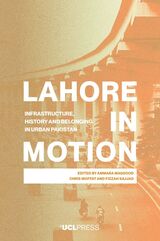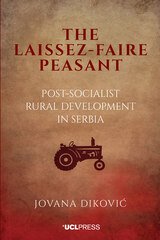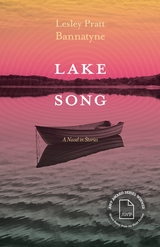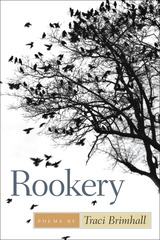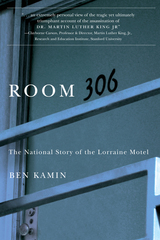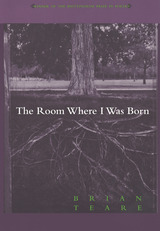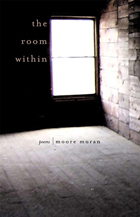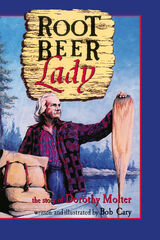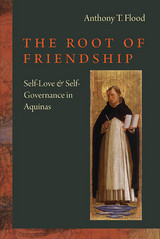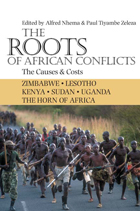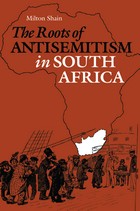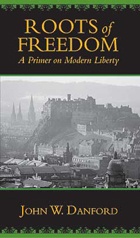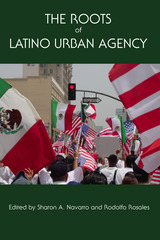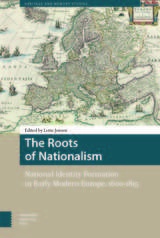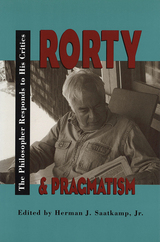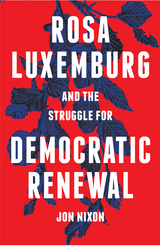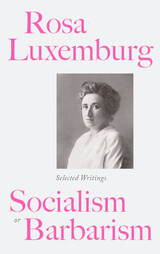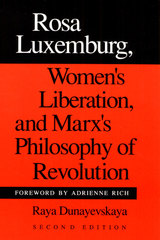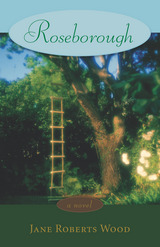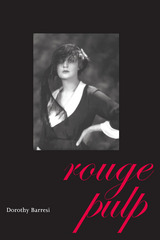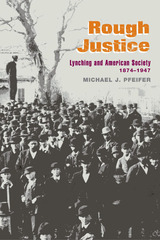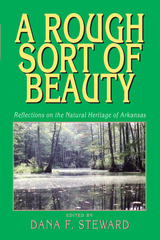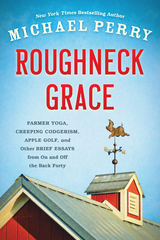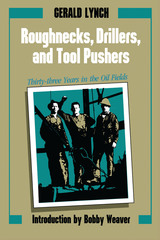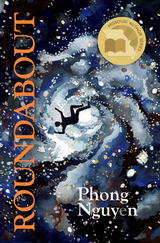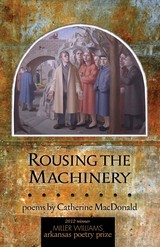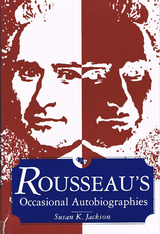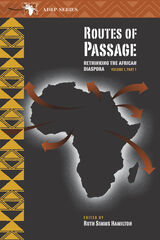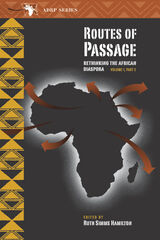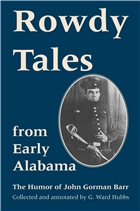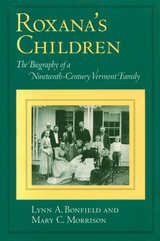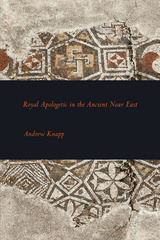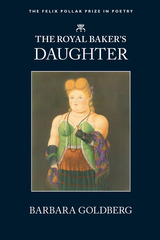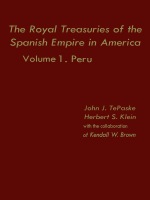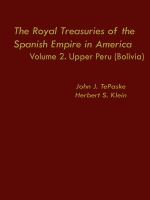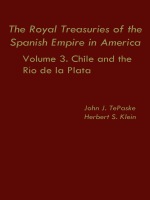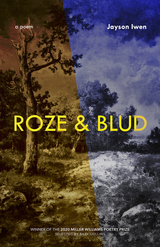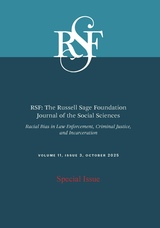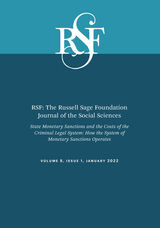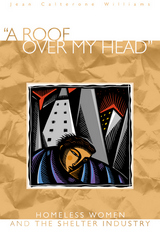 A Roof Over My Head: Homeless Women and the Shelter Industry
Jean Calterone Williams
University Press of Colorado, 2003 Based upon extensive ethnographic data, A Roof Over My Head examines the lives of homeless women who often care for children and live in small shelters and transitional living centers. Previous literature on homelessness has focused on those living literally on the streets or in large armory-style shelters. As William maintains, such studies often overlook those homeless women - many with children - who live in small shelters and transitional living centers.
The author draws upon interviews with homeless women, interviews with housed people, and, finally, evaluations of shelter services, philosophies, and policies to get at the causes and social construction of homelessness. A Roof Over My Head is a ground-breaking study that unveils the centrality of abuse and poverty in homeless women's lives and outlines ways in which societal responses can and should be more effective.
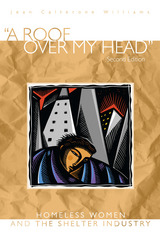 A Roof Over My Head, Second Edition: Homeless Women and the Shelter Industry
Jean Calterone Williams
University Press of Colorado, 2016 Based upon extensive ethnographic data, “A Roof Over My Head” examines the lives of homeless women who cope with domestic violence, low-income housing shortages, and poverty. The author draws upon interviews with homeless women, interviews with housed people, and, finally, evaluations of shelter services, philosophies, and policies to get at the causes and social constructions of homelessness. “A Roof Over My Head” is a groundbreaking study that unveils the centrality of abuse and poverty in homeless women’s lives and outlines ways in which societal responses can and should be more effective. The second edition explores recent attempts to integrate homeless and battered women’s shelters and recent research on domestic violence as a cause of homelessness. It contains a new introduction that analyzes the most recent homeless policy developments and paints a picture of the homeless population today. With updated statistics and policy information throughout, the second edition of “A Roof Over My Head” illustrates why ending homelessness in the United States continues to present a thorny and complex challenge.
Rookery
Traci Brimhall
Southern Illinois University Press, 2010 Traveling to the most intimate extremes of the human heart Fraught with madness, brutality, and ecstasy, Traci Brimhall’s Rookery delves into the darkest and most remote corners of the human experience. From the graveyards and battlefields of the Civil War to the ancient forests of Brazil, from desire to despair, landscapes both literal and emotional are traversed in this unforgettable collection of poems. Brimhall guides readers through ever-winding mazes of heartbreak and treachery, and the euphoric dreams of missionaries. The end of days, the intoxication of religion that at times borders on terror, and the post-evangelical experience intertwine with the haunting redemptions and metamorphoses found in violence. These tender yet ruthless poems, brimming with danger and longing, lure readers to “a place where everyone is transformed by suffering.”
Room 306: The National Story of the Lorraine Motel
Ben Kamin
Michigan State University Press, 2012 A tragic landmark in the civil rights movement, the Lorraine Motel in Memphis is best known for what occurred there on April 4, 1968. As he stood on the balcony of Room 306, Dr. Martin Luther King Jr. was assassinated, ending a golden age of nonviolent resistance, and sparking riots in more than one hundred cities. Formerly a seedy, segregated motel, and prior to that a brothel, the motel quickly achieved the status of national shrine. The motel attracts a variety of pilgrims—white politicians seeking photo ops, aging civil rights leaders, New Age musicians, and visitors to its current incarnation, the National Civil Rights Museum. A moving and emotional account that comprises a panorama of voices, Room 306 is an important oral history unlike any other.
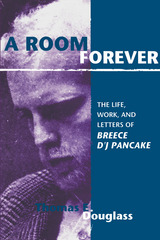 A Room Forever: The Life, Work, and Letters of Breece D'J Pancake
Thomas E. Douglass
University of Tennessee Press, 1998 After twenty-six-year-old author Breece D'J Pancake took his own life in April 1979, the West Virginian's posthumously published short-story collection made a considerable impact on the world of letters. His work was praised for a controlled muscular style reminiscent of Hemingway, for its strong undercurrent of emotion, and for its evocation of the blighted lives of the mountain poor. In A Room Forever, Thomas E. Douglass offers a detailed portrait of Pancake's short life, examining the varied circumstances and emotional forces that led to the writer's suicide and exploring Pancake's influence on contemporary fiction generally and Appalachian writing in particular.Drawing on notebooks, letters, and manuscripts left by Pancake as well as numerous conversations and interviews with family, friends, and others, Douglass has recreated the key events of the young artist's life: his West Virginia childhood, his romantic losses, his education as a writer at the University of Virginia, and the acceptance of his work by the East Coast literary establishment. Through analysis of the story fragments reproduced in this volume, including The Conqueror and Shouting Victory, Douglass illustrates the recurring themes -- such as fear of failure and the inability to escape disaster -- that Pancake expressed so eloquently in his work, and he shows their origins in the writer's own personal history. Douglass examines the degree to which Pancake drew on his memories of life in Appalachia and discusses Pancake's influence on other Appalachian writers such as Pinckney Benedict. Douglass argues that Pancake's posthumous collection, The Stories of Breece D'J Pancake, brought a renewed interest in regional writing to the national literary scene. A Room Forever brings to life the artistic sensibility and inner turmoil of a legendary figure in contemporary southern letters.
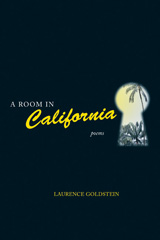 A Room in California
Laurence Goldstein
Northwestern University Press, 2005 Southern California is one of two significant places in Laurence Goldstein's fourth collection of poems. A native of Los Angeles, the author re-encounters the vivid ghosts of an exotic personal landscape: Criswell the TV prophet, Madame Nhu at the Beverly Wilshire Hotel, Mickey Cohen in a downtown deli, Bob Hope in a photo shoot with the poet's family. From the Pacific boardwalk to Death Valley, these poems enliven their borderlands with pungent language and dramatic incident. Goldstein then takes the reader to Ethiopia, the setting of a long dramatic monologue narrated by a young American woman seeking the reincarnation of the medieval Christian potentate Prester John, for help in the apocalyptic wars of the twenty-first century.
His most ambitious book to date, the subjects in this collection range from the aging pear tree and the domestic living room, to Nordic witches and Nazi demons. Some poems are in fixed forms including the villanelle "Rock Star," the sonnet translation from Verlaine, "Langueur," and the rhymed quatrains of a narrative poem adapted from a short story by Arthur Miller. Other poems employ organic style to explore the poet's situation, or predicament, in the culture he has outlived and the culture he has inherited.
 A Room of His Own: A Literary-Cultural Study of Victorian Clubland
Barbara Black
Ohio University Press In nineteenth-century London, a clubbable man was a fortunate man, indeed. The Reform, the Athenaeum, the Travellers, the Carlton, the United Service are just a few of the gentlemen’s clubs that formed the exclusive preserve known as “clubland” in Victorian London—the City of Clubs that arose during the Golden Age of Clubs. Why were these associations for men only such a powerful emergent institution in nineteenth-century London? Distinctly British, how did these single-sex clubs help fashion men, foster a culture of manliness, and assist in the project of nation-building? What can elite male affiliative culture tell us about nineteenth-century Britishness?
A Room of His Own sheds light on the mysterious ways of male associational culture as it examines such topics as fraternity, sophistication, nostalgia, social capital, celebrity, gossip, and male professionalism. The story of clubland (and the literature it generated) begins with Britain’s military heroes home from the Napoleonic campaign and quickly turns to Dickens’s and Thackeray’s acrimonious Garrick Club Affair. It takes us to Richard Burton’s curious Cannibal Club and Winston Churchill’s The Other Club; it goes underground to consider Uranian desire and Oscar Wilde’s clubbing and resurfaces to examine the problematics of belonging in Trollope’s novels. The trespass of French socialist Flora Tristan, who cross-dressed her way into the clubs of Pall Mall, provides a brief interlude. London’s clubland—this all-important room of his own—comes to life as Barbara Black explores the literary representations of clubland and the important social and cultural work that this urban site enacts. Our present-day culture of connectivity owes much to nineteenth-century sociability and Victorian networks; clubland reveals to us our own enduring desire to belong, to construct imagined communities, and to affiliate with like-minded comrades.
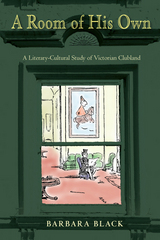 A Room of His Own: A Literary-Cultural Study of Victorian Clubland
Barbara Black
Ohio University Press, 2012 In nineteenth-century London, a clubbable man was a fortunate man, indeed. The Reform, the Athenaeum, the Travellers, the Carlton, the United Service are just a few of the gentlemen’s clubs that formed the exclusive preserve known as “clubland” in Victorian London—the City of Clubs that arose during the Golden Age of Clubs. Why were these associations for men only such a powerful emergent institution in nineteenth-century London? Distinctly British, how did these single-sex clubs help fashion men, foster a culture of manliness, and assist in the project of nation building? What can elite male affiliative culture tell us about nineteenth-century Britishness?
A Room of His Own sheds light on the mysterious ways of male associational culture as it examines such topics as fraternity, sophistication, nostalgia, social capital, celebrity, gossip, and male professionalism. The story of clubland (and the literature it generated) begins with Britain’s military heroes home from the Napoleonic campaign and quickly turns to Dickens’s and Thackeray’s acrimonious Garrick Club Affair. It takes us to Richard Burton’s curious Cannibal Club and Winston Churchill’s The Other Club; it goes underground to consider Uranian desire and Oscar Wilde’s clubbing and resurfaces to examine the problematics of belonging in Trollope’s novels. The trespass of French socialist Flora Tristan, who cross-dressed her way into the clubs of Pall Mall, provides a brief interlude. London’s clubland—this all-important room of his own—comes to life as Barbara Black explores the literary representations of clubland and the important social and cultural work that this urban site enacts. Our present-day culture of connectivity owes much to nineteenth-century sociability and Victorian networks; clubland reveals to us our own enduring desire to belong, to construct imagined communities, and to affiliate with like-minded comrades.
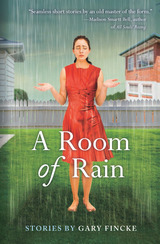 A Room of Rain
Gary Fincke
West Virginia University Press, 2015 The narratives throughout Gary Fincke’s sixth collection of short stories contain newsworthy events that are chronicled secondhand: the shooting of a policeman, the murder of a house flipper, the firing of a teacher for punching a violent student, the accidental drowning of a gay man in a flood, and a fire somewhat accidently set by a juvenile smoker in a school. Despite these surprising events, the narrator of each story is an ordinary person caught up in the action but preoccupied by other things, whether zombie movies, collecting unusual words, the oddity of other people’s sexual habits, or what to do in retirement. These shocking incidents become both central and peripheral to the narrative, as Fincke portrays the fluctuating emotions and self-protective reflections of fathers, sons, and husbands, creating a world where individuals rarely understand each other, yet still arrive at moments of compassion, tolerance, perseverance, and familial love.
Room Where I Was Born
Brian Teare
University of Wisconsin Press, 2003 An architecture equally poetry, fairy-tale, autobiography, and fiction, The Room Where I Was Born rebuilds the house of the lyric from fragments salvaged from experience and literature. Though the poems are borne out of the intersection of violence and sexuality, they also affirm the tenderness and compassion necessary to give consciousness and identity sufficient meaning. Its language the threshold over which the brutal crosses into the beautiful, this collection is an achievement of courage and vision.
The Room Within: Poems
Moore Moran
Ohio University Press, 2010 The Room Withinis a retrospective survey of a poetic career dating back to the late fifties. A student of Yvor Winters at Stanford, Moore Moran has deservedly earned a reputation, along with fellow Winters students Turner Cassity and Edgar Bowers, as a “poet’s poet.” He stands, though, not as a disciple, but as a poet who has earned his own voice over the decades, a voice at once familiar and haunting, down-to-earth and carefully wrought—a unique sensibility that emerges not full blown, but rather line by careful line.
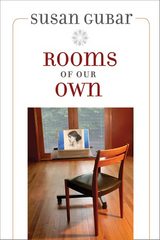 Rooms of Our Own
Susan Gubar
University of Illinois Press, 2006 With a little help from Virginia Woolf, Susan Gubar contemplates startling transformations produced by the women's movement in recent decades. What advances have women made and what still needs to be done? Taking Woolf's classic A Room of One's Own as her guide, Gubar engages these questions by recounting one year in the life of an English professor. A meditation on the teaching of literature and on the state of the humanities today, her chapters also provide a crash course on the challenges and changes in feminist intellectual history over the past several decades: the influence of post-structuralism and of critical race, postcolonial, and cultural studies scholarship; the stakes of queer theory and the institutionalization of women's studies; and the effects of globalism and bioengineering on conversations about gender, sex, and sexuality. Yet Rooms of Our Own eschews a scholarly approach. Instead, through narrative criticism it enlists a thoroughly contemporary cast of characters who tell us as much about the comedies and tragedies of campus life today as they do about the sometimes contentious but invariably liberating feminisms of our future.
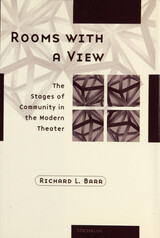 Rooms with a View: The Stages of Community in the Modern Theater
Richard L. Barr
University of Michigan Press, 1998 In Sam Shepard's play Action a character asks, "What's a community?" only to find that no one really knows. Rooms with a View attempts to chart the development of communal concepts through the discourse of dramatic modernism, defining a coherent pattern that illustrates and anticipates innovations in modern and postmodern social theory. To clarify the commonplace notion that audiences actively participate in dramatic art, the intro-ductory chapter theorizes a performance community, which audience, actors, and other backstage actants (such as playwrights and directors) provisionally form in the theater. Connecting psychological, sociological, and aesthetic insights ranging from Freud to Kohut, from Simmel to Nancy, and from Artaud and Brecht to Arnheim and Jellicoe, Richard Barr shows how modernist thinkers are repeatedly drawn to the ideal of communion. The distinctive structure of this collective inquiry helps untangle the roots and routes of modern drama and social thought. Barr analyzes the social and aesthetic theory of four in-fluential dramatists. Ibsen and Strindberg, he claims, explore ways of acknowledging the integrity of individual viewpoints while maintaining collective coherence. Pirandello and, in more radical ways, Beckett, conclude that conflict and division are not simply inevitable but invaluable in organizing alternative perspectives. By analyzing the ways playwrights variously conceive and achieve the complicated unity called community, Rooms with a View produces the rich paradox that difference may make the most difference in creative communal consensus. Richard L. Barr holds a Ph.D. from the University of Virginia, and has taught English at Rutgers University. He is currently a specialist in intersubjective relations, practicing in New Jersey and Switzerland.
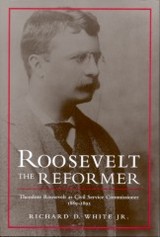 Roosevelt the Reformer: Theodore Roosevelt as Civil Service Commissioner, 1889-1895
Richard D. White Jr
University of Alabama Press, 2003 Covers a fascinating period of Theodore Roosevelt’s life, his first six years in Washington Roosevelt the Reformer sheds light on an important chapter in the biography of the flamboyant 26th president of the United States. From 1889 to 1895—before he was a Rough Rider in the Spanish–American War and before he oversaw the building of the Panama Canal and won the 1906 Nobel Peace Prize—“Teddy” Roosevelt served as one of three civil service commissioners. This was a significant period of his life because he matured politically and learned how to navigate through Washington politics. He sparred with powerful cabinet officers and congressmen and survived their attempts to destroy him. He cultivated important friendships and allegiances, flourished intellectually, and strengthened his progressive views of social justice, racial theory, and foreign relations. It was a period altogether significant to the honing of administrative talent and intellectual acuity of the future president. Richard White Jr. situates young Roosevelt within the exciting events of the Gilded Age, the Victorian era, and the gay nineties. He describes Roosevelt's relationships with family, friends, colleagues, and adversaries. Many of these people, such as Henry Cabot Lodge, Cecil Spring-Rice, Alfred Mahan, Henry Adams, and John Hay would significantly influence Roosevelt when he later occupied the White House. White explores TR's accomplishments in civil service reform, the effect of the commission experience on his presidency a decade later, and his administrative legacy. In addition to Harvard University’s immense collection of Roosevelt
correspondence, White drew from original sources such as the Civil Service Commission files in the National Archives, the Library of Congress, the National Park Service Roosevelt Historical Site at Sagamore Hill, and the records of the National Civil Service Reform League.
 Roosevelt’s Purge: How FDR Fought to Change the Democratic Party
Susan Dunn
Harvard University Press, 2012 In his first term in office, Franklin Roosevelt helped pull the nation out of the Great Depression with his landmark programs. In November 1936, every state except Maine and Vermont voted enthusiastically for his reelection. But then the political winds shifted. Not only did the Supreme Court block some of his transformational experiments, but he also faced serious opposition within his own party. Conservative Democrats such as Senators Walter George of Georgia and Millard Tydings of Maryland allied themselves with Republicans to vote down New Deal bills.
Susan Dunn tells the dramatic story of FDR’s unprecedented battle to drive his foes out of his party by intervening in Democratic primaries and backing liberal challengers to conservative incumbents. Reporters branded his tactic a “purge”—and the inflammatory label stuck. Roosevelt spent the summer months of 1938 campaigning across the country, defending his progressive policies and lashing out at conservatives. Despite his efforts, the Democrats took a beating in the midterm elections.
The purge stemmed not only from FDR’s commitment to the New Deal but also from his conviction that the nation needed two responsible political parties, one liberal, the other conservative. Although the purge failed, at great political cost to the president, it heralded the realignment of political parties that would take place in the 1960s, 1970s, and 1980s. By the end of the century, the irreconcilable tensions within the Democratic Party had exploded, and the once solidly Democratic South was solid no more. It had taken sixty years to resolve the tangled problems to which FDR devoted one frantic, memorable summer.
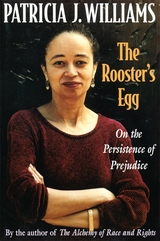 The Rooster’s Egg
Patricia J. Williams
Harvard University Press, 1995 “Jamaica is the land where the rooster lays an egg…When a Jamaican is born of a black woman and some English or Scotsman, the black mother is literally and figuratively kept out of sight as far as possible, but no one is allowed to forget that white father, however questionable the circumstances of birth…You get the impression that these virile Englishmen do not require women to reproduce. They just come out to Jamaica, scratch out a nest and lay eggs that hatch out into ‘pink’ Jamaicans.”
—Zora Neale Hurston
We may no longer issue scarlet letters, but from the way we talk, we might as well: W for welfare, S for single, B for black, CC for children having children, WT for white trash. To a culture speaking with barely masked hysteria, in which branding is done with words and those branded are outcasts, this book brings a voice of reason and a warm reminder of the decency and mutual respect that are missing from so much of our public debate. Patricia J. Williams, whose acclaimed book The Alchemy of Race and Rights offered a vision for healing the ailing spirit of the law, here broadens her focus to address the wounds in America’s public soul, the sense of community that rhetoric so subtly but surely makes and unmakes.
In these pages we encounter figures and images plucked from headlines—from Tonya Harding to Lani Guinier, Rush Limbaugh to Hillary Clinton, Clarence Thomas to Dan Quayle—and see how their portrayal, encoding certain stereotypes, often reveals more about us than about them. What are we really talking about when we talk about welfare mothers, for instance? Why is calling someone a “redneck” okay, and what does that say about our society? When young women appear on Phil Donahue to represent themselves as Jewish American Princesses, what else are they doing? These are among the questions Williams considers as she uncovers the shifting, often covert rules of conversation that determine who “we” are as a nation.
Root Beer Lady: The Story Of Dorothy Molter
Bob Cary
University of Minnesota Press, 2002 An ice-cold glass of root beer and a warm welcome greeted thousands of weary paddlers who stopped at the Isle of Pines to meet Dorothy Molter, the courageous, independent woman who became a North Woods legend. Bob Cary, Dorothy’s longtime friend, captures her life and spirit in Root Beer Lady.
The Root of Friendship
Anthony T. Flood
Catholic University of America Press, 2014 The Root of Friendship addresses the connections between self-love and self-governance in the thought of St. Thomas Aquinas and defends three related theses. First, Aquinas's account of proper self-love is a description of the nature and importance of a person's subjective self- experience. Second, his notion of self-governance cannot be understood fully unless we grasp its basis in self-love. Finally, his account both satisfies contemporary conditions of relevance for self-governance and offers attractive solutions to issues raised in analytic discussions on such matters.
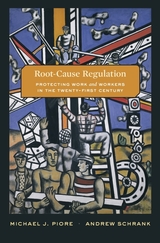 Root-Cause Regulation: Protecting Work and Workers in the Twenty-First Century
Michael J. Piore and Andrew Schrank
Harvard University Press, 2018 Work is now more deadly than war, killing approximately 2.3 million people a year worldwide. The United States, with its complex regulatory system, has one of the highest rates of occupational fatality in the developed world, and deteriorating working conditions more generally. Why, after a century of reform, are U.S. workers growing less safe and secure? Comparing U.S. regulatory practices to their European and Latin American counterparts, Root-Cause Regulation provides insight into the causes of this downward trend and ways to reverse it, offering lessons for rich and poor countries alike.
The United States assigns responsibility for wages and hours, collective bargaining, occupational safety, and the like to various regulatory agencies. In France, Spain, and their former colonies, a single agency regulates all firms. Drawing on history, sociology, and economics, Michael Piore and Andrew Schrank examine why these systems developed differently and how they have adapted to changing conditions over time. The U.S. model was designed for the inspection of mass production enterprises by inflexible specialists and is ill-suited to the decentralized and destabilized employment of today. In the Franco-Iberian system, by contrast, the holistic perspective of multitasking generalists illuminates the root causes of noncompliance—which often lie in outdated techniques and technologies—and offers flexibility to tailor enforcement to different firms and market conditions.
The organization of regulatory agencies thus represents a powerful tool. Getting it right, the authors argue, makes regulation not the job-killer of neoliberal theory but a generative force for both workers and employers.
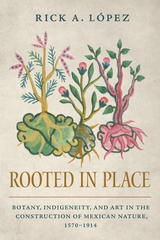 Rooted in Place: Botany, Indigeneity, and Art in the Construction of Mexican Nature, 1570–1914
Rick A. López
University of Arizona Press, 2025 Since the first moment of conquest, colonizers and the colonized alike in Mexico confronted questions about what it meant to be from this place, what natural resources it offered, and who had the right to control those resources and on what basis.
Focusing on the ways people, environment, and policies have been affected by political boundaries, historian Rick A. López explores the historical connections between political identities and the natural world. López analyzes how scientific intellectuals laid claim to nature within Mexico, first on behalf of the Spanish Empire and then in the name of the republic, during three transformative moments: the Hernández expedition of the late sixteenth century; the Royal Botanical Expedition of the late eighteenth century; and the heyday of scientific societies such as the Sociedad Mexicana de Historia Natural of the late nineteenth century.
This work traces how scientific intellectuals studied and debated what it meant to know and claim the flora that sprang from Mexican soil—ranging from individual plants to forests and vegetated landscapes—and the importance they placed on indigeneity. It also points to the short- and long-term consequences of these efforts. López draws on archival and published sources produced from the sixteenth century through the start of the twentieth century and gives special attention to the use of visual images such as scientific illustrations and landscape art. López employs the term “visualization” in recognition of the degree to which officials, botanists, and draftsmen produced imagery and also how they and others viewed nature.
Rooted in Place reveals how scientific endeavors were not just about cataloging flora but were deeply intertwined with the construction of identity and the political landscape at three pivotal moments in Mexican history.
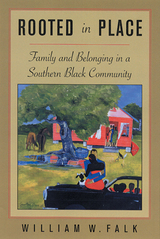 Rooted in Place: Family and Belongings in a Southern Black Community
Falk, William W
Rutgers University Press, 2004 Throughout the twentieth century, millions of African Americans, many from impoverished, historically black counties, left the South to pursue what they thought would be a better life in the North. But not everyone moved away during what scholars have termed the Great Migration. What has life been like for those who stayed? Why would they remain in a place that many outsiders would see as grim, depressed, economically marginal, and where racial prejudice continues to place them at a disadvantage?
Through oral history William Falk tells the story of an extended family in the Georgia-South Carolina lowcountry. Family members talk about schooling, relatives, work, religion, race, and their love of the place where they have lived for generations. This “conversational ethnography” argues that an interconnection between race and place in the area helps explain African Americans’ loyalty to it. In Colonial County, blacks historically enjoyed a numerical majority as well as deep cultural roots and longstanding webs of social connections that, Falk finds, more than outweigh the racism they face and the economic disadvantages they suffer.
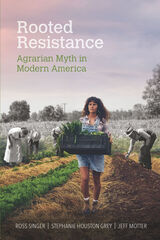 Rooted Resistance: Agrarian Myth in Modern America
Norie R. Singer
University of Arkansas Press, 2020 From farm-to-table restaurants and farmers markets, to support for fair trade and food sovereignty, movements for food-system change hold the promise for deeper transformations. Yet Americans continue to live the paradox of caring passionately about healthy eating while demanding the convenience of fast food. Rooted Resistance explores this fraught but promising food scene. More than a retelling of the origin story of a democracy born from an intimate connection with the land, this book wagers that socially responsible agrarian mythmaking should be a vital part of a food ethic of resistance if we are to rectify the destructive tendencies in our contemporary food system.
Through a careful examination of several case studies, Rooted Resistance traverses the ground of agrarian myth in modern America. The authors investigate key figures and movements in the history of modern agrarianism, including the World War I victory garden efforts, the postwar Country Life movement for the vindication of farmers’ rights, the Southern Agrarian critique of industrialism, and the practical and spiritual prophecy of organic farming put forth by J. I. Rodale. This critical history is then brought up to date with recent examples such as the contested South Central Farm in urban Los Angeles and the spectacular rise and fall of the Chipotle “Food with Integrity” branding campaign.
By examining a range of case studies, Singer, Grey, and Motter aim for a deeper critical understanding of the many applications of agrarian myth and reveal why it can help provide a pathway for positive systemic change in the food system.
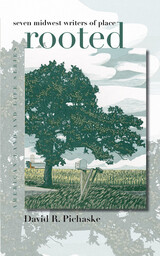 Rooted: Seven Midwest Writers of Place
David R. Pichaske
University of Iowa Press, 2006 David Pichaske has been writing and teaching about midwestern literature for three decades. In Rooted, by paying close attention to text, landscape, and biography, he examines the relationship between place and art. His focus is on seven midwestern authors who came of age toward the close of the twentieth century, their lives and their work grounded in distinct places: Dave Etter in small-town upstate Illinois; Norbert Blei in Door County, Wisconsin; William Kloefkorn in southern Kansas and Nebraska; Bill Holm in Minneota, Minnesota; Linda Hasselstrom in Hermosa, South Dakota; Jim Heynen in Sioux County, Iowa; and Jim Harrison in upper Michigan. The writers' intimate knowledge of place is reflected in their use of details of geography, language, environment, and behavior. Yet each writer reaches toward other geographies and into other dimensions of art or thought: jazz music and formalism in the case of Etter; gender issues in the case of Hasselstrom; time past and present in the case of Kloefkorn; ethnicity and the role of the artist in the case of Blei; magical realism in the case of Heynen; the landscape of literature in the case of Holm; and the curious worlds of academia, best-selling novels, and Hollywood films in the case of Harrison. The result, Pichaske notes, is the growing away from roots, the explorations and alter egos of these writers of place, and the tension between the “here” and “there” that gives each writer's art the complexity it needs to transcend provincial boundaries. Quoting generously from the writers, Pichaske employs a practical, jargon-free literary analysis fixed in the text, making Rooted interesting, readable, and especially useful in treating the literary categories of memoir and literary essay that have become important in recent decades.
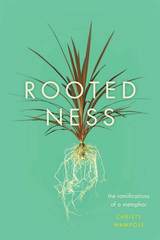 Rootedness: The Ramifications of a Metaphor
Christy Wampole
University of Chicago Press, 2016 People have long imagined themselves as rooted creatures, bound to the earth—and nations—from which they came. In Rootedness, Christy Wampole looks toward philosophy, ecology, literature, history, and politics to demonstrate how the metaphor of the root—surfacing often in an unexpected variety of places, from the family tree to folk etymology to the language of exile—developed in twentieth-century Europe.
Wampole examines both the philosophical implications of this metaphor and its political evolution. From the root as home to the root as genealogical origin to the root as the past itself, rootedness has survived in part through its ability to subsume other compelling metaphors, such as the foundation, the source, and the seed. With a focus on this concept’s history in France and Germany, Wampole traces its influence in diverse areas such as the search for the mystical origins of words, land worship, and nationalist rhetoric, including the disturbing portrayal of the Jews as an unrooted, and thus unrighteous, people. Exploring the works of Martin Heidegger, Simone Weil, Jean-Paul Sartre, Paul Celan, and many more, Rootedness is a groundbreaking study of a figure of speech that has had wide-reaching—and at times dire—political and social consequences.
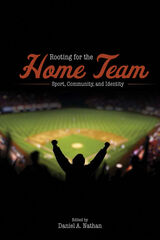 Rooting for the Home Team
Edited by Daniel A. Nathan
University of Illinois Press, 2013 Rooting for the Home Team examines how various American communities create and maintain a sense of collective identity through sports. Looking at large cities such as Chicago, Baltimore, and Los Angeles as well as small rural towns, suburbs, and college towns, the contributors consider the idea that rooting for local athletes and home teams often symbolizes a community's preferred understanding of itself, and that doing so is an expression of connectedness, public pride and pleasure, and personal identity. Some of the wide-ranging essays point out that financial interests also play a significant role in encouraging fan bases, and modern media have made every seasonal sport into yearlong obsessions. Celebrities show up for big games, politicians throw out first pitches, and taxpayers pay plenty for new stadiums and arenas. The essays in Rooting for the Home Team cover a range of professional and amateur athletics, including teams in basketball, football, baseball, and even the phenomenon of no-glove softball. Contributors are Amy Bass, Susan Cahn, Mark Dyreson, Michael Ezra, Elliott J. Gorn, Christopher Lamberti, Allison Lauterbach, Catherine M. Lewis, Shelley Lucas, Daniel A. Nathan, Michael Oriard, Carlo Rotella, Jaime Schultz, Mike Tanier, David K. Wiggins, and David W. Zang.
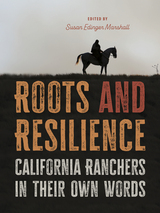 Roots and Resilience: California Ranchers in Their Own Words
Susan Edinger Marshall
University of Nevada Press, 2024 In Roots and Resilience, the authors invite readers to consider an intimate relationship with the California landscape and its history. Ranching in the region goes back centuries, and many of these essayists have long family lineages in the area, while other contributors are newer to the region. Through their authentic voices, these writers provide a lens through which we can better understand the language of this landscape.
The editors have drawn together these stories, poems, and musings from ranchers across the state, calling upon real people to share their experiences, and beckoning readers to find a shared understanding concerning often divisive land-use topics. Many perspectives are considered, including those of transplanted suburbanites to seventh-generation heirs. Notably, many women’s writings are including in the book, offering unique and valuable perspectives on ranching culture.
Roots and Resilience gives voice to California’s Indigenous, Mexican American, Basque and other European American ranchers, asking the reader to find common ground in the name of land stewardship and conservation.
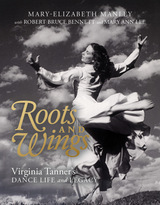 Roots and Wings: Virginia Tanner's Dance Life and Legacy
Mary-Elizabeth Manley with Mary Ann Lee and Robert Bruce Bennett
University of Utah Press, 2023 Roots and Wings recounts Virginia Tanner’s remarkable career as a dancer, artist, and educator. From her early experiences assisting at Evelyn Davis’s dance school in Washington, DC, to the creation of the Tanner Dance Program at the University of Utah, her influence on the field was pervasive. She channeled children’s energy, sharpened their senses, and encouraged youthful, authentic dance expression.
Manley’s extensive archival research and personal interviews depict Virginia Tanner as an innovative dance artist and ambitious leader in the field of modern dance. While exploring Tanner’s story, Roots and Wings emphasizes the value of unique instructional methodologies for teaching dance to young children and the vital role the arts play in children’s lives. Tanner’s work endures, continuing to echo with sensitivity and spirit in young dancers throughout the United States and abroad.
 Roots Music in America: Collected Writings of Joe Wilson
Fred Bartenstein
University of Tennessee Press, 2017 “Joe Wilson represented a deep diversity in American vernacular music and culture. He directed the National Folk Festival and roots music tours, engaging government support for traditional communities. Joe combined Appalachian wisdom with searching intellect to create original brilliance. ‘America’s foremost hillbilly intellectual,’ laughed at my sobriquet and worked tirelessly for the music and people he loved.”
—Nick Spitzer, American Routes
Joe Wilson served for twenty-eight years as executive director of the National Folk Festival and National Council for Traditional Arts. Throughout his impressive career, Wilson wrote extensively and colorfully about many facets of vernacular music in North America, including works on major folk instruments, as well as on characteristic musical styles, especially old-time, bluegrass, modern country, blues, cowboy, a cappella gospel, and others. This volume, a companion to Lucky Joe’s Namesake: The Extraordinary Life and Observations of Joe Wilson, compiles Wilson’s best writings on musical topics, including some previously unpublished works.
With wry humor, Wilson covers the origins of roots music in eighteenth-century America and its subsequent dispersion through races, classes, ethnic groups, and newly settled regions. Wilson knew, worked with, and wrote about many iconic artists of the twentieth century, including Willie Nelson, Doc Watson, Clarence Ashley, the Stanley Brothers, Kenny Baker, Cephas & Wiggins, John Jackson, and members of the Hill Billies—the band whose name came to signify an entire genre of the earliest recorded roots music. This carefully curated volume is comprised of works previously scattered in liner notes, small-circulation magazines, tour booklets, and unpublished manuscripts, all collected here and organized by theme.
The writings of this legendary, internationally recognized figure will be indispensable to roots music fans and will delight readers and students interested in the traditional arts and dedicated to preserving historic folkways.
Fred Bartenstein teaches country and bluegrass music history at the University of Dayton. He is the editor of Bluegrass Bluesman: Josh Graves, a Memoir and coauthor and editor of The Bluegrass Hall of Fame: Inductee Biographies, 1991–2014.
The Roots of African Conflicts: The Causes and Costs
Alfred Nhema
Ohio University Press, 2007 “Africa is no more prone to violent conflicts than other regions. Indeed, Africa’s share of the more than 180 million people who died from conflicts and atrocities in the twentieth century is relatively modest.… This is not to underestimate the immense impact of violent conflicts on Africa; it is merely to emphasize the need for more balanced debate and commentary.”
—From the introduction by Paul Tiyambe Zeleza
Violent conflicts have exacted a heavy toll on Africa’s societies, polities, and economies. This book presents African scholars’ views of why conflicts start in their continent. The causes of conflict are too often examined by scholars from the countries that run the proxy wars and sell the arms to fuel them. This volume offers theoretically sophisticated, empirically grounded, and compelling analyses of the roots of African conflicts.
 The Roots of American Bureaucracy, 1830–1900
William E. Nelson
Harvard University Press, 1982 William Nelson reinterprets nineteenth-century American history as a struggle between majority rule and minority rights. From this fresh point of view, he traces the roots of American bureaucracy.
Nelson analyzes the majority–minority tension form the Jacksonian revolution of strong party rule and majoritarian decisionmaking through the abolitionist crisis, the Civil War, Reconstruction, and the rise of industrialism. He shows that ultimately political and legal pluralism emerged to protect minority and individual rights. The instrument of a professional bureaucracy with neutral political standards was fashioned. Personalities as seemingly disparate as Henry Adams, John W. Burgess, Charles W. Eliot, Christopher Columbus Langdell, and Theodore Roosevelt all contributed in an effort to stop the centralizing impact of democracy.
Nelson’s new way of thinking about the period puts into different perspective the actions of the three branches of federal government, its courts and administrative agencies, and even the states. All shifted toward bureaucratic or neutral standards, reliance on experts, and professionalization. Legal thought changed from an instrumental to a formal reasoning style, civil service tamped down partisan politics, and in Congress, seniority and the committee system check democratic tendencies.
Roots Of American Order
Russell Kirk
Intercollegiate Studies Institute, 2003 What holds America together? In this classic work, Russell Kirk identifies the beliefs and institutions that have nurtured the American soul and commonwealth. Beginning with the Hebrew prophets, Kirk examines in dramatic fashion the sources of American order. His analytical narrative might be called a "tale of five cities": Jerusalem, Athens, Rome, London, and Philadelphia.
For an understanding of the significance of America in the twenty-first century, Russell Kirk's masterpiece on the history of American civilization is unsurpassed.
 Roots of Brazil
Sérgio Buarque de Holanda
University of Notre Dame Press, 2012
Sérgio Buarque de Holanda's Roots of Brazil is one of the iconic books on Brazilian history, society, and culture. Originally published in 1936, it appears here for the first time in an English language translation with a foreword, "Why Read Roots of Brazil Today?" by Pedro Meira Monteiro, one of the world's leading experts on Buarque de Holanda.
Roots of Brazil focuses on the multiple cultural influences that forged twentieth-century Brazil, especially those of the Portuguese, the Spanish, other European colonists, Native Americans, and Africans. Buarque de Holanda argues that all of these originary influences were transformed into a unique Brazilian culture and society—a "transition zone." The book presents an understanding of why and how European culture flourished in a large, tropical environment that was totally foreign to its traditions, and the manner and consequences of this development. Buarque de Holanda uses Max Weber’s typological criteria to establish pairs of "ideal types" as a means of stressing particular characteristics of Brazilians, while also trying to understand and explain the local historical process. Along with other early twentieth-century works such as The Masters and the Slaves by Gilberto Freyre and The Colonial Background of Modern Brazil by Caio Prado Júnior, Roots of Brazil set the parameters of Brazilian historiography for a generation and continues to offer keys to understanding the complex history of Brazil.
Roots of Brazil has been published in Italian, Spanish, Japanese, Chinese, German, and French. This long-awaited English translation will interest students and scholars of Portuguese, Brazilian, and Latin American history, culture, literature, and postcolonial studies.
"Roots of Brazil, first published in 1936 and substantially revised in subsequent editions, is one of those works that shapes its readers' imagination, a book that in a certain sense 'invents' its country, serving as a mirror in which, while seeking their own image, Brazilian readers have also found their own attitudes and inclinations. On the other hand, Sérgio Buarque de Holanda's book functions not only as a fixed portrait that preserves a scene from the past but also as a bright surface that can reflect each new historical moment." —from the foreword by Pedro Meira Monteiro, Princeton University
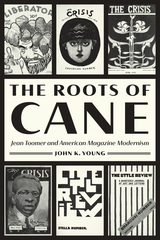 The Roots of Cane: Jean Toomer and American Magazine Modernism
John K. Young
University of Iowa Press, 2024 The Roots of Cane proposes a new way to read one of the most significant works of the New Negro Renaissance, Jean Toomer’s Cane. Rather than focusing on the form of the book published by Boni and Liveright, what Toomer would later call a single textual “organism,” John Young traces the many pieces of Cane that were dispersed across multiple modernist magazines from 1922 through 1923. These periodicals ranged from primarily political monthlies to avant-garde arts journals to regional magazines with transnational aspirations.
Young interweaves a periodical-studies approach to modernism with book history and critical race theory, resituating Toomer’s uneasy place within Black modernism by asking how original readers would have encountered his work. The different contexts in which those audiences were engaging with Toomer’s portraits of racialized identity in the Jim Crow United States, yield often surprising results.
 Roots of Disorder: Race and Criminal Justice in the American South, 1817-80
Christopher Waldrep
University of Illinois Press, 1998 Every white southerner understoodwhat keeping African Americans "down" meant and what it did not mean. It did not mean going to court; it did not mean relying on the law. It meant vigilante violence and lynching. Looking at Vicksburg, Mississippi,Roots of Disorder traces the origins of these terrible attitudes to the day-to-day operations of local courts. In Vicksburg, white exploitation of black labor through slavery evolved into efforts to use the law todefine blacks' place in society, setting the stage for widespread tolerance of brutal vigilantism. Fed by racism and economics, whites' violence grew in a hothouse of more general hostility toward law and courts. Roots of Disorder shows how the criminal justice system itself plays a role in shaping the attitudes that encourage vigilantism.
"Delivers what no other study has yet attempted. . . . Waldrep's book is one of the first systematically to use local trial data to explore questions of society and culture." -- Vernon Burton, author of "A Gentleman and an Officer": A Social and Military History of James B. Griffin's Civil War
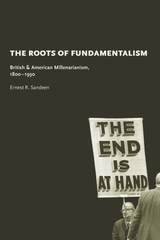 The Roots of Fundamentalism: British and American Millenarianism, 1800-1930
Ernest R. Sandeen
University of Chicago Press, 1970 Ernest Sandeen’s Roots of Fundamentalism remains a landmark work in the history of religion. A National Book Award finalist, it was the first full-length study to present an intellectual historical critique of the Fundamentalist movement in America. Sandeen argues that our understanding of this movement has been grievously distorted by the Fundamentalist-Modernist debate of the 1920s, as symbolized by William Jennings Bryan and the Scopes trial. Rather than viewing Fundamentalism as a chiefly sociological phenomenon of the 1920s, Sandeen argues from a transatlantic perspective that the Fundamentalist movement “was a self-conscious, structured, long-lived dynamic entity” that had its origins in Anglo-American millenarian thought and movements of the nineteenth century.
"All historians need to face the issues [this book] raises. Serious theological discussion of Fundamentalism tends to be neglected because it is intellectually unfashionable: Mr. Sandeen shows that for the historian such neglect is a luxury he cannot afford.”—David M. Thompson, English Historical Review “Sandeen’s ‘new approach to Fundamentalism’ eschews the common tendency to see the movement as parochially American, rurally based, and essentially a phenomenon of the twenties. . . . It is a highly valuable addition to American and—more singularly—to comparative theological history.”—William R. Hutchinson, Journal of American History
 The Roots of Modern Hollywood: The Persistence of Values in American Cinema, from the New Deal to the Present
Nick Smedley
Intellect Books, 2014 In this insightful study of Hollywood cinema since 1969, film historian Nick Smedley traces the cultural and intellectual heritage of American films, showing how the more thoughtful recent cinema owes a profound debt to Hollywood’s traditions of liberalism, first articulated in the New Deal era. Although American cinema is not usually thought of as politically or socially engaged, Smedley demonstrates how Hollywood can be seen as one of the most value-laden of all national cinemas. Drawing on a long historical view of the persistent trends and themes in Hollywood cinema, Smedley illustrates how films from recent decades have continued to explore the balance between unbridled individualistic capitalism and a more socially engaged liberalism. He also brings out the persistence of pacifism in Hollywood’s consideration of American foreign policy in Vietnam and the Middle East. His third theme concerns the treatment of women in Hollywood films, and the belated acceptance by the film community of a wider role for the American post-feminist woman. Featuring important new interviews with four of Hollywood’s most influential directors—Michael Mann, Peter Weir, Tony Gilroy, and Paul Haggis—The Roots of Modern Hollywood is an incisive account of where Hollywood is today and the path it has taken to get there.
 Roots of Modern Mormonism
Mark P. Leone
Harvard University Press, 1979 Mark Leone comes to new conclusions about the evolution of Mormonism, both as a self-sufficient religious sect and as a movement within the broader context of American history. Applying the tools of anthropology for the first time to this subject, he identifies the features that have allowed an outcast utopia of the nineteenth century to achieve worldwide success in the twentieth.
The author explores the ways in which a minority survives in a hostileenvironment, both physical and cultural. He focuses especially on theMormon settlements of eastern Arizona, whose rich records reveal inmicrocosm the workings of a modern theocracy. The early Mormon radicalism emerges as an appropriateresponse to contemporary conditions. With the shift of Mormonismfrom independence to colonial statusat the turn of the century, Mormonideas begin their transformation toconservatism, again illustrating theflexibility that is a key to thereligion's stunning success.
Leone's broad range ofsources, including diaries, nativehistories, judicial records, and correspondence, gives a full picture ofMormon life and history. He has alsodone extensive ethnographic fieldwork in the Mormon settlementsalong the Little Colorado River, so asto be able to describe the movementin its own terms.
The Roots of Nationalism: National Identity Formation in Early Modern Europe, 1600-1815
Edited by Lotte Jensen
Amsterdam University Press, 2016 This collection brings together scholars from a wide range of disciplines to offer perspectives on national identity formation in various European contexts between 1600 and 1815. Contributors challenge the dichotomy between modernists and traditionalists in nationalism studies through an emphasis on continuity rather than ruptures in the shaping of European nations in the period, while also offering an overview of current debates in the field and case studies on a number of topics, including literature, historiography, and cartography.
 Roots of Our Renewal: Ethnobotany and Cherokee Environmental Governance
Clint Carroll
University of Minnesota Press, 2015 Honorable Mention: Labriola Center American Indian National Book Award
In Roots of Our Renewal, Clint Carroll tells how Cherokee people have developed material, spiritual, and political ties with the lands they have inhabited since removal from their homelands in the southeastern United States. Although the forced relocation of the late 1830s had devastating consequences for Cherokee society, Carroll shows that the reconstituted Cherokee Nation west of the Mississippi eventually cultivated a special connection to the new land—a connection that is reflected in its management of natural resources. Until now, scant attention has been paid to the interplay between tribal natural resource management programs and governance models. Carroll is particularly interested in indigenous environmental governance along the continuum of resource-based and relationship-based practices and relates how the Cherokee Nation, while protecting tribal lands, is also incorporating associations with the nonhuman world. Carroll describes how the work of an elders’ advisory group has been instrumental to this goal since its formation in 2008. An enrolled citizen of the Cherokee Nation, Carroll draws from his ethnographic observations of Cherokee government–community partnerships during the past ten years. He argues that indigenous appropriations of modern state forms can articulate alternative ways of interacting with and “governing” the environment.
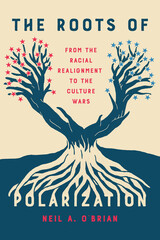 The Roots of Polarization: From the Racial Realignment to the Culture Wars
Neil A. O'Brian
University of Chicago Press, 2024 A deeply researched account of how battles over civil rights in the 1960s shaped today’s partisan culture wars. In the late twentieth century, gay rights, immigration, gun control, and abortion debates all burst onto the political scene, scrambling the parties and polarizing the electorate. Neil A. O’Brian traces the origins of today’s political divide on these issues to the 1960s when Democrats and Republicans split over civil rights. It was this partisan polarization over race, he argues, that subsequently shaped partisan fault lines on other culture war issues that persist to this day. Using public opinion data dating to the 1930s, O’Brian shows that attitudes about civil rights were already linked with a range of other culture war beliefs decades before the parties split on these issues—and much earlier than previous scholarship realized. Challenging a common understanding of partisan polarization as an elite-led phenomenon, The Roots of Polarization argues politicians and interest groups, jockeying for power in the changing party system, seized on these preexisting connections in the mass public to build the parties’ contemporary coalitions.
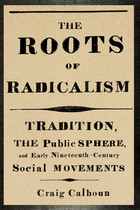 The Roots of Radicalism: Tradition, the Public Sphere, and Early Nineteenth-Century Social Movements
Craig Calhoun
University of Chicago Press, 2012 The story of the rise of radicalism in the early nineteenth century has often been simplified into a fable about progressive social change. The diverse social movements of the era—religious, political, regional, national, antislavery, and protemperance—are presented as mere strands in a unified tapestry of labor and democratic mobilization. Taking aim at this flawed view of radicalism as simply the extreme end of a single dimension of progress, Craig Calhoun emphasizes the coexistence of different kinds of radicalism, their tensions, and their implications. The Roots of Radicalism reveals the importance of radicalism’s links to preindustrial culture and attachments to place and local communities, as well the ways in which journalists who had been pushed out of “respectable” politics connected to artisans and other workers. Calhoun shows how much public recognition mattered to radical movements and how religious, cultural, and directly political—as well as economic—concerns motivated people to join up. Reflecting two decades of research into social movement theory and the history of protest, The Roots of Radicalism offers compelling insights into the past that can tell us much about the present, from American right-wing populism to democratic upheavals in North Africa.
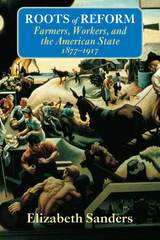 Roots of Reform: Farmers, Workers, and the American State, 1877-1917
Elizabeth Sanders
University of Chicago Press, 1999 Roots of Reform offers a sweeping revision of our understanding of the rise of the regulatory state in the late nineteenth century. Sanders argues that politically mobilized farmers were the driving force behind most of the legislation that increased national control over private economic power. She demonstrates that farmers from the South, Midwest, and West reached out to the urban laborers who shared their class position and their principal antagonist—northeastern monopolistic industrial and financial capital—despite weak electoral support from organized labor.
Based on new evidence from legislative records and other sources, Sanders shows that this tenuous alliance of "producers versus plutocrats" shaped early regulatory legislation, remained powerful through the populist and progressive eras, and developed a characteristic method of democratic state expansion with continued relevance for subsequent reform movements.
Roots of Reform is essential reading for anyone interested in this crucial period of American political development.
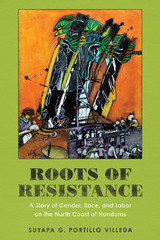 Roots of Resistance: A Story of Gender, Race, and Labor on the North Coast of Honduras
Suyapa G. Portillo Villeda
University of Texas Press, 2021 Winner of the 2021 Sara A. Whaley Prize of the National Women’s Studies Association (NWSA)
A first-of-its-kind study of the working-class culture of resistance on the Honduran North Coast and the radical organizing that challenged US capital and foreign intervention at the onset of the Cold War, examining gender, race, and place. On May 1, 1954, striking banana workers on the North Coast of Honduras brought the regional economy to a standstill, invigorating the Honduran labor movement and placing a series of demands on the US-controlled banana industry. Their actions ultimately galvanized a broader working-class struggle and reawakened long-suppressed leftist ideals. The first account of its kind in English, Roots of Resistance explores contemporary Honduran labor history through the story of the great banana strike of 1954 and centers the role of women in the narrative of the labor movement. Drawing on extensive firsthand oral history and archival research, Suyapa G. Portillo Villeda examines the radical organizing that challenged US capital and foreign intervention in Honduras at the onset of the Cold War. She reveals the everyday acts of resistance that laid the groundwork for the 1954 strike and argues that these often-overlooked forms of resistance should inform analyses of present-day labor and community organizing. Roots of Resistance highlights the complexities of transnational company hierarchies, gender and race relations, and labor organizing that led to the banana workers' strike and how these dynamics continue to reverberate in Honduras today.
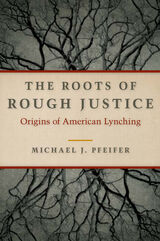 The Roots of Rough Justice: Origins of American Lynching
Michael J. Pfeifer
University of Illinois Press, 2014 In this deeply researched prequel to his 2006 study Rough Justice: Lynching and American Society, 1874–1947, Michael J. Pfeifer analyzes the foundations of lynching in American social history. Scrutinizing the vigilante movements and lynching violence that occurred in the middle decades of the nineteenth century on the Southern, Midwestern, and far Western frontiers, The Roots of Rough Justice: Origins of American Lynching offers new insights into collective violence in the pre-Civil War era. Pfeifer examines the antecedents of American lynching in an early modern Anglo-European folk and legal heritage. He addresses the transformation of ideas and practices of social ordering, law, and collective violence in the American colonies, the early American Republic, and especially the decades before and immediately after the American Civil War. His trenchant and concise analysis anchors the first book to consider the crucial emergence of the practice of lynching of slaves in antebellum America. Pfeifer also leads the way in analyzing the history of American lynching in a global context, from the early modern British Atlantic to the legal status of collective violence in contemporary Latin America and sub-Saharan Africa. Seamlessly melding source material with apt historical examples, The Roots of Rough Justice tackles the emergence of not only the rhetoric surrounding lynching, but its practice and ideology. Arguing that the origins of lynching cannot be restricted to any particular region, Pfeifer shows how the national and transatlantic context is essential for understanding how whites used mob violence to enforce the racial and class hierarchies across the United States.
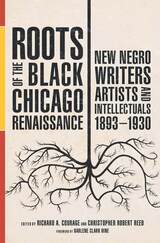 Roots of the Black Chicago Renaissance: New Negro Writers, Artists, and Intellectuals, 1893-1930
Edited by Richard A. Courage and Christopher Robert Reed
University of Illinois Press, 2020 The Black Chicago Renaissance emerged from a foundational stage that stretched from the 1893 World's Columbian Exposition to the start of the Great Depression. During this time, African American innovators working across the landscape of the arts set the stage for an intellectual flowering that redefined black cultural life. Richard A. Courage and Christopher Robert Reed have brought together essays that explore the intersections in the backgrounds, education, professional affiliations, and public lives and achievements of black writers, journalists, visual artists, dance instructors, and other creators working in the late nineteenth and early twentieth centuries. Organized chronologically, the chapters unearth transformative forces that supported the emergence of individuals and social networks dedicated to work in arts and letters. The result is an illuminating scholarly collaboration that remaps African American intellectual and cultural geography and reframes the concept of urban black renaissance. Contributors: Richard A. Courage, Mary Jo Deegan, Brenda Ellis Fredericks, James C. Hall, Bonnie Claudia Harrison, Darlene Clark Hine, John McCluskey Jr., Amy M. Mooney, Christopher Robert Reed, Clovis E. Semmes, Margaret Rose Vendryes, and Richard Yarborough
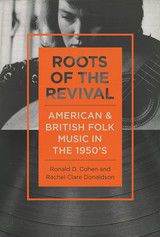 Roots of the Revival: American and British Folk Music in the 1950s
Ronald D. Cohen and Rachel Clare Donaldson
University of Illinois Press, 2014 In Roots of the Revival: American and British Folk Music in the 1950s, Ronald D. Cohen and Rachel Clare Donaldson present a transatlantic history of folk's midcentury resurgence that juxtaposes the related but distinct revivals that took place in the United States and Great Britain.
After setting the stage with the work of music collectors in the nineteenth century, the authors explore the so-called recovery of folk music practices and performers by Alan Lomax and others, including journeys to and within the British Isles that allowed artists and folk music advocates to absorb native forms and facilitate the music's transatlantic exchange. Cohen and Donaldson place the musical and cultural connections of the twin revivals within the decade's social and musical milieu and grapple with the performers' leftist political agendas and artistic challenges, including the fierce debates over "authenticity" in practice and repertoire that erupted when artists like Harry Belafonte and the Kingston Trio carried folk into the popular music mainstream.
From work songs to skiffle, from the Weavers in Greenwich Village to Burl Ives on the BBC, Roots of the Revival offers a frank and wide-ranging consideration of a time, a movement, and a transformative period in American and British pop culture.
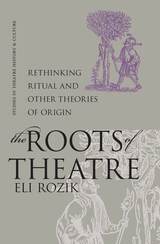 The Roots of Theatre: Rethinking Ritual and Other Theories of Origin
Eli Rozik
University of Iowa Press, 2002 The topic of the origins of theatre is one of the most controversial in theatre studies, with a long history of heated discussions and strongly held positions. In The Roots of Theatre, Eli Rozik enters the debate in a feisty way, offering not just another challenge to those who place theatre’s origins in ritual and religion but also an alternative theory of roots based on the cultural and psychological conditions that made the advent of theatre possible. Rozik grounds his study in a comprehensive review and criticism of each of the leading historical and anthropological theories. He believes that the quest for origins is essentially misleading because it does not provide any significant insight for our understanding of theatre. Instead, he argues that theatre, like music or dance, is a sui generis kind of human creativity—a form of thinking and communication whose roots lie in the spontaneous image-making faculty of the human psyche. Rozik’s broad approach to research lies within the boundaries of structuralism and semiotics, but he also utilizes additional disciplines such as psychoanalysis, neurology, sociology, play and game theory, science of religion, mythology, poetics, philosophy of language, and linguistics. In seeking the roots of theatre, what he ultimately defines is something substantial about the nature of creative thought—a rudimentary system of imagistic thinking and communication that lies in the set of biological, primitive, and infantile phenomena such as daydreaming, imaginative play, children’s drawing, imitation, mockery (caricature, parody), storytelling, and mythmaking.
The Roots of Things: Essays
Maxine Kumin
Northwestern University Press, 2010 Throughout her career, Pulitzer Prize–winning poet Maxine Kumin has been at the vanguard of discussions about feminism and sexism, the state of poetry, and our place in the natural world. The Roots of Things gathers into one volume her best essays on the issues that have been closest to her throughout her storied career. Divided into sections on "Taking Root," "Poets and Poetry," and "Country Living," these pieces reveal Kumin honing her views within a variety of forms, including speeches, critical essays, and introductions of other writers’ work. Whether she is recollecting scenes from her childhood, ruminating on the ups and downs of what she calls "pobiz" (for "poetry business"), describing the battles she’s fought on behalf of women, or illuminating the lives of animals, Kumin offers insight that can only be born of long and closely observed experience.
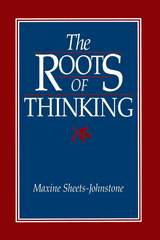 The Roots Of Thinking
Maxine Sheets-Johnstone
Temple University Press, 1990 "A significant contribution to the study of early humans, this book is a philosophical anthropology.... it makes genuinely novel, and highly persuasive, claims within the field itself."
--David Depew
In this ground-breaking interdisciplinary study about conceptual origins, Maxine Sheets-Johnstone shows that there is an indissoluble bond between hominid thinking and hominid evolution, a bond cemented by the living body. Her thesis is concretely illustrated in eight paleoanthropological case studies ranging from tool-using/tool-making to counting, sexuality, representation, language, death, and cave art. In each case, evidence is brought forward that shows how thinking is modeled on the body-specifically, how concepts are generated by animate form and the tactile-kinesthetic experience.
Later chapters critically examine key theoretical and methodological issues posed by the thesis, Sheets-Johnstone demonstrates in detail how and why a corporeal turn in philosophy and the human sciences can yield insights no less extraordinary than those produced by the linguistic turn. In confronting the currently popular doctrine of cultural relativism and the classic Western metaphysical dualism of mind and body, she shows how pan-cultural invariants of human bodily life have been discounted and how the body itself has not been given its due. By a precise exposition of how a full-scale hermeneutics and a genetic phenomenology may be carried out with respect to conceptual origins, she shows how methodological issues are successfully resolved.
"Ranging across the humanities and sciences, this thoroughly original book challenges both traditional metaphysics and contemporary cultural relativism. In their place, it persuasively develops a phenomenonological, tactile-kinesthetic account of the origins of thinking. This philosophical anthropology could not be more timely. It replaces the 'linguistic turn' with a promising new 'corporeal turn.'"
--John J. Stuhr, University of Oregon
"This work takes a much-needed stand in the inter-disciplinary field of philosophical anthropology. Sheets-Johnstone is well-read in the history of philosophy and in contemporary anthropology. The point of view she offers is inventive, insightful, well-established, and fruitful."
--Thomas M. Alexander, Southern Illinois University at Carbondale
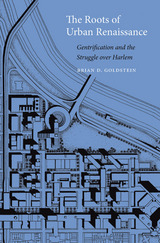 The Roots of Urban Renaissance: Gentrification and the Struggle over Harlem
Brian D. Goldstein
Harvard University Press, 2017 Displaying gleaming new shopping centers and refurbished row houses, Harlem today bears little resemblance to the neighborhood of the midcentury urban crisis. Brian Goldstein traces Harlem’s widely noted “Second Renaissance” to a surprising source: the radical 1960s social movements that resisted city officials and fought to give Harlemites control of their own destiny.
In the post–World War II era, large-scale government-backed redevelopment drove the economic and physical transformation of urban neighborhoods. But in the 1960s, young Harlem activists inspired by the civil rights movement recognized urban renewal as one more example of a power structure that gave black Americans little voice in the decisions that most affected them. They demanded the right to plan their own redevelopment and founded new community-based organizations to achieve that goal. In the following decades, those organizations became the crucibles in which Harlemites debated what their streets should look like and who should inhabit them. Radical activists envisioned a Harlem built by and for its low-income, predominantly African-American population.
In the succeeding decades, however, community-based organizations came to pursue a very different goal: a neighborhood with national retailers and increasingly affluent residents. In charting the history that transformed Harlem by the twenty-first century, The Roots of Urban Renaissance demonstrates that gentrification was not imposed on an unwitting community by unscrupulous developers or opportunistic outsiders. Rather, it grew from the neighborhood’s grassroots, producing a legacy that benefited some longtime residents and threatened others.
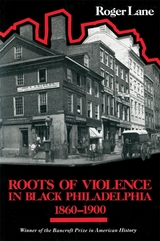 Roots of Violence in Black Philadelphia, 1860–1900
Roger Lane
Harvard University Press, 1986 In the late nineteenth century, life became more stable and orderly for most American city dwellers, but not for blacks. Roger Lane offers a historical explanation for the rising levels of black urban crime and family instability during this paradoxical era. Philadelphia serves as test case because of the richness of the data: Du Bois’s classic study, The Philadelphia Negro, newspapers, records of the criminal justice system and other local agencies, and the federal census. The author presents numerical details, along with many examples of the human stories—social and political—behind the statistics.
Lane reveals how social and economic discrimination created a black criminal subculture. This subculture, overlooked by those histories depending on often inaccurate census materials, eroded family patterns, encouraged violence, discouraged efforts at middle-class respectability, and intensified employment problems by adding white fear to the white prejudice that had helped to create it.
Modern crime rates and patterns are shown to be products of a historical culture that can be traced from its formative years to the 1980s. Lane not only charts Philadelphia’s story but also makes suggestions regarding national and international patterns.
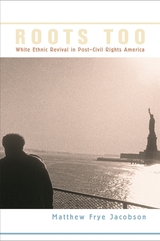 Roots Too: White Ethnic Revival in Post–Civil Rights America
Matthew Frye Jacobson
Harvard University Press, 2006 In the 1950s, America was seen as a vast melting pot in which white ethnic affiliations were on the wane and a common American identity was the norm. Yet by the 1970s, these white ethnics mobilized around a new version of the epic tale of plucky immigrants making their way in the New World through the sweat of their brow. Although this turn to ethnicity was for many an individual search for familial and psychological identity, Roots Too establishes a broader white social and political consensus arising in response to the political language of the Civil Rights and Black Power movements.
In the wake of the Civil Rights movement, whites sought renewed status in the romance of Old World travails and New World fortunes. Ellis Island replaced Plymouth Rock as the touchstone of American nationalism. The entire culture embraced the myth of the indomitable white ethnics—who they were and where they had come from—in literature, film, theater, art, music, and scholarship. The language and symbols of hardworking, self-reliant, and ultimately triumphant European immigrants have exerted tremendous force on political movements and public policy debates from affirmative action to contemporary immigration.
In order to understand how white primacy in American life survived the withering heat of the Civil Rights movement and multiculturalism, Matthew Frye Jacobson argues for a full exploration of the meaning of the white ethnic revival and the uneasy relationship between inclusion and exclusion that it has engendered in our conceptions of national belonging.
 Rope and Faggot: A Biography of Judge Lynch
Walter White
University of Notre Dame Press, 2002 In 1926, Walter White, assistant secretary of the National Association for the Advancement of Colored People, broke the story of a horrific lynching in Aiken, South Carolina, in which three African Americans were murdered while more than one thousand spectators watched. Because of his light complexion, blonde hair, and blue eyes, White, an African American, was able to investigate first-hand more than forty lynchings and eight race riots.
Following the lynchings in Aiken, White took a leave of absence from the NAACP and, with help from a Guggenheim grant, spent a year in France writing Rope and Faggot. Ironically subtitled “A Biography of Judge Lynch,” Rope and Faggot is a compelling example of partisan scholarship and is based on White's first-hand investigations. It was first published in 1929. Rope and Faggot debunked the "big lie" that lynching punished black men for raping white women and it provided White with an opportunity to deliver a penetrating critique of the southern culture that nourished this form of blood sport. White marshaled statistics demonstrating that accusations of rape or attempted rape accounted for less than 30 percent of all lynchings. Despite the emphasis on sexual issues in instances of lynching, White insisted that the fury and sadism with which white mobs attacked their victims stemmed primarily from a desire to keep blacks in their place and control the black labor force. Some of the strongest sections of Rope and Faggot deal with White's analysis of the economic and cultural foundations of lynching.
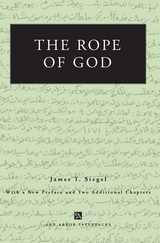 The Rope of God
James T. Siegel
University of Michigan Press, 2000 The Acehnese, a Muslim people of Sumatra, fought Dutch attempts to colonize them for forty years. After its "pacification," Acehnese society evolved peacefully, yet nonetheless the Acehnese participated fully in the Indonesian revolution and in a rebellion against the Indonesian central government not long after. Based on field work done in the early 1960s, James Siegel's The Rope of God, traces the evolution in Islam, in the economy, and in the structure of the family to show how it was that Aceh mobilized itself as a society from the time of the colonial war to the emergence of the republic. At a time when this Indonesian society is once again in movement, this influential study has gained a certain new relevance.
To bridge this span of time since its initial publication in 1969, Siegel has added two additional chapters to his original volume: one a description of political elements today and the other a previously published piece on Acehnese domestic politics.
Important when it first appeared, The Rope of God continues to be of enduring importance today and will be warmly welcomed back into print.
James Siegel is Professor of Anthropology and Asian Studies, Cornell University and is the author of New Criminal Type in Jakarta: A Counter-Revolution Today, among other books.
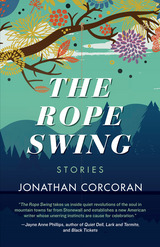 The Rope Swing: Stories
Jonathan Corcoran
West Virginia University Press, 2016 A once-booming West Virginia rail town no longer has a working train. The residents left behind in this tiny hamlet look to the mountains that surround them on all sides: The outside world encroaches, and the buildings of the gilded past seem to crumble more every day. These are the stories of outsiders—the down and out. What happens to the young boy whose burgeoning sexuality pushes him to the edge of the forest to explore what might be love with another boy? What happens when one lost soul finally makes it to New York City, yet the reminders of his past life are omnipresent? What happens when an old woman struggles to find a purpose and reinvent herself after decades of living in the shadow of her platonic life partner? What happens to those who dare to live their lives outside of the strict confines of the town’s traditional and regimented ways? The characters in The Rope Swing—gay and straight alike—yearn for that which seems so close but impossibly far, the world over the jagged peaks of the mountains.
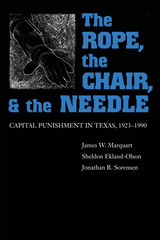 The Rope, The Chair, and the Needle: Capital Punishment in Texas, 1923-1990
By James W. Marquart, Sheldon Ekland-Olson, and Jonathan R. Sorensen
University of Texas Press, 1998 In late summer 1923, legal hangings in Texas came to an end, and the electric chair replaced the gallows. Of 520 convicted capital offenders sentenced to die between 1923 and 1972, 361 were actually executed, thus maintaining Texas’ traditional reputation as a staunch supporter of capital punishment. This book is the single most comprehensive examination to date of capital punishment in any one state, drawing on data for legal executions from 1819 to 1990. The authors show persuasively how slavery and the racially biased practice of lynching in Texas led to the institutionalization and public approval of executions skewed according to race, class, and gender, and they also track long-term changes in public opinion up to the present. The stories of the condemned are masterfully interwoven with fact and interpretation to provide compelling reading for scholars of law, criminal justice, race relations, history, and sociology, as well as partisans on both sides of the debate.
Rorty and Pragmatism: The Philosopher Responds to His Critics
Herman Saatkamp
Vanderbilt University Press, 1995 A penetrating and illuminating exchange of views between Richard Rorty, a highly influential and sometimes controversial philosopher, and seven of his most thoughtful critics, providing new insights into the impact of his work on contemporary American philosophy.
Richard Rorty, William R. Kenan Professor and University Professor of Humanities at the University of Virginia, is a frequent and influential contributor to major literary magazines and professional journals in this country and abroad. Among his best-known book publications are The Linguistic Turn (1967 and 1992), Philosophy and the Mirror of Nature (1979), The Consequences of Pragmatism (1982), and Contingency, Irony and Solidarity (1989).
 Rosa Bonheur: The Artist's (Auto)biography
Anna Klumpke
University of Michigan Press, 2001 Hailed by her contemporaries as the most popular animal-painter, male or female, of the nineteenth century, the French artist Rosa Bonheur (1822-99) lived to see her name become a household word. In a century that did its best to keep women "in their place," Bonheur, like George Sand--to whom she was often compared--defined herself outside of the social and legal codes of her time. To the horror and bewilderment of many, she earned her own money, managed her own property, wore trousers, hunted, smoked, and lived in retreat with female companions in a little chateau near Fountainebleau named The Domain of Perfect Affection.
Rosa Bonheur: The Artist's (Auto)Biography brings this extraordinary woman to life in a unique blend of biography and autobiography. Coupling her own memories with Bonheur's first-person account, Anna Klumpke, a young American artist who was Bonheur's lover and chosen portraitist, recounts how she came to meet and fall in love with Bonheur. Bonheur's account of her own life story, set nicely within Klumpke's narrative, sheds light on such topics as gender formation, institutional changes in the art world, governmental intervention in the arts, the social and legal regulation of dress codes, and the perceived transgressive nature of female sexual companionship in a repressive society, all with the distinctive flavor of Bonheur's artistic personality.
Gretchen van Slyke's translation provides a rare glimpse into the unconventional life of this famous French painter, and renders accessible for the first time in English this public statement of Bonheur's artistic credo. More importantly, whether judged by her century's standards (or perhaps even our own), it details a story of lesbian love that is bold, unconventional, and courageous.
"The remarkable life of Rosa Bonheur, one of the most highly decorated artists and certainly the best known female artist of her time in nineteenth-century France, is long overdue for further scrutiny." --Therese Dolan, Temple University
Gretchen van Slyke is Associate Professor of French, University of Vermont.
Rosa Luxemburg and the Struggle for Democratic Renewal
Jon Nixon
Pluto Press, 2018 Revolutionary Marxist activist Rosa Luxemburg (1871–1919) has long been a major inspiration for activists on the left. But what can we learn from looking closely at her life today? Jon Nixon answers that question here, offering a clear, concise account of Luxemburg’s biography and thought and setting it in relation to contemporary economic, political, and social debates. Nixon presents Luxemburg as not only an activist, but also as a major political theorist, showing how her thinking about global capitalism, state militarism, and other subjects can still be applied today, with powerful effects. By establishing a rich and distinctive account of Luxemburg, Nixon makes a compelling argument for the continuing relevance of her struggle for democratic renewal.
Rosa Luxemburg: Socialism or Barbarism: Selected Writings
Rosa Luxemburg
Pluto Press, 2010 Rosa Luxemburg (1871-1919) was one of the most brilliant and passionate minds drawn to the revolutionary socialist movement. An outstanding social and economic theorist of the twentieth century, and a dedicated political activist, she proved willing to go to prison and even give her life for her beliefs.
Providing an extensive overview of her writings, this volume contains a number of items never before anthologised. Her work was broad in scope tackling capitalism and socialism; globalisation and imperialism; history; war and peace; social struggles, trade unions, political parties; class, gender, race; the interconnection of humanity with the natural environment. The editors provide an extensive and informative introduction outlining and evaluating her life and thought.
This is the most comprehensive introduction to the range of Rosa Luxemburg’s thought.
Rosa Luxemburg, Women's Liberation, and Marx's Philosophy of Revolution
Raya Dunayevskaya
University of Illinois Press, 1991 In this important and wide-ranging critique of Rosa Luxemburg (1871-1919) Raya Dunayevskaya examines the life, political thought, and action of one of the most critical revolutionary figures of our time. Dunayevskaya sheds new light on the questions of socialist democracy after the revolution, disclosing both the unprobed feminist dimension of Rosa Luxemburg and the previously unrecognized new moments in Marx's last decade concerning the role of women and the peasantry. As the founder of Marxist-Humanism in the United States, Dunayevskaya (1910-87) was an internationally respected writer, philosopher, and revolutionary. This new and expanded edition includes two previously unpublished articles by Dunayevskaya, including her "Challenge to all Post-Marx Marxists."
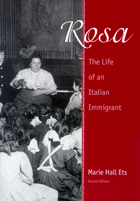 Rosa: The Life of an Italian Immigrant
Marie Hall Ets
University of Wisconsin Press, 1999 This is the life story of Rosa Cavalleri, an Italian woman who came to the United States in 1884, one of the peak years in the nineteenth-century wave of immigration. A vivid, richly detailed account, the narrative traces Rosa’s life in an Italian peasant village and later in Chicago. Marie Hall Ets, a social worker and friend of Rosa’s at the Chicago Commons settlement house during the years following World War I, meticulously wrote down her lively stories to create this book.
Rosa was born in a silk-making village in Lombardy, a major source of north Italian emigration; she first set foot in the United States at the Castle Garden immigrant depot on the tip of Manhattan. Her life in this country was hard and Ets chronicles it in eloquent detail—Rosa endures a marriage at sixteen to an abusive older man, an unwilling migration to a Missouri mining town, and the unassisted birth of a child, and manages to escape from a husband who tried to force her into prostitution. Rosa’s exuberant personality, remarkable spirit, and ability as a storyteller distinguish this book, a unique contribution to the annals of U.S. immigration.
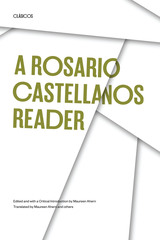 A Rosario Castellanos Reader: An Anthology of Her Poetry, Short Fiction, Essays, and Drama
By Rosario Castellanos
University of Texas Press, 1988 Thinker, writer, diplomat, feminist Rosario Castellanos was emerging as one of Mexico's major literary figures before her untimely death in 1974. This sampler of her work brings together her major poems, short fiction, essays, and a three-act play, The Eternal Feminine. Translated with fidelity to language and cultural nuance, many of these works appear here in English for the first time, allowing English-speaking readers to see the depth and range of Castellanos' work. In her introductory essay, "Reading Rosario Castellanos: Contexts, Voices, and Signs," Maureen Ahern presents the first comprehensive study of Castellanos' work as a sign or signifying system. This approach through contemporary semiotic theory unites literary criticism and translation as an integral semiotic process. Ahern reveals how Castellanos integrated women's images, bodies, voices, and texts to feminize her discourse and create a plurality of new signs/messages about women in Mexico. Describing this process in The Eternal Feminine, Castellanos observes, "...it's not good enough to imitate the models proposed for us that are answers to circumstances other than our own. It isn't even enough to discover who we are. We have to invent ourselves."
Rosarium: Poems
Hannah Dow
Acre Books, 2018 Hannah Dow’s debut poetry collection, Rosarium, is a series of beautiful interrogations. In precise, luminous language, Dow engages the mysteries of faith as a catalyst for meditations on the contradictory human condition—our knot of body and spirit. These poems engage the inexplicable, attempting to articulate the tension between doubt and a longing for certainty, between belief in the potency of language and acceptance of its failures. Yet these lyrics never evaporate into abstraction. They pulse with the particular. Postcards that read as prayers (spoken without hope of response) lead us around the corporeal world through vastly different landscapes—from Mississippi, to California, to Europe, to the Middle East—showing how place shapes us, how the mind cannot escape the body.
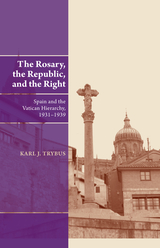 The Rosary, the Republic and the Right: Spain & the Vatican Hierarchy, 1931-1939
Karl J. Trybus
Sussex Academic Press, 2022 The birth of the Second Spanish Republic in April 1931 ushered in a period of possible secularisation to Spain. Liberals welcomed legal changes, while conservatives feared the special 'privileges' they enjoyed would end. The Catholic Church remained a central focus of left-wing antagonism and right-wing allegiances, and conflicts surrounding the future of religion grew severe. While members of the Spanish Catholic hierarchy had clearly supported the right and disdained the left, the actions and opinions of the Vatican and its hierarchy stationed in Spain were much more nuanced. Similarly, when conservative military action plunged Spain into a Civil War in July 1936, the majority of the Spanish Catholic hierarchy openly supported their victory, but the highest levels of the Vatican remained silent. This book explores the unique position and specialised reactions of the Vatican concerning the Second Republic and Civil War. For the Holy See, the conflict in Spain was not an isolated event at the edge of the continent, but part of a larger narrative of ideological and political tension swirling across Europe. Any public statement by the Vatican concerning the Spanish Republic or Civil War could be misconstrued as support for one side or another, and threaten the Church. True, the Vatican often remained silent -- and some have suggested this supports the conclusion that the Church worked for Franco -- but by accessing previously unavailable sources directly from the Vatican, this book can help to clarify the difficult options that awaited the Holy See during this disastrous period. Similarly, this book works to highlight the fact that the Catholic Church was not some monolithic entity, but men like Pope Pius XI and Secretary of State Pacelli had their own understandings of spirituality and politics.
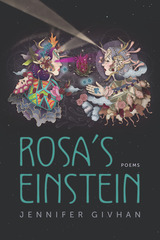 Rosa's Einstein: Poems
Jennifer Givhan
University of Arizona Press, 2019 Rosa’s Einstein is a Latinx retelling of the Brothers Grimm’s Snow-White and Rose-Red, reevaluating border, identity, and immigration narratives through the unlikely amalgamation of physics and fairy tale.
In this full-length poetry collection, the girls of Rosa’s Einstein embark on a quest to discover what is real and what is possible in the realms of imagination, spurred on by scientific curiosity and emotional resilience. Following a structural narrative arc inspired by the archetypal hero’s journey, sisters Rosa and Nieve descend into the desert borderlands of New Mexico to find resolution and healing through a bold and fearless examination of the past, meeting ghostly helpers and hinderers along the way. These metaphorical spirits take the shape of circus performers, scientists, and Lieserl, the lost daughter Albert Einstein gave away.
Poet Jennifer Givhan reimagines the life of Lieserl, weaving her search for her scientist father with Rosa and Nieve’s own search for theirs. Using details both from Einstein’s known life and from quantum physics, Givhan imagines Lieserl in a circus-like landscape of childhood trauma and survival, guided by Rosa and Nieve.
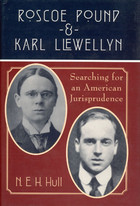 Roscoe Pound and Karl Llewellyn: Searching for an American Jurisprudence
N. E. H. Hull
University of Chicago Press, 1997 American legal history is traditionally viewed as a series of schools of thought or landmark court decisions, not as the work of individuals. Here, N. E. H. Hull tells the pivotal story of American jurisprudence through two of its most influential shapers: Karl Llewellyn, father of legal realism, poet, and mercurial romantic, and Roscoe Pound, iron-willed leader of sociological jurisprudence. These theorists adapted the legal profession to the changing needs of twentieth-century America.
Through meticulous archival research, Hull shows how the intellectual battles of the day took place against a network of private and public relationships and demonstrates how Pound's and Llewellyn's ideas of jurisprudence sprang from a kind of intellectual bricolage, the pragmatic assemblage of parts rather than the development of a unified whole, that is peculiarly American. Humorous, engaging, and provocative, Roscoe Pound and Karl Llewellyn uncovers the roots of American jurisprudence in the lives of two of its most compelling figures.
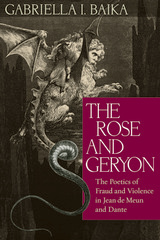 The Rose and Geryon
Gabriella I. Baika
Catholic University of America Press, 2014 The Rose and Geryon examines patterns of verbal behavior in works by Jean de Meun and Dante (with a focus on the Romance of the Rose and the Divine Comedy) in relationship with the most influential systems of verbal sins in the Middle Ages, systems elaborated by William Peraldus, Thomas Aquinas, Domenico Cavalca, and Laurent of Orléans. The book begins with a presentation of these four systems, and from there proceeds to analyze Jean de Meun's Testament as a possible source of influence for the Divine Comedy and take a closer look at Dante's prose works in search for a comprehensive theory of sinful speech. Furthermore Baika discusses verbal transgressions such as flattery, evil counsel, double talk, sowing of discord, and falsifying of words, under the heading Lingua dolosa "The Guileful Tongue," and the relationship between violence and the poetic discourse. The myriad ways in which the two iconic poets of medieval France and Italy absorb the tradition of peccata linguae in their works prove that abusive speech was not the exclusive sphere of interest of the ecclesiastical writers; secular poetry in the vernacular enriched in original ways the medieval debate on verbal vices. The Rose and Geryon addresses scholars and students of French and Italian literatures, as well as readers interested in ethics and women's studies.
Roseborough
Jane Roberts Wood
University of North Texas Press, 2003
 Rosebud Sleds and Horses' Heads: 50 of Film's Most Evocative Objects - An Illustrated Journey
Scott Jordan Harris
Intellect Books, 2013 Dorothy’s ruby slippers. Michael Myers’s mask. Marilyn Monroe’s billowy white dress. Indiana Jones’s trusty hat. These objects are icons of popular culture synonymous with the films they appear in, and, at long last, a book has come along that sorts and chronicles fifty of them.
Rosebud Sleds and Horses’ Heads presents incisive discussion of fifty of the most significant objects in cinema history and explores their importance within their films and within the popular imagination. With original full color illustrations, this book surveys objects from a range of genres, from the birth of cinema to the present day.
Curated and written by a prominent film critic who routinely writes for some of the leading publications in the English language, as well as broadcasts for the BBC, Rosebud Sleds and Horses’ Heads is the only book of its kind. With a fascinating, original, and instantly understandable concept, it will find grateful audiences in film buffs around the world.
The Rose's Kiss: A Natural History of Flowers
Peter Bernhardt
University of Chicago Press, 2002 "An engaging botanical overview of flowers."-New York Times Book Review
In The Rose's Kiss, Peter Bernhardt presents a fascinating and wide-ranging look at the natural history of flowers—how they look, what they do, and their often hidden interactions with the surrounding environment and other living organisms upon which they depend for their survival. You'll discover why flowers are so colorful, how they evolved, and how insects exploit them for their nectar. This is a book for all flower lovers, from naturalists and gardeners to poets and botanists.
 The Rose's Kiss: A Natural History Of Flowers
Peter Bernhardt
Island Press, 1999 Flowers bring joy and beauty to our lives, from the smallest patch of daisies outside our window to the elaborate floral decorations on display at weddings, banquets, and funerals. As well as offering aesthetic benefits, they teach us much about how the world works -- each blossom is a living factory that manufactures organs and compounds ranging from the flavonoids that make a rose red to the pollen that gives us hayfever.In The Rose's Kiss, botanist Peter Bernhardt rekindles our sense of wonder at the plant life all around us. He presents a fascinating and wide ranging look at the natural history of flowers -- their forms and functions as well as their hidden interactions with the surrounding environment and the other living organisms they depend upon for survival. Using both familiar and exotic examples, he examines: flower architecture, including the wonderfully descriptive names of floral parts and their respective roles in a plant's life-cycle the secret exchange between a bud and its environment that determines blooming time and the lifespan of individual blossoms colors, scents, and other mechanisms that plants use to attract pollinators and keep them returning season after season the incredible diversity of organisms that pollinate plants -- cockroaches, flies, moths, parrots, hummingbirds, bats, and others extinct plants and their fossil blossoms, showing the evolution of flowering plants over the past 125 million years and much moreDelightfully interwoven with intriguing facts and stories from history, folklore, and mythology, The Rose's Kiss is a wonderful example of literary science writing at its best. It should hold wide appeal for nature lovers, garden enthusiasts, and anyone interested in learning more about the inner workings of the natural world.
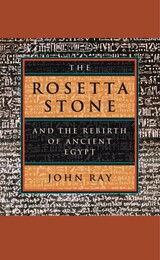 The Rosetta Stone and the Rebirth of Ancient Egypt
John Ray
Harvard University Press, 2007 The Rosetta Stone is one of the world’s great wonders, attracting awed pilgrims by the tens of thousands each year. This book tells the Stone’s story, from its discovery by Napoleon’s expedition to Egypt to its current—and controversial—status as the single most visited object on display in the British Museum.
A pharaoh’s forgotten decree, cut in granite in three scripts—Egyptian hieroglyphs, Egyptian demotic, and ancient Greek—the Rosetta Stone promised to unlock the door to the language of ancient Egypt and its 3,000 years of civilization, if only it could be deciphered. Capturing the drama of the race to decode this key to the ancient past, John Ray traces the paths pursued by the British polymath Thomas Young and Jean-François Champollion, the “father of Egyptology” ultimately credited with deciphering Egyptian hieroglyphs. He shows how Champollion “broke the code” and explains more generally how such deciphering is done, as well as its critical role in the history of Egyptology. Concluding with a chapter on the political and cultural controversy surrounding the Stone, the book also includes an appendix with a full translation of the Stone’s text.
Rich in anecdote and curious lore, The Rosetta Stone and the Rebirth of Ancient Egypt is a brilliant and frequently amusing guide to one of history’s great mysteries and marvels.
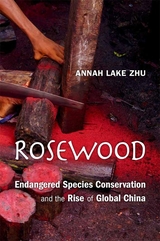 Rosewood: Endangered Species Conservation and the Rise of Global China
Annah Lake Zhu
Harvard University Press, 2022 A riveting study of the booming rosewood trade between China and Madagascar uncovers an alternative approach to environmentalism that disrupts Western models.
Rosewood is the world’s most trafficked endangered species by value, accounting for larger outlays than ivory, rhino horn, and big cats put together. Nearly all rosewood logs are sent to China, fueling a $26 billion market for classically styled furniture. Vast expeditions across Asia and Africa search for the majestic timber, and legions of Chinese ships sail for Madagascar, where rosewood is purchased straight from the forest.
The international response has been to interdict the trade, but in this incisive account Annah Lake Zhu suggests that environmentalists have misunderstood both the intent and the effect of China’s appetite for rosewood, causing social and ecological damage in the process. For one thing, Chinese consumers are understandably seeking to reclaim their cultural heritage, restoring a centuries-old tradition of home furnishing that the Cultural Revolution had condemned. In addition, Chinese firms are investing in environmental preservation. Far from simply exploiting the tree, businesses are carefully managing valuable forests and experimenting with extensive new plantings. This sustainable-use paradigm differs dramatically from the conservation norms preferred by Western-dominated NGOs, whose trade bans have prompted speculation and high prices, even encouraging criminal activity. Meanwhile, attempts to arm conservation task forces—militias meant to guard the forests—have backfired.
Drawing on years of fieldwork in China and Madagascar, Rosewood upends the pieties of the global aid industry. Zhu offers a rigorous look at what environmentalism and biodiversity protection might look like in a world no longer dominated by the West.
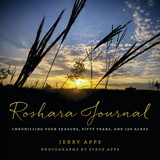 Roshara Journal: Chronicling Four Seasons, Fifty Years, and 120 Acres
Jerry Apps
Wisconsin Historical Society Press, 2016 A photographic diary of a small Midwestern farm and the family who’ve made it their home In Roshara Journal, father-and-son team Jerry and Steve Apps share the monthly happenings at their family’s farm in central Wisconsin. Featuring Steve’s stunning photos and fifty years of Jerry’s journal entries, Roshara Journal captures the changes—both from month to month and over the decades—on the landscape and farmstead. The Apps family has owned Roshara since 1966. There they nurture a prairie restoration and pine plantation, maintain a large garden that feeds three generations, observe wildlife species by the dozens, and support a population of endangered butterflies. In documenting life on this piece of land, Jerry and Steve remind us how, despite the pace and challenges of modern life, the seasons continue to influence our lives in ways large and small. Jerry explains that his journal entries become much more than mere observations: "It seems that when I write about something—a bur oak tree, for example—that old tree becomes a part of me. . . . Writing takes me to a place that goes beyond observation and understanding, a place filled with feeling and meaning." In the tradition of Bernd Heinrich in Maine, Barry Lopez in the Canadian Arctic, and Aldo Leopold just an hour down the road in Baraboo, Jerry and Steve Apps combine observation, experience, and reflection to tell a profound story about one place in the world.
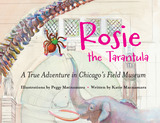 Rosie the Tarantula: A True Adventure in Chicago’s Field Museum
Illustations by Peggy Macnamara; Written by Katie Macnamara
Northwestern University Press, 2017 Chicago’s famed Field Museum of Natural History is home to a collection of thirty million geological and biological specimens that enchant and dazzle two million visitors of all ages each year. Based on a true story, Rosie the Tarantula: A True Adventure in Chicago’s Field Museum is a beautifully illustrated introduction to the Field’s treasures through the eyes of Rosie, a member of the museum’s live arachnid collection.
Several years ago, Rosie went on an expedition to the wonders of the Field’s soaring halls, such as Sue the Tyrannosaurus rex, as well as the secret specimens of animal fossils and human artifacts hidden away in drawers, cabinets, and bins. Renowned Field Museum artist-in-residence Peggy Macnamara brings the marvels of the museum to vivid life in a set of gorgeous and meticulously accurate watercolors. Peggy’s daughter Katie narrates the story of this restless arachnid in rhyme ideal for reading aloud to children.
A keepsake quality book that will delight budding young scientists and their families, Rosie the Tarantula provides a colorful, interactive experience with one of Chicago’s foremost cultural institutions. This one-of-a-kind book is rounded out by fascinating notes for adult readers, and other fun features for further reading.
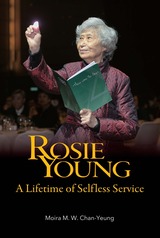 Rosie Young: A Lifetime of Selfless Service
Moira M. W. Chan-Yeung
Hong Kong University Press, 2024 Chronicles the life of a professor who dedicated her career to improving medical education and healthcare in Hong Kong.
In Rosie Young: A Lifetime of Selfless Service, Moira Chan-Yeung presents a brief history of professor Young’s remarkable career in medical education and administration at the University of Hong Kong (HKU) and her wide-ranging public service to the community over many decades. As the first female dean of HKU’s Faculty of Medicine, her career was deeply intertwined with the socio-economic development of Hong Kong. After she retired from HKU, she continued to serve HKU and the community until the present. This book illustrates her many contributions to the development of medical education in Hong Kong and the university administration at HKU. Young’s extensive public service in the field of medicine also helped improve primary care, hospital care, and public health in Hong Kong. In short, this book provides a valuable record of a female giant in medical history and documents her selfless and enduring service to the HKU community and Hong Kong society.
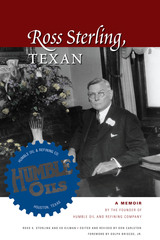 Ross Sterling, Texan: A Memoir by the Founder of Humble Oil and Refining Company
By Ross S. Sterling and Ed Kilman
University of Texas Press, 2007 Born on a farm near Anahuac, Texas, in 1875 and possessed of only a fourth-grade education, Ross Sterling was one of the most successful Texans of his generation. Driven by a relentless work ethic, he become a wealthy oilman, banker, newspaper publisher, and, from 1931 to 1933, one-term governor of Texas. Sterling was the principal founder of the Humble Oil and Refining Company, which eventually became the largest division of the ExxonMobil Corporation, as well as the owner of the Houston Post. Eager to "preserve a narrative record of his life and deeds," Ross Sterling hired Ed Kilman, an old friend and editorial page editor of the Houston Post, to write his biography. Though the book was nearly finished before Sterling's death in 1949, it never found a publisher due to Kilman's florid writing style and overly hagiographic portrayal of Sterling. In this volume, by contrast, editor Don Carleton uses the original oral history dictated by Ross Sterling to Ed Kilman to present the former governor's life story in his own words. Sterling vividly describes his formative years, early business ventures, and active role in developing the Texas oil industry. He also recalls his political career, from his appointment to the Texas Highway Commission to his term as governor, ending with his controversial defeat for reelection by "Ma" Ferguson. Sterling's reminiscences constitute an important primary source not only on the life of a Texan who deserves to be more widely remembered, but also on the history of Houston and the growth of the American oil industry.
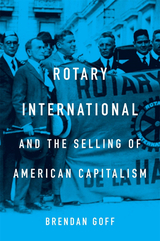 Rotary International and the Selling of American Capitalism
Brendan Goff
Harvard University Press, 2021 A new history of Rotary International shows how the organization reinforced capitalist values and cultural practices at home and tried to remake the world in the idealized image of Main Street America.
Rotary International was born in Chicago in 1905. By the time World War II was over, the organization had made good on its promise to “girdle the globe.” Rotary International and the Selling of American Capitalism explores the meteoric rise of a local service club that brought missionary zeal to the spread of American-style economics and civic ideals.
Brendan Goff traces Rotary’s ideological roots to the business progressivism and cultural internationalism of the United States in the early twentieth century. The key idea was that community service was intrinsic to a capitalist way of life. The tone of “service above self” was often religious, but, as Rotary looked abroad, it embraced Woodrow Wilson’s secular message of collective security and international cooperation: civic internationalism was the businessman’s version of the Christian imperial civilizing mission, performed outside the state apparatus. The target of this mission was both domestic and global. The Rotarian, the organization’s publication, encouraged Americans to see the world as friendly to Main Street values, and Rotary worked with US corporations to export those values. Case studies of Rotary activities in Tokyo and Havana show the group paving the way for encroachments of US power—economic, political, and cultural—during the interwar years.
Rotary’s evangelism on behalf of market-friendly philanthropy and volunteerism reflected a genuine belief in peacemaking through the world’s “parliament of businessmen.” But, as Goff makes clear, Rotary also reinforced American power and interests, demonstrating the tension at the core of US-led internationalism.
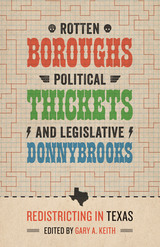 Rotten Boroughs, Political Thickets, and Legislative Donnybrooks: Redistricting in Texas
Edited by Gary A. Keith
University of Texas Press, 2013 Every ten years, the Texas legislature redistricts itself and the state’s congressional districts in an attempt to ensure equality in representation. With a richly textured cultural fabric, Texas often experiences redistricting battles that are heated enough to gain national attention. Collecting a variety of voices, including legislators themselves, in addition to lawyers, community organizers, political historians, and political scientists, Rotten Boroughs, Political Thickets, and Legislative Donnybrooks delivers a multidimensional picture of how redistricting works in Texas today, and how the process evolved. In addition to editor Gary Keith’s historical narrative, which emphasizes the aftermath of the Warren Court’s redistricting decisions, longtime litigators David Richards and J. D. Pauerstein describe the contentious lines drawn from the 1970s into the 2000s. Former state legislator and congressman Craig Washington provides an insider’s view, while redistricting attorney and grassroots organizer Jose Garza describes the repercussions for Mexican Americans in Texas. Balancing these essays with a quantitative perspective, political scientists Seth McKee and Mark McKenzie analyze the voting data for the 2000 decade to describe the outcomes of redistricting. The result is a timely tour that provides up-to-date context, particularly on the role of the Voting Rights Act in the twenty-first century. From local community engagement to the halls of the Capitol, this is the definitive portrait of redistricting and its repercussions for all Texans.
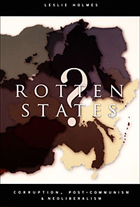 Rotten States?: Corruption, Post-Communism, and Neoliberalism
Leslie Holmes
Duke University Press, 2006 Official corruption has become increasingly prevalent around the world since the early 1990s. The situation appears to be particularly acute in the post-communist states. Corruption—be it real or perceived—is a major problem with concrete implications, including a lowered likelihood of foreign investment. In Rotten States? Leslie Holmes analyzes corruption in post-communist countries, paying particular attention to Bulgaria, Hungary, Poland, and Russia, as well as China, which Holmes argues has produced, through its recent economic liberalization, a system similar to post-communism. As he points out, these countries offer useful comparisons: they vary in terms of size, religious orientation, ethnic homogeneity, and their approaches to and economic success with the transition from communism. Drawing on data including surveys commissioned especially for this study, Holmes examines the causes and consequences of official corruption as well as ways of combating it. He focuses particular attention on the timing of the recent increase in reports of corruption, the relationship between post-communism and corruption, and the interplay between corruption and the delegitimation and weakening of the state. Holmes argues that the global turn toward neoliberalism—with its focus on ends over means, flexibility, and a reduced role for the state—has generated much of the corruption in post-communist states. At the same time, he points out that neoliberalism is perhaps the single most powerful tool for overcoming the communist legacy, which is an even more significant cause of corruption. Among the conclusions that Holmes draws is that a strong democratic state is needed in the early stages of the transition from communism in order to prevent corruption from taking hold.
Rouge Pulp
Dorothy Barresi
University of Pittsburgh Press, 2002 Rouge Pulp explores notions of body and beauty, birth and death, in a contemporary America driven by its contradictions: material plenty and spiritual lack. Dorothy Barresi writes about strippers, hair salons, cancer, good credit ratings, cockfights, childbirth, maternal love, war. Her poems take the world’s brutal vitality as their music, and they refuse to despair.
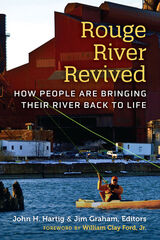 Rouge River Revived: How People Are Bringing Their River Back to Life
John H. Hartig and Jim Graham, Editors
University of Michigan Press, 2022 The Rouge River is a mostly urbanized watershed of about 500 square miles populated by nearly 1.4 million people. While not geographically large, the river has played an outsized role in the history of southeast Michigan, most famously housing Ford Motor Company’s massive Rouge Factory, designed by architect Albert Kahn and later memorialized in Diego Rivera’s renowned “Detroit Industry” murals. In recent decades, the story of the Rouge River has also been one of grassroots environmental activism. After pollution from the Ford complex and neighboring factories literally caused the river to catch on fire in 1969, community groups launched a Herculean effort to restore and protect the watershed. Today the Rouge stands as one of the most successful examples of urban river revival in the country.
Rouge River Revived describes the river’s history from pre-European times into the 21st century. Chapters cover topics such as Native American life on the Rouge; indigenous flora and fauna over time; the river’s role in the founding of local cities; its key involvement in Detroit’s urban development and intensive industrialization; and the dramatic clean-up arising from citizen concern and activism. This book is not only a history of the environment of the Rouge River, but also of the complex and evolving relationship between humans and natural spaces.
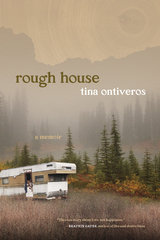 rough house: a memoir
Tina Ontiveros
Oregon State University Press, 2020 Tina Ontiveros was born into timber on both sides of the family. Her mother spent summers driving logging trucks for her family’s operation, and her father was the son of an itinerant logger, raised in a variety of lumber towns, as Tina herself would be.
A story of growing up in turmoil, rough house recounts a childhood divided between a charming, mercurial, abusive father in the forests of the Pacific Northwest and a mother struggling with small-town poverty. It is also a story of generational trauma, especially for the women—a story of violent men and societal restrictions, of children not always chosen and frequently raised alone.
Ontiveros’s father, Loyd, looms large. Reflecting on his death and long absence from her life, she writes, “I had this ridiculous hope that I would get to enjoy a functional relationship with my father, on my own terms, now that I was an adult.” In searingly honest, straightforward prose, rough house is her attempt to carve out this relationship, to understand her father and her family from an adult perspective.
While some elements of Ontiveros’s story are universal, others are indelibly grounded in the logging camps of the Pacific Northwest at the end of the twentieth century, as the lumber industry shifted and contracted. Tracing her childhood through the working-class towns and forests of Washington and Oregon, Ontiveros explores themes of love and loss, parents and children, and her own journey to a different kind of adulthood.
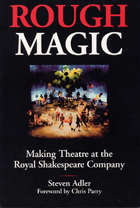 Rough Magic: Making Theatre at the Royal Shakespeare Company
Steven Adler. Foreword by Chris Parry
Southern Illinois University Press, 2001 Steven Adler examines the dynamic life and workings of the theatre company responsible for some of the world’s most compelling performances and influential productions of the last forty years, including Marat/Sade, A Midsummer Night’s Dream, Les Misérables, Les Liaisons Dangereuses, and Nicholas Nickleby. Rough Magic provides a thorough analysis of the many strands of theatrical activity on both sides of the footlights that coalesce in the artistic vigor of the Royal Shakespeare Company. Adler traces the company’s evolution from its origins in 1879 as a week-long festival presented by Stratford-upon-Avon as a birthday homage to its native son, to its current incarnation as one of the world’s most distinguished institutional theatres. He probes the aspirations and achievements of the RSC’s four successive artistic directors: Peter Hall, Trevor Nunn, Terry Hands, and Adrian Noble. He offers a comprehensive view of the design and aesthetics of the RSC’s five theatres in Stratford and London, and explores the intricate process of crafting a repertoire at home and on tour that responds to the needs of the artists as well as the demands of the box office. Vivid illustrations, personal observation, research, and dozens of interviews with current and former members of the Royal Shakespeare Company unite to produce Rough Magic.
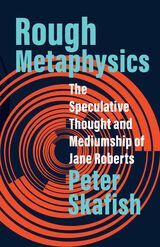 Rough Metaphysics: The Speculative Thought and Mediumship of Jane Roberts
Peter Skafish
University of Minnesota Press, 2023 A powerful case for why anthropology should study outsiders of thought and their speculative ideas
What sort of thinking is needed to study anomalies in thought? In this trenchantly argued and beautifully written book, anthropologist Peter Skafish explores this provocative question by examining the writings of the medium and “rough metaphysician” Jane Roberts (1929–1984). Through a close interpretation of her own published texts as well as those she understood herself to have dictated for her cohort of channeled personalities—including one, named “Seth,” who would inspire the New Age movement—Skafish shows her intuitive and dreamlike work to be a source of rigorously inventive ideas about science, ontology, translation, and pluralism. Arguing that Roberts’s writings contain philosophies ahead of their time, he also asks: How might our understanding of speculative thinking change if we consider the way untrained writers, occult visionaries, and their counterparts in other cultural traditions undertake it? What can outsider thinkers teach us about the limitations of even our most critical intellectual habits? Rough Metaphysics is at once an ethnography of the books of a strange and yet remarkable writer, a commentary on the unlikely philosophy contained in them, and a call for a new way of doing (and undoing) philosophy through anthropology, and vice versa. In guiding the reader through Roberts’s often hallucinatory “world of concepts,” Skafish also develops a series of original interpretations of thinkers—from William James to Claude Lévi-Strauss to Paul Feyerabend—who have been vital to anthropologists and their fellow travelers. Seductively written and surprising in its turns of thought, Rough Metaphysics is a feast for anyone who wants to learn how to think something new, especially about thought.
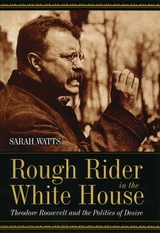 Rough Rider in the White House: Theodore Roosevelt and the Politics of Desire
Sarah Watts
University of Chicago Press, 2003 Who was Theodore Roosevelt? Most of us think of him as one of America's greatest presidents, a champion of progressive politics, and a master statesman. But many feared the political power that Roosevelt wielded. Woodrow Wilson once called him "the most dangerous man of the age." Mark Twain thought him "clearly insane." William James scorned the "flood of bellicose emotion" he let loose during his presidency. Even his biographer, Edmund Morris, is astonished at Roosevelt's "irrational love of battle."
In this book, Sarah Watts probes this dark side of the Rough Rider, presenting a fascinating psychological portrait of a man whose personal obsession with masculinity profoundly influenced the fate of a nation. Drawing on his own writings and on media representations of him, Watts attributes the wide appeal of Roosevelt's style of manhood to the way it addressed the hopes and anxieties of men of his time. Like many of his contemporaries, Roosevelt struggled with what it meant to be a man in the modern era. He saw two foes within himself: a fragile weakling and a primitive beast. The weakling he punished and toughened with rigorous, manly pursuits such as hunting, horseback riding, and war. The beast he unleashed through brutal criticism of homosexuals, immigrants, pacifists, and sissies—anyone who might tarnish the nation's veneer of strength and vigor. With his unabashed paeans to violence and aggressive politics, Roosevelt ultimately offered American men a chance to project their longings and fears onto the nation and its policies. In this way he harnessed the primitive energy of men's desires to propel the march of American civilization—over the bodies of anyone who might stand in its way.
Written with passion and precision, this powerful revisioning of an American icon will forever alter the way we see Theodore Roosevelt and his political legacy.
"A superb scholarly study of how Roosevelt built his political base on the aspiration and fears of men in a rapidly changing nation and world."—Charles K. Piehl, Library Journal
"A thought-provoking and innovative study of the dark side of Roosevelt's personality. . . . [Watt's] arguments are clear, passionate, and thoroughly supported."—Elizabeth A. Bennion, Journal of Interdisciplinary History
A Rough Sort of Beauty: Reflections on the Natural Heritage of Arkansas
Dana Steward
University of Arkansas Press, 2002 What does it mean to have a sense of place? Through history, memoir, poetry, and fiction, the writers of these essays answer this question in a variety of ways, giving us their collective history of natural Arkansas. They speak of the interrelationships of humans and nature, and of the struggles for balance between economic realities and landscape preservation. The book evokes the sheer physical diversity of the Natural State, from the Ozarks and the Boston Mountains to Crowley's Ridge, the Grand Prairie, and the Delta. But far more than mere geography, these are places of intense meaning: sites of enlightenment, conflict, comfort, and vivid experience. Rivers and mountains, plains and forests — these are shorthand terms for specific, beloved, storied places.
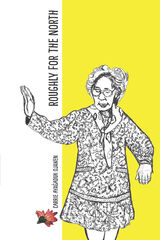 Roughly For the North
Carrie Ayagaduk Ojanen
University of Alaska Press, 2018 “I wish I were a dancer to let lines fall like that. / But I am dressed like you, roughly for the North.”
Roughly for the North is a tender and complex portrait of an Arctic and sub-arctic world. Full of lush language and imagery, each poem is an act of devotion and love to one’s family and land. Carrie Ayaġaduk Ojanen weaves a moving portrait of grief, of the rippling effects of historical trauma on succeeding generations, of resilience in the face of adversity, of respect for the Alaska Native traditions she grew up in. With vivid imagery, she draws the reader into Northern life, where the spiritual and industrial collide. She uses formalism and lyrical free verse to explore the natural world and to conjure a place of staggering beauty that hides death around every corner.
A member of the Ugiuvamiut tribe, Ojanen grounds her work in a web of familial relationships. Especially important is her connection with her grandparents, members of the last generation to make their home on Ugiuvak (King Island), Alaska. With heartfelt verse, her poems reflect the staggering cultural changes her grandparents faced and the way traditional art forms continue to unite her community and help them connect to the past.
Roughneck Grace: Farmer Yoga, Creeping Codgerism, Apple Golf, and Other Brief Essays from on and off the Back Forty
Michael Perry
Wisconsin Historical Society Press, 2016 New York Times bestselling author, humorist, and newspaper columnist Michael Perry returns with a new collection of bite-sized essays from his Sunday Wisconsin State Journal column, “Roughneck Grace.” Perry’s perspectives on everything from cleaning the chicken coop to sharing a New York City elevator with supermodels will have you snorting with laughter on one page, blinking back tears on the next, and--no matter your zip code--nodding in recognition throughout.
Roughnecks, Drillers, and Tool Pushers: Thirty-three Years in the Oil Fields
By Gerald Lynch
University of Texas Press, 1991 Oil, the black gold of Texas, has given rise to many a myth. Oil could turn a man overnight into a millionaire—and did, for some. But these myths have obscured what life was really like in the oil patch, a place that was neither the El Dorado of legend nor quite the unredeemed den of sin and iniquity that some feared. In Roughnecks, Drillers, and Tool Pushers, Gerald Lynch provides a much-needed insider's view of the oil industry, describing life in various oil fields in and around Texas. He also chronicles changes in drilling methods and oil-field technology and how these changes affected him and his fellow oil-field workers. No one else has written a working-class history of the oil fields as colorful and articulate as this one.
 Rough-Water Man: Elwyn Blake'S Colorado River Expeditions
Richard E. Westwood
University of Nevada Press, 2013 The passage of the 1902 Reclamation Act created a mandate for the federal government to build dams on the Colorado River and its powerful tributaries. By 1920 the US Geological Survey had surveyed the river’s main courses, but still needed accurate charts of the last stretches of deep canyons and white-water rapids, accessible only by boat.Rough-Water Man is the first detailed account of these mapping expeditions by the USGS—the San Juan Canyon in 1921, the upper Green River in 1922, and the Grand Canyon in 1923. Illustrated throughout with period photographs, it is also the personal story of twenty-four-year-old Henry Elwyn Blake Jr., the only boatman to crew on each of the three trips, evolving from novice waterman to expert rapids runner. Drawing on Blake’s diaries, as well as the writings of other USGS surveyors, Rough-Water Man conveys the danger and hardships of navigating these waters with heavy wooden boats and oars. Even today, in rubber pontoons, traversing these canyons is an awesome and exhilarating experience. When Blake and his companions surveyed it, the Colorado ran free and wild from Wyoming to the Sea of Cortez. Westwood gives us mile-by-mile and day-by-day accounts of running these rapids before their canyons were flooded and waters tamed, before the rivers had ever been charted.
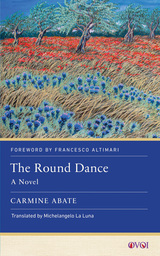 The Round Dance: A Novel
Carmine Abate
Rutgers University Press, 2024 The village of Hora is a magical place that blurs the boundaries between a mythical past and the present. It is here that Costantino Avati grows alongside his impetuous and melancholic father, Francesco; his mother, Elena, who hides a secret torment; his two sisters, Orlandina and Lucrezia; and his grandfather Lissandro, the last custodian of an era and a world that are disappearing. As Costantino feels the pangs of first love with the intriguing Roman Isabella, he also discovers the romantic allure of his own village and its rich cultural heritage. In his first novel, acclaimed author Carmine Abate transforms his Italo-Albanian (Arbëresh) hometown of Carfizzi, Calabria, into a magical realist wonderland that rivals Gabriel García Márquez’s Macondo. Inspired by the oral traditions of the old Albanian bards and incorporating the poetic local dialect, The Round Dance is a unique piece of multicultural literature that was named by the publishing house Mondadori as one of the one hundred greatest Italian novels of the twentieth century.
Round Lake
Grace Bonner
Four Way Books, 2016 Round Lake begins with an awakening in solitude. It moves through a search for romantic love, and attempts to create a sense of home and family through art and travel. There are elegies: surviving a sibling’s drug addiction, and the losses of a father (to cancer) and a mother (to suicide).
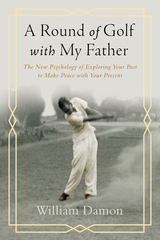 A Round of Golf with My Father: The New Psychology of Exploring Your Past to Make Peace with Your Present
Damon, William
Templeton Press, 2021 Viewing our past through the eyes of maturity can reveal insights that our younger selves could not see. Lessons that eluded us become apparent. Encounters that once felt like misfortunes now become understood as valued parts of who we are. We realize what we’ve learned and what we have to teach. And we’re encouraged to chart a future that is rich with purpose.
In A Round of Golf with My Father, William Damon introduces us to the “life review.” This is a process of looking with clarity and curiosity at the paths we’ve traveled, examining our pasts in a frank yet positive manner, and using what we’ve learned to write purposeful next chapters for our lives.
For Damon, that process began by uncovering the mysterious life of his father, whom he never met and never gave much thought to. What he discovered surprised him so greatly that he was moved to reassess the events of his own life, including the choices he made, the relationships he forged, and the career he pursued.
Early in his life, Damon was led to believe that his father had been killed in World War II. But the man survived and went on to live a second life abroad. He married a French ballerina, started a new family, and forged a significant Foreign Service career. He also was an excellent golfer, a bittersweet revelation for Damon, who wishes that his father had been around to teach him the game.
We follow Damon as he struggles to make sense of his father’s contradictions and how his father, even though living a world apart, influenced Damon’s own development in crucial ways. In his life review, Damon uses what he learned about his father to enhance his own newly emerging self-knowledge.
Readers of this book may come away inspired to conduct informal life reviews for themselves. By uncovering and assembling the often overlooked puzzle pieces of their pasts, readers can seek present-day contentment and look with growing optimism to the years ahead.
Roundabout: An Improvisational Fiction
Phong Nguyen
Moon City, 2019 Ovid Dullann works as an assistant accountant for a multinational corporation and is supporting a family of four; but abruptly, on his forty-ninth birthday, Ovid runs away from his daily work and his loving family to go on a road trip. Struck by inspiration, Ovid knows that an Author is writing about him, and will do anything to avoid acting as a protagonist of a book. But this Author will not abandon his pursuit, and vows to punish Ovid, his wayward protagonist.
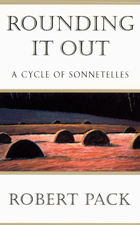 Rounding It Out: A Cycle of Sonnetelles
Robert Pack
University of Chicago Press, 1999 Acclaimed by writers, critics, and readers from Robert Penn Warren to Stephen Jay Gould, Robert Pack is one of the most widely respected poets in America. Pack's newest collection, Rounding It Out, offers a lyric sequence exploring circularity as a musical principle and as a paradigm of the human experience. The imagistic content of the poems, as well as their structure in four sections—morning, midday, evening, night—recall nature's primary rhythm of departure and return, and the dust-to-dust cycle of a completed lifetime.
Rounding It Out is not only about these themes, but also, through reflection, about its own chosen form. Each of the poems is a cross between a sonnet and a villanelle, a formal innovation Pack calls a sonnetelle. Employing meter and rhyme, assonance and alliteration, Pack takes delight and finds consolation in the sensuousness of the English language even in the face of mortality and ongoing personal loss.
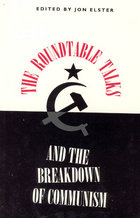 The Roundtable Talks and the Breakdown of Communism
Edited by Jon Elster
University of Chicago Press, 1996 In 1989 and 1990, Eastern European Communist regimes and opposition groups conducted a series of roundtable talks to peacefully negotiate the abolition of authoritarian rule and the transition to democratic governance. This volume documents that unprecedented process of national reinvention and constitution making.
These essays capture the historical circumstances of these countries—their traditions, customs, and the balance of influence between competing factions—that often took precedence over constitutional ideals. In five country-specific reports, senior scholars provide detailed accounts of the talks in Bulgaria, Poland, Hungary, Czechoslovakia, and the German Democratic Republic. Also included is an essay on the political factors underlying the failure of negotiations between reform groups and the Chinese regime, providing an illuminating counterpoint to the path taken in Eastern Europe.
This book is an invaluable resource for scholars of constitutional design and democratization and for specialists in Eastern Europe.
The Roundtable Talks of 1989: The Genesis of Hungarian Democracy
András Bozóki
Central European University Press, 2002 This is the first book in English which provides comprehensive analysis and documentary history on the Roundtable talks, the major event of the “negotiated revolution” of Hungary. These negotiations occurred during the summer months of 1989 between the representatives of the Communist Party, the Opposition Roundtable, and the so-called Third Side (which brought some pro-Communist satellite organizations together). The authors offer much more than just a detailed account on the negotiations: they also put the process of constitutional revolution into a comparative and historical perspective. They believe that the Roundtable Talks amounted to much more than just a sideshow and in fact they constituted the hub of the revolutionary transformation.
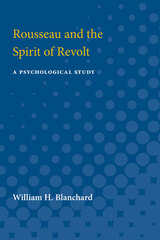 Rousseau and the Spirit of Revolt: A Psychological Study
William H. Blanchard
University of Michigan Press, 1967 Jean-Jacques Rousseau was one of the most influential writers of the eighteenth century, and one of the most controversial. His writings are full of the paradoxes of his personality—his quest for natural truth and his own self-deceptions, his democratic and his despotic tendencies, his imperiousness and his submissiveness, his love of society and his love of solitude.In this study William H. Blanchard, a practicing psychologist, examines the interplay between Rousseau's complex personality and his political writings. Blanchard presents the biographical facts of Rousseau's life and, with the help of Rousseau's Confessions, interprets them according to modern psychology. Blanchard believes that almost all of Rousseau's works have political implications, and he considers such diverse writings as the Letter to d'Alembert on the Theatre, The Social Contract, Emile, and Rousseau's correspondence in the light of his interpretations.One of the major paradoxes of Rousseau's work is that it has been widely used as ideological support by both democratic and despotic forces. The name of Rousseau was invoked throughout the French Revolution by both the early democrats and the later terrorists. Blanchard explores the similarity between the rebel and the tyrant in Rousseau, discusses Rousseau's "urge to suffer for truth," and comments incisively on the dangers of these tendencies, which he finds present in modern society.The author has made excellent use of original documents and sources in his study of Rousseau, and he takes the opportunity to correct various misinterpretations of Rousseau's relations with his contemporaries, particularly David Hume.
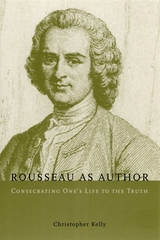 Rousseau as Author: Consecrating One's Life to the Truth
Christopher Kelly
University of Chicago Press, 2002 For Rousseau, "consecrating one's life to the truth" (his personal credo) meant publicly taking responsibility for what one publishes and only publishing what would be of public benefit. Christopher Kelly argues that this commitment is central to understanding the relationship between Rousseau's writings and his political philosophy.
Unlike many other writers of his day, Rousseau refused to publish anonymously, even though he risked persecution for his writings. But Rousseau felt that authors must be self-restrained, as well as bold, and must carefully consider the potential political effects of what they might publish: sometimes seeking the good conflicts with writing the truth. Kelly shows how this understanding of public authorship played a crucial role in Rousseau's conception—and practice—of citizenship and political action.
Rousseau as Author will be a groundbreaking book not just for Rousseau scholars, but for anyone studying Enlightenment ideas about authorship and responsibility.
Rousseau, Judge of Jean-Jacques: Dialogues
Jean-Jacques Rousseau
Dartmouth College Press, 2012 One of Rousseau’s later and most puzzling works and never before available in English, this neglected autobiographical piece was the product of the philosopher’s old age and sense of persecution. Long viewed simply as evidence of his growing paranoia, it consists of three dialogues between a character named “Rousseau” and one identified only as “Frenchman” who discuss the bad reputation and works of an author named “Jean-Jacques.” Dialogues offers a fascinating retrospective of his literary career.
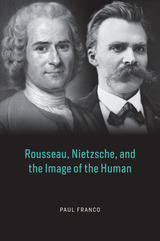 Rousseau, Nietzsche, and the Image of the Human
Paul Franco
University of Chicago Press, 2021 Rousseau and Nietzsche presented two of the most influential critiques of modern life and much can still be learned from their respective analyses of problems we still face.
In Rousseau, Nietzsche, and the Image of the Human, Paul Franco examines the relationship between Jean-Jacques Rousseau and Friedrich Nietzsche, arguably the two most influential shapers and explorers of the moral and cultural imagination of late modernity. Both thinkers leveled radical critiques of modern life, but those critiques differed in important respects. Whereas Rousseau focused on the growing inequality of modern society and the hypocrisy, self-division, and loss of civic virtue it spawned, Nietzsche decried the democratic equality he identified with Rousseau and the loss of individual and cultural greatness it entailed. Franco argues, however, that Rousseau and Nietzsche are more than mere critics; they both put forward powerful alternative visions of how we ought to live. Franco focuses specifically on their views of the self and its realization, their understandings of women and the relation between the sexes, and their speculative conceptions of politics. While there are many similarities in their positive visions, Franco argues that it is the differences between them from which we have most to learn.
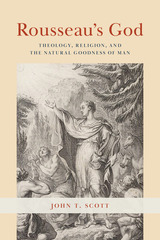 Rousseau's God: Theology, Religion, and the Natural Goodness of Man
John T. Scott
University of Chicago Press, 2023 A landmark study of Rousseau’s theological and religious thought.
John T. Scott offers a comprehensive interpretation of Rousseau’s theological and religious thought, both in its own right and in relation to Rousseau’s broader oeuvre. In chapters focused on different key writings, Scott reveals recurrent themes in Rousseau’s views on the subject and traces their evolution over time. He shows that two concepts—truth and utility—are integral to Rousseau’s writings on religion. Doing so helps to explain some of Rousseau’s disagreements with his contemporaries: their different views on religion and theology stem from different understandings of human nature and the proper role of science in human life. Rousseau emphasizes not just what is true, but also what is useful—psychologically, morally, and politically—for human beings. Comprehensive and nuanced, Rousseau’s God is vital to understanding key categories of Rousseau’s thought.
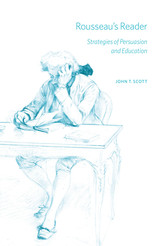 Rousseau's Reader: Strategies of Persuasion and Education
John T. Scott
University of Chicago Press, 2020 On his famous walk to Vincennes to visit the imprisoned Diderot, Rousseau had what he called an “illumination”—the realization that man was naturally good but becomes corrupted by the influence of society—a fundamental change in Rousseau’s perspective that would animate all of his subsequent works. At that moment, Rousseau “saw” something he had hitherto not seen, and he made it his mission to help his readers share that vision through an array of rhetorical and literary techniques.
In Rousseau’s Reader, John T. Scott looks at the different strategies Rousseau used to engage and persuade the readers of his major philosophical works, including the Social Contract, Discourse on Inequality, and Emile. Considering choice of genre; textual structure; frontispieces and illustrations; shifting authorial and narrative voice; addresses to readers that alternately invite and challenge; apostrophe, metaphor, and other literary devices; and, of course, paradox, Scott explores how the form of Rousseau’s writing relates to the content of his thought and vice versa. Through this skillful interplay of form and content, Rousseau engages in a profoundly transformative dialogue with his readers.
While most political philosophers have focused, understandably, on Rousseau’s ideas, Scott shows convincingly that the way he conveyed them is also of vital importance, especially given Rousseau’s enduring interest in education. Giving readers the key to Rousseau’s style, Scott offers fresh and original insights into the relationship between the substance of his thought and his literary and rhetorical techniques, which enhance our understanding of Rousseau’s project and the audiences he intended to reach.
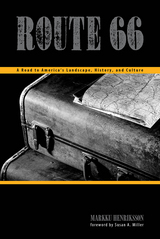 Route 66: A Road to America's Landscape, History, and Culture
Markku Henriksson
Texas Tech University Press, 2014 When Markku Henriksson was growing up in Finland, the song “(Get Your Kicks on) Route 66” was one of only two he could recognize—in English or Finnish. It was not until 1989 that Henriksson would catch his first glimpse of the legendary highway. It was enough to lure Henriksson four years later to the second international Route 66 festival in Flagstaff. There he realized that Route 66 was the perfect basis for a multidisciplinary American Studies course, one that he has been teaching at the University of Helsinki ever since.
Forming the soul of this work—and yielding a more holistic and complex picture than any previous study—are Henriksson’s 1996 (east to west) and 2002 (west to east) journeys along the full length of the Route and his mastery of the literature and film that illuminate the Route’s place in Americana. Not a history of the road itself and the towns along the way, Henriksson’s perspective offers insight into America and its culture as revealed in its peoples, their histories, cultures, and music as displayed along the Mother Road.
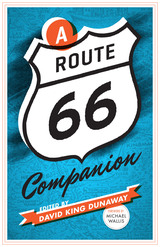 A Route 66 Companion
Edited by David King Dunaway
University of Texas Press, 2012 Even before there was a road, there was a route. Buffalo trails, Indian paths, the old Santa Fe trace—all led across the Great Plains and the western mountains to the golden oasis of California. America’s insatiable westering urge culminated in Route 66, the highway that ran from Chicago to Los Angeles. Opened in 1926, Route 66 became the quintessential American road. It offered the chance for freedom and a better life, whether you were down-and-out Okies fleeing the Dust Bowl in the 1930s or cool guys cruising in a Corvette in the 1960s. Even though the interstates long ago turned Route 66 into a bylane, it still draws travelers from around the world who long to experience the freedom of the open road. A Route 66 Companion gathers fiction, poetry, memoir, and oral history to present a literary historical portrait of America’s most storied highway. From accounts of pioneering trips across the western plains to a sci-fi fantasy of traveling Route 66 in a rocket, here are stories that explore the mystique of the open road, told by master storytellers ranging from Washington Irving to Raymond Chandler, Joan Didion, Sylvia Plath, Leslie Marmon Silko, and John Steinbeck. Interspersed among them are reminiscences that, for the first time, honor the varied cultures—Native American, Mexican American, and African American, as well as Anglo—whose experiences run through the Route 66 story like the stripe down the highway. So put the top down, set the cruise control, and “make that California trip” with A Route 66 Companion.
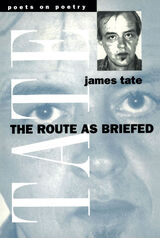 The Route as Briefed
James Tate
University of Michigan Press, 1999 The Route as Briefed collects prose by Pulitzer Prize winning poet James Tate. It is an amazingly eclectic collection, offering essays, interviews, short-short stories, memoirs, and even a recipe for squirrel brains in black butter. The essays and interviews touch on themes ranging from poetic influences to MFA programs, and from the role of humor in poetry to the nature of regional writing. The fiction selections--none more than four pages long--are as engaging as their titles, e.g., Despair Ice Cream, Running for Your Life, Dreams of a Robot Dancing Bee, Pie, and A Cloud of Dust. The memoirs include Tate's journal entries during a trip to Spain, and a long piece on the father he never met, killed in action during World War II.
In typical Tate style, the book continually straddles the line between fiction and autobiography, entertaining readers with amusing accounts of the poet's own experiences while drawing on these to narrate the fictional stories as well.
James Tate is Professor of Poetry, University of Massachusetts. He is the author of a number of books of poetry, including Worshipful Company of Fletchers: Poems, 1994; Selected Poems, 1991; Distance from Loved Ones, 1990. He has received several awards for his work, including the Pulitzer Prize for poetry in 1992.
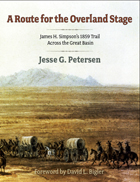 Route for the Overland Stage: James H. Simpson's 1859 Trail Across the Great Basin
Jesse G. Petersen
Utah State University Press, 2008 The 1859 exploration of the Great Basin by army topographical engineer James Simpson opened up one of the West's most important transportation and communication corridors, a vital link between the Pacific Coast and the rest of the nation. It became the route of the Pony Express and the Overland Mail and Stage, the line of the Pacific telegraph, a major wagon road for freighters and emigrants, and, later, the first transcontinental auto road, the Lincoln Highway, now Highway 50. No one has accurately tracked or mapped Simpson's original route, until now. Jesse Petersen shows in words, maps, and photos exactly where the explorer went. Sharing his detective-like reasoning as he walked or drove the entire trail west and Simpson's variant route returning east, Petersen takes readers on a mountain and desert trek through some of America's most remote and striking landscapes.
Routes of Passage: Rethinking the African Diaspora: Volume 1, Part 1
Ruth Simms Hamilton
Michigan State University Press, 2007 Routes of Passage provides a conceptual, substantive, and empirical orientation to the study of African people worldwide. The book addresses issues of geographical mobility and geosocial displacement; changing culture, political, and economic relationships between Africa and its diaspora; interdiaspora relations; political and economic agency and social mobilization, including cultural production and psychocultural transformation; existence in hostile and oppressive political and territorial space; and confronting interconnected relations of social inequality, especially class, gender, nationality, and race.
Routes of Passage: Rethinking the African Diaspora: Volume 1, Part 2
Ruth Simms Hamilton
Michigan State University Press, 2007 Routes of Passage provides a conceptual, substantive, and empirical orientation to the study of African people worldwide. Routes of Passage addresses issues of geographical mobility and geosocial displacement; changing cultural, political, and economic relationships between Africa and its diaspora; interdiaspora relations; political and economic agency and social mobilization, including cultural production and psychocultural transformation; existence in hostile and oppressive political and territorial space; and confronting interconnected relations of social inequality, especially class, gender, nationality, and race.
 Routes of Power: Energy and Modern America
Christopher F. Jones
Harvard University Press, 2014 The fossil fuel revolution is usually rendered as a tale of historic advances in energy production. In this perspective-changing account, Christopher F. Jones instead tells a story of advances in energy access—canals, pipelines, and wires that delivered power in unprecedented quantities to cities and factories at a great distance from production sites. He shows that in the American mid-Atlantic region between 1820 and 1930, the construction of elaborate transportation networks for coal, oil, and electricity unlocked remarkable urban and industrial growth along the eastern seaboard. But this new transportation infrastructure did not simply satisfy existing consumer demand—it also whetted an appetite for more abundant and cheaper energy, setting the nation on a path toward fossil fuel dependence.
Between the War of 1812 and the Great Depression, low-cost energy supplied to cities through a burgeoning delivery system allowed factory workers to mass-produce goods on a scale previously unimagined. It also allowed people and products to be whisked up and down the East Coast at speeds unattainable in a country dependent on wood, water, and muscle. But an energy-intensive America did not benefit all its citizens equally. It provided cheap energy to some but not others; it channeled profits to financiers rather than laborers; and it concentrated environmental harms in rural areas rather than cities.
Today, those who wish to pioneer a more sustainable and egalitarian energy order can learn valuable lessons from this history of the nation’s first steps toward dependence on fossil fuels.
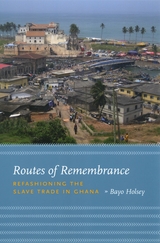 Routes of Remembrance: Refashioning the Slave Trade in Ghana
Bayo Holsey
University of Chicago Press, 2008 Over the past fifteen years, visitors from the African diaspora have flocked to Cape Coast and Elmina, two towns in Ghana whose chief tourist attractions are the castles and dungeons where slaves were imprisoned before embarking for the New World. This desire to commemorate the Middle Passage contrasts sharply with the silence that normally cloaks the subject within Ghana. Why do Ghanaians suppress the history of enslavement? And why is this history expressed so differently on the other side of the Atlantic?
Routes of Remembrance tackles these questions by analyzing the slave trade’s absence from public versions of coastal Ghanaian family and community histories, its troubled presentation in the country’s classrooms and nationalist narratives, and its elaboration by the transnational tourism industry. Bayo Holsey discovers that in the past, African involvement in the slave trade was used by Europeans to denigrate local residents, and this stigma continues to shape the way Ghanaians imagine their historical past. Today, however, due to international attention and the curiosity of young Ghanaians, the slave trade has at last entered the public sphere, transforming it from a stigmatizing history to one that holds the potential to contest global inequalities.
Holsey’s study will be crucial to anyone involved in the global debate over how the slave trade endures in history and in memory.
 Routes of War: The World of Movement in the Confederate South
Yael A. Sternhell
Harvard University Press, 2012 The Civil War thrust millions of men and women-rich and poor, soldiers and civilians, enslaved and free-onto the roads of the South. During four years of war, Southerners lived on the move. In the hands of Yael A. Sternhell, movement becomes a radically new means to perceive the full trajectory of the Confederacy's rise, struggle, and ultimate defeat.
By focusing not only on the battlefield and the home front but also on the roads and woods that connected the two, this pioneering book investigates the many roles of bodies in motion. We watch battalions of young men as they march to the front, galvanizing small towns along the way, creating the Confederate nation in the process. We follow deserters straggling home and refugees fleeing enemy occupation, both hoping to escape the burdens of war. And in a landscape turned upside down, we see slaves running toward freedom, whether hundreds of miles away or just beyond the plantation's gate.
Based on a vast array of documents, from slave testimonies to the papers of Confederate bureaucrats to the private letters of travelers from all walks of life, Sternhell unearths the hidden connections between physical movements and their symbolic meanings, individual bodies and entire armies, the reinvention of a social order and the remaking of private lives. Movement, as means of liberation and as vehicle of subjugation, lay at the heart of the human condition in the wartime South.
 Routes: Travel and Translation in the Late Twentieth Century
James Clifford
Harvard University Press, 1997 When culture makes itself at home in motion, where does an anthropologist stand? In a follow-up to The Predicament of Culture, one of the defining books for anthropology in the last decade, James Clifford takes the proper measure: a moving picture of a world that doesn't stand still, that reveals itself en route, in the airport lounge and the parking lot as much as in the marketplace and the museum.
In this collage of essays, meditations, poems, and travel reports, Clifford takes travel and its difficult companion, translation, as openings into a complex modernity. He contemplates a world ever more connected yet not homogeneous, a global history proceeding from the fraught legacies of exploration, colonization, capitalist expansion, immigration, labor mobility, and tourism. Ranging from Highland New Guinea to northern California, from Vancouver to London, he probes current approaches to the interpretation and display of non-Western arts and cultures. Wherever people and things cross paths and where institutional forces work to discipline unruly encounters, Clifford's concern is with struggles to displace stereotypes, to recognize divergent histories, to sustain "postcolonial" and "tribal" identities in contexts of domination and globalization.
Travel, diaspora, border crossing, self-location, the making of homes away from home: these are transcultural predicaments for the late twentieth century. The map that might account for them, the history of an entangled modernity, emerges here as an unfinished series of paths and negotiations, leading in many directions while returning again and again to the struggles and arts of cultural encounter, the impossible, inescapable tasks of translation.
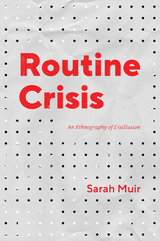 Routine Crisis: An Ethnography of Disillusion
Sarah Muir
University of Chicago Press, 2021 Argentina, once heralded as the future of capitalist progress, has a long history of economic volatility. In 2001–2002, a financial crisis led to its worst economic collapse, precipitating a dramatic currency devaluation, the largest sovereign default in world history, and the flight of foreign capital. Protests and street blockades punctuated a moment of profound political uncertainty, epitomized by the rapid succession of five presidents in four months. Since then, Argentina has fought economic fires on every front, from inflation to the cost of utilities and depressed industrial output. When things clearly aren't working, when the constant churning of booms and busts makes life almost unlivable, how does our deeply compromised order come to seem so inescapable? How does critique come to seem so blunt, even as crisis after crisis appears on the horizon? What are the lived effects of that sense of inescapability?
Anthropologist Sarah Muir offers a cogent meditation on the limits of critique at this historical moment, drawing on deep experience in Argentina but reflecting on a truly global condition. If we feel things are being upended in a manner that is ongoing, tumultuous, and harmful, what would we need to do—and what would we need to give up—to usher in a revitalized critique for today's world? Routine Crisis is an original provocation and a challenge to think beyond the limits of exhaustion and reimagine a form of criticism for the twenty-first century.
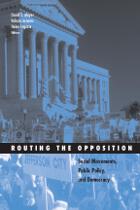 Routing the Opposition: Social Movements, Public Policy, and Democracy
David S. Meyer
University of Minnesota Press, 2005 On one side are the policy makers, on the other, the movements and organizations that challenge public policy. Where and how the two meet is a critical juncture in the democratic process. Bringing together a distinguished group of scholars from several different disciplines in the social sciences, Routing the Opposition connects the substance and content of policies with the movements that create and respond to them. Local antidrug coalitions, the organic agriculture movement, worker's compensation reforms, veterans' programs, prison reform, immigrants' rights campaigns: these are some of the diverse areas in which the contributors to this volume examine the linkages between the practices, organization, and institutional logic of public policy and social movements. The authors engage such topics as the process of involving multiple stakeholders in policy making, the impact of overlapping social networks on policy and social movement development, and the influence of policy design on the increase or decline of civic involvement. Capturing both successes and failures, Routing the Opposition focuses on strategies and outcomes that both transform social movements and guide the development of public policy, revealing as well what happens when the very different organizational cultures of activists and public policy makers interact.
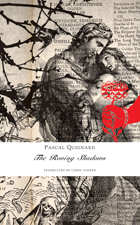 The Roving Shadows
Pascal Quignard
Seagull Books, 2011 There are few if any voices more distinct in contemporary French literature than that of Pascal Quignard, a prolific writer of rare erudition and elegance. Essayist, critic, translator, novelist and musician, Quignard attempts here an ambitious amalgam of his many artistic styles in a fragmentary work that defies the idea of genre. And his daring was rewarded in 2002 when The Roving Shadows became the first non-novel in more than sixty years to win the Goncourt Prize, France’s most prestigious literary award.
The first book in Quignard’s Last Kingdom series, The Roving Shadows can be read as a long meditation on reading and writing that strives to situate these otherwise innocuous activities in a profound relationship to sex and death. Writing and reading can in fact be linked to our animal natures and artistic strivings, to primal forces and culturally persistent fascinations. With dexterity and inventiveness, Quignard weaves together historical anecdotes, folktales from the East and West, fragments of myth, and speculative historical reconstructions. The whole, written in a musical style not far removed from that of Couperin, whose piano composition Les Ombres errantes lends the book its title, coheres into a work of literature that reverberates in the psyche long after one has laid it down.
The Roving Shadows is a rare and wondrous tour de force that cements Quignard’s reputation in contemporary world literature. Available now for the first time in English, this boldly adventurous work will find a new and welcoming audience.
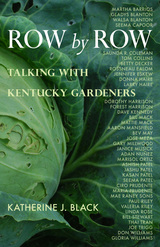 Row by Row: Talking with Kentucky Gardeners
Katherine J. Black
Ohio University Press, 2015 For two and a half years, Katherine J. Black crisscrossed Kentucky, interviewing home vegetable gardeners from a rich variety of backgrounds. Row by Row: Talking with Kentucky Gardeners is the result, a powerful compilation of testimonies on the connections between land, people, culture, and home.
The people profiled here share a Kentucky backdrop, but their life stories, as well as their gardens, have as many colors, shapes, and tastes as heirloom tomatoes do. Black interviewed those who grow in city backyards, who carve out gardens from farmland, and who have sprawling plots in creek bottoms and former pastures. Many of the gardeners in Row by Row speak eloquently about our industrialized food system’s injuries to the land, water, and health of people. But more often they talk about what they are doing in their gardens to reverse this course.
Row by Row is as sure to appeal to historians, food studies scholars, and sustainability advocates as it is to gardeners and local food enthusiasts. These eloquent portraits, drawn from oral histories and supplemented by Deirdre Scaggs’ color photographs, form a meditation on how gardeners make sense of their lives through what they grow and how they grow it.
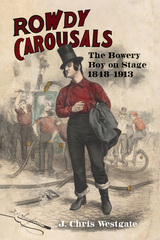 Rowdy Carousals: The Bowery Boy on Stage, 1848-1913
J. Chris Westgate
University of Iowa Press, 2024 Rowdy Carousals makes important interventions in nineteenth-century theatre history with regard to the Bowery Boy, a raucous, white, urban character most famously exemplified by Mose from A Glance at New York in 1848. Theatrical representations of the Bowery Boy emphasized the privileges of whiteness against nonwhite workers including enslaved and free African Americans during the Antebellum Period, an articulation of white superiority that continued through the early twentieth century with Jewish, Italian, and Chinese immigrants.
The book’s examination of working-class whiteness on stage, in the theatre, and in print culture invites theatre historians and critics to check the impulse to downplay or ignore questions about race and ethnicity in discussion of the Bowery Boy. J. Chris Westgate further explores links between the Bowery Boy’s rowdyism in the nineteenth century and the resurgence of white supremacy in the early twenty-first century.
Rowdy Tales from Early Alabama: The Humor of John Gorman Barr
John Gorman Barr
University of Alabama Press, 1989 The rollicking tales of Old Southwestern humor were a distinctive contribution to American folk culture provided by the frontiersmen of the South and Southwest, a tradition brought to its highest form in the work of Mark Twain. Among the precursors of Twain was John Gorman Barr of Tuscaloosa, Alabama. Like Twain, Barr grew up in a river town, worked in a printing office, and traveled widely; and again like Twain, Barr drew upon the people and places of his home region as the primary sources for his tales.
In addition to the pure entertainment Barr’s stories provide, they also furnish a comprehensive picture of Tuscaloosa and western Alabama in the 1850s—the roaring river town coexisting uneasily with the intellectual sophistication of the recently established University of Alabama.
 Rowing in Eden: Rereading Emily Dickinson
By Martha Nell Smith
University of Texas Press, 1992 Emily Dickinson wrote a "letter to the world" and left it lying in her drawer more than a century ago. This widely admired epistle was her poems, which were never conventionally published in book form during her lifetime. Since the posthumous discovery of her work, general readers and literary scholars alike have puzzled over this paradox of wanting to communicate widely and yet apparently refusing to publish. In this pathbreaking study, Martha Nell Smith unravels the paradox by boldly recasting two of the oldest and still most frequently asked questions about Emily Dickinson: Why didn't she publish more poems while she was alive? and Who was her most important contemporary audience? Regarding the question of publication, Smith urges a reconception of the act of publication itself. She argues that Dickinson did publish her work in letters and in forty manuscript books that circulated among a cultured network of correspondents, most important of whom was her sister-in-law, Susan Huntington Gilbert Dickinson. Rather than considering this material unpublished because unprinted, Smith views its alternative publication as a conscious strategy on the poet's part, a daring poetic experiment that also included Dickinson's unusual punctuation, line breaks, stanza divisions, calligraphic orthography, and bookmaking—all the characteristics that later editors tried to standardize or eliminate in preparing the poems for printing. Dickinson's relationship with her most important reader, Sue Dickinson, has also been lost or distorted by multiple levels of censorship, Smith finds. Emphasizing the poet-sustaining aspects of the passionate bonds between the two women, Smith shows that their relationship was both textual and sexual. Based on study of the actual holograph poems, Smith reveals the extent of Sue Dickinson's collaboration in the production of poems, most notably "Safe in Their Alabaster Chambers." This finding will surely challenge the popular conception of the isolated, withdrawn Emily Dickinson. Well-versed in poststructuralist, feminist, and new textual criticism, Rowing in Eden uncovers the process by which the conventional portrait of Emily Dickinson was drawn and offers readers a chance to go back to original letters and poems and look at the poet and her work through new eyes. It will be of great interest to a wide audience in literary and feminist studies.
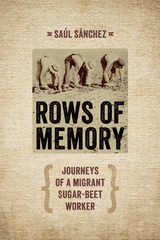 Rows of Memory: Journeys of a Migrant Sugar-Beet Worker
Saul Sanchez
University of Iowa Press, 2014 Every year from April to October, the Sánchez family traveled—crowded in the back of trucks, camping in converted barns, tending and harvesting crops across the breadth of the United States. Although hoeing sugar beets with a short hoe was their specialty, they also picked oranges in California, apples in Washington, cucumbers in Michigan, onions and potatoes in Wisconsin, and tomatoes in Iowa. Winters they returned home to the Winter Garden region of South Texas. In 1951, Saúl Sánchez began to contribute to his family’s survival by helping to weed onions in Wind Lake, Wisconsin. He was eight years old.
Rows of Memory tells his story and the story of his family and other migrant farm laborers like them, people who endured dangerous, dirty conditions and low pay, surviving because they took care of each other. Facing racism both on the road and at home, they lived a largely segregated life only occasionally breached by friendly employers.
Despite starting school late and leaving early every year and having to learn English on the fly, young Saúl succeeded academically. At the same time that Mexican Americans in South Texas upended the Anglo-dominated social order by voting their own leaders into local government, he upended his family’s order by deciding to go to college. Like many migrant children, he knew that his decision to pursue an education meant he would no longer be able to help feed and clothe the rest of his family. Nevertheless, with his parents’ support, he went to college, graduating in 1967 and, after a final display of his skill with a short hoe for his new friends, abandoned migrant labor for teaching.
In looking back at his youth, Sánchez invites us to appreciate the largely unrecognized and poorly rewarded strength and skill of the laborers who harvest the fruits and vegetables we eat. A first-person portrait of life on the bottom rung of the food system, this coming-of-age tale illuminates both the history of Latinos in the United States and the human consequences of industrial agriculture.
Roxana's Children: The Biography of a Nineteenth-Century Vermont Family
Lynn A. Bonfield
University of Massachusetts Press, 1995 Roxana's Children is a well-researched and well written biography of Roxana Brown Walbridge Watts (1802-62) and her descendants. The book is constructed from the descendants' 300 preserved letters, 30 diaries, and photographs from the family's village life during 19th-century Vermont. Bonfield and Morrison use these sources to discuss social change and movement in American life.
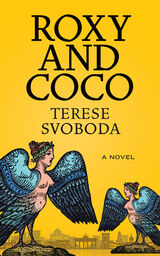 Roxy and Coco: A Novel
Terese Svoboda
West Virginia University Press, 2024 Roxy and Coco, sisters and glamorous harpies (mythical bird women), work to save the world by stopping child abuse, while also trying to evade capture. For readers of Neil Gaiman and Karen Russell.
“[A] wry and rambunctious fable….The book offers brief and staggered visions of family, in all its complex permutations. Here, flocks settle into wonderfully unlikely formations. It’s possible that the most dangerous thing for anyone, harpy or human, is the decision to fly alone.”
— Hilary Leichter, New York Times Book Review
Sisters Roxy and Coco are two glamorous harpies—mythical bird women—attempting to outrun extinction and fix the planet by preventing child abuse, one child at a time.
When Roxy is suddenly attracted to her human supervisor at a social work agency a hundred years too early, Coco is very suspicious. Luring Roxy with his scent, Tim is also on the payroll of a fake conservationist intent on her less-than-legal collection. Coco swoops in to vet Tim, but Interpol is hot on her trail for a series of curious homicides. (Surveillance has a very hard time convincing his boss of what he’s monitoring.) When the sisters find themselves trapped, Chris, a bipolar skateboarding truant, tries his best to rescue them but it’s Stewie, Coco’s colleague, who turns the story inside out. Roxy and Coco climaxes at a gala of egg fanciers who scramble to escape the harpies’ talons.
Action figure–worthy, for readers of Neil Gaiman and Karen Russell, this modern take on these fabled women touches on mental illness, racism, animal rights, and the rights of children.
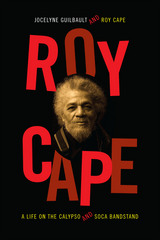 Roy Cape: A Life on the Calypso and Soca Bandstand
Jocelyne Guilbault and Roy Cape
Duke University Press, 2014 Roy Cape is a Trinidadian saxophonist active as a band musician for more than fifty years and as a bandleader for more than thirty. He is known throughout the islands and the Caribbean diasporas in North America and Europe. Part ethnography, part biography, and part Caribbean music history, Roy Cape is about the making of reputation and circulation, and about the meaning of labor and work ethics. An experiment in storytelling, it joins Roy's voice with that of ethnomusicologist Jocelyne Guilbault. The idea for the book emerged from an exchange they had while discussing Roy's journey as a performer and bandleader. In conversation, they began experimenting with voice, with who takes the lead, who says what, when, to whom, and why. Their book reflects that dynamic, combining first-person narrative, dialogue, and the polyphony of Roy's bandmates' voices. Listening to recordings and looking at old photographs elicited more recollections, which allowed Roy to expand on recurring themes and motifs. This congenial, candid book offers different ways of knowing Roy's labor of love—his sound and work through sound, his reputation and circulation as a renowned musician and bandleader in the world.
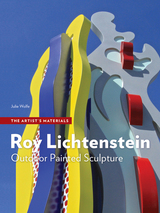 Roy Lichtenstein: Outdoor Painted Sculpture
Julie Wolfe
J. Paul Getty Trust, The The first book-length study to examine the materials and techniques used in the fabrication and painting of the American pop artist Roy Lichtenstein’s outdoor sculpture.
Vibrant color was essential to the paintings of the American pop artist Roy Lichtenstein (1923–1997), and when he began exploring the creation of outdoor sculpture in the late 1970s, vivid hues remained an important part of his artistic vocabulary. Today, preserving these remarkable works after they have endured decades in outdoor environments around the world is an issue of pressing concern.
This abundantly illustrated volume is based on extensive archival research of Lichtenstein’s studio materials, interviews with his assistants, and a thorough technical analysis of the sculpture Three Brushstrokes. The book concludes with a chapter showing various options for the care, conservation, and restoration of his sculptural works, making this an essential resource for conservators, curators, and others interested both in the iconic artist and modern sculpture in general.
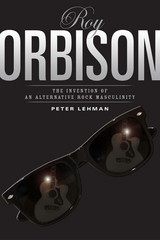 Roy Orbison: Invention Of An Alternative Rock Masculinity
Peter Lehman
Temple University Press, 2003 Roy Orbison's music—whether heard in his own recordings or in cover versions of his songs—is a significant part of contemporary American culture despite the fact that he died almost a generation ago. Few of today's listeners know or remember how startlingly unique he seemed at the height of his career in the early 1960s. In this book, Peter Lehman looks at the long span of Orbison's career and probes into the uniqueness of his songs, singing, and performance style, arguing that singer/songwriters no less than filmmakers can be considered as auteurs.Unlike other pop stars, Orbison was a constant presence on the Top 40, but virtually invisible in the media during his heyday. Ignoring the conventions of pop music, he wrote complex songs and sang them with a startling vocal range and power. Wearing black clothes and glasses and standing motionless on stage, he rejected the macho self confidence and strutting that characterized the male rockers of his time. He sang about a man lost in a world of loneliness and fear, one who cried in the dark or escaped into a dream world, the only place his desires could be fulfilled. This was a man who reveled in passivity, pain, and loss.Lehman traces Orbison's development of this alternative masculinity and the use of his music in films by Wim Wenders and David Lynch. Widely admired by fellow musicians from Elvis to Jagger, Springsteen and Bono, Orbison still attracts new listeners. As a devoted fan and insightful scholar, Lehman gives us a fascinating account of "the greatest white singer on the planet," and a new approach to understanding individual singer/songwriters.
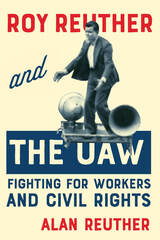 Roy Reuther and the UAW: Fighting for Workers and Civil Rights
Alan Reuther
Michigan State University Press, 2025 This biography of Roy Reuther examines his tumultuous life, including the triumphs and tragedies in the labor and civil rights movements. It also serves as a cautionary tale about the dangers activists may face as they confront entrenched societal powers. As the brother of famed labor leader Walter Reuther, Roy was a key figure in the historic Flint sit-down strike that gave birth to the United Auto Workers (UAW). He became the political director of the UAW and was deeply involved in struggles to pass civil rights legislation. This book explores his passion for increasing voter participation and his vow to help downtrodden farmworkers.
Many of the injustices that Reuther fought continue to plague America today. This book provides important context for the current efforts of workers to organize, for the Black Lives Matter movement, and for efforts to reform the filibuster rule and stop voter suppression. It shows how dedicated individuals can overcome enormous odds to win great victories for social justice and emphasizes the potential connections between the labor and civil rights movements, offering hope for a more just future.
 Roy Strong: Self-Portrait as a Young Man
Roy Strong
Bodleian Library Publishing, 2013 For nearly half a century, Roy Strong has been a prominent presence in Britain’s art world. Yet little is known about his life before the Swinging Sixties, when, at the age of thirty-one, he came on the scene as the revolutionary young director of London’s National Portrait Gallery.
In this book, Strong recounts his early years and the stirrings of what would become a lifelong passion for art. During a childhood spent in suburban North London, Strong recalls himself as a shy and solitary boy who spent his time painting Elizabethan miniatures and Shakespearean set designs. The book follows his progression through grammar school, which he attended alongside Alan Bennett and David Hockney, and university, where he developed a love of learning and enjoyed visits to the theater, opera, and ballet. With remarkable honesty, he explores the important relationships in his life—family, friends, and a schoolteacher with whom he maintained a long correspondence—as well as his debt to figures like Cecil Beaton, Frances Yates, C. V. Wedgwood, and A. L. Rowse.
Richly illustrated throughout with photographs, drawings, and letters, this book offers a compelling look at a young man poised for success.
Royal Apologetic in the Ancient Near East
Andrew Knapp
SBL Press, 2015 A fresh exploration of apologetic material that pushes beyond form criticism
Andrew Knapp applies modern genre theory to seven ancient Near Eastern royal apologies that served to defend the legitimacy of kings who came to power under irregular circumstances. Knapp examines texts and inscriptions related to Telipinu, Hattusili III, David, Solomon, Hazael, Esarhaddon, and Nabonidus to identify transhistorical common issues that unite each discourse.
Features:
- Compares Hittite, Israelite, Aramean, Assyrian, and Babylonian apologies
- Examination of apologetic as a mode instead of a genre
- Charts and illustrations
The Royal Baker's Daughter: Royal Baker's Daughter
Barbara Goldberg
University of Wisconsin Press, 2008 Winner of the 2008 Felix Pollak Prize in Poetry, selected by David St. John These poems, at once elegant and earthy, reveal the inner workings of the human psyche and show us that sometimes the best defense against terror is making mischief. The Royal Baker’s Daughter was raised on a diet of stone soup and the occasional leftover royal treat. This leaves her with an appetite for authenticity. With nothing but her two deft hands to guide her, she embarks on a journey into the dark forest, “where sticks and stones and absolutes reign and nothing, even sin, is original.” Best Fall book from the Montserrat Review
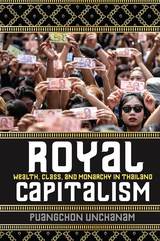 Royal Capitalism: Wealth, Class, and Monarchy in Thailand
Puangchon Unchanam
University of Wisconsin Press, 2022 Thanks to its active role in national politics, the market economy, and popular culture, the Thai crown remains both the country's dominant institution and one of the world's wealthiest monarchies. Puangchon Unchanam examines the reign of Thailand's King Bhumibol Adulyadej or Rama IX (1946–2016) and how the crown thrived by transforming itself into a distinctly "bourgeois" monarchy that co-opted middle-class values of hard work, frugality, and self-sufficiency.
The kingdom positioned itself to connect business elites, patronize local industries, and form strategic partnerships with global corporations. Instead of restraining or regulating royal power, white-collar workers joined with the crown to form a dynamic, symbiotic force that has left the lower classes to struggle in their wake. Unchanam presents a surprising case study that kings and queens live long and large in cooperation with the bourgeoisie's interests and ideology.
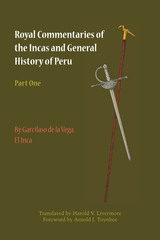 Royal Commentaries of the Incas and General History of Peru, Part One
By Garcilaso de la Vega; translated by Harold V. Livermore
University of Texas Press, 1966 Garcilaso de la Vega, the first native of the New World to attain importance as a writer in the Old, was born in Cuzco in 1539, the illegitimate son of a Spanish cavalier and an Inca princess. Although he was educated as a gentleman of Spain and won an important place in Spanish letters, Garcilaso was fiercely proud of his Indian ancestry and wrote under the name EI Inca. Royal Commentaries of the Incas is the account of the origin, growth, and destruction of the Inca empire, from its legendary birth until the death in 1572 of its last independent ruler. For the material in Part One of Royal Commentaries—the history of the Inca civilization prior to the arrival of the Spaniards—Garcilaso drew upon "what I often heard as a child from the lips of my mother and her brothers and uncles and other elders . . . [of] the origin of the Inca kings, their greatness, the grandeur of their empire, their deeds and conquests, their government in peace and war, and the laws they ordained so greatly to the advantage of their vassals." The conventionalized and formal history of an oral tradition, Royal Commentaries describes the gradual imposition of order and civilization upon a primitive and barbaric world. To this Garcilaso adds facts about the geography and the flora and fauna of the land; the folk practices, religion, and superstitions; the agricultural and the architectural and engineering achievements of the people; and a variety of other information drawn from his rich store of traditional knowledge, personal observation, or speculative philosophy. Important though it is as history, Garcilaso's classic is much more: it is also a work of art. Its gracious and graceful style, skillfully translated by Harold V. Livermore, succeeds in bringing to life for the reader a genuine work of literature. Part One covers the history of the Incas up to the arrival of the Spanish.
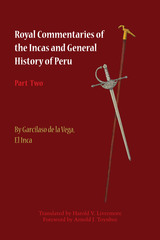 Royal Commentaries of the Incas and General History of Peru, Part Two
By Garcilaso de la Vega; translated by Harold V. Livermore
University of Texas Press, 1966 Garcilaso de la Vega, the first native of the New World to attain importance as a writer in the Old, was born in Cuzco in 1539, the illegitimate son of a Spanish cavalier and an Inca princess. Although he was educated as a gentleman of Spain and won an important place in Spanish letters, Garcilaso was fiercely proud of his Indian ancestry and wrote under the name El Inca. Royal Commentaries of the Incas is the account of the origin, growth, and destruction of the Inca empire, from its legendary birth until the death in 1572 of its last independent ruler. For the material in Part One of Royal Commentaries—the history of the Inca civilization prior to the arrival of the Spaniards—Garcilaso drew upon "what I often heard as a child from the lips of my mother and her brothers and uncles and other elders . . . [of] the origin of the Inca kings, their greatness, the grandeur of their empire, their deeds and conquests, their government in peace and war, and the laws they ordained so greatly to the advantage of their vassals." The conventionalized and formal history of an oral tradition, Royal Commentaries describes the gradual imposition of order and civilization upon a primitive and barbaric world. To this Garcilaso adds facts about the geography and the flora and fauna of the land; the folk practices, religion, and superstitions; the agricultural and the architectural and engineering achievements of the people; and a variety of other information drawn from his rich store of traditional knowledge, personal observation, or speculative philosophy. Important though it is as history, Garcilaso's classic is much more: it is also a work of art. Its gracious and graceful style, skillfully translated by Harold V. Livermore, succeeds in bringing to life for the reader a genuine work of literature. Part Two covers the Spanish conquest of the Incas.
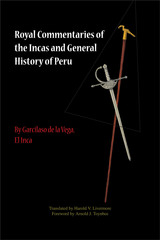 Royal Commentaries of the Incas and General History of Peru, Parts One and Two
Garcilaso de la Vega
University of Texas Press, 2014 Garcilaso de la Vega, the first native of the New World to attain importance as a writer in the Old, was born in Cuzco in 1539, the illegitimate son of a Spanish cavalier and an Inca princess. Although he was educated as a gentleman of Spain and won an important place in Spanish letters, Garcilaso was fiercely proud of his Indian ancestry and wrote under the name El Inca. Royal Commentaries of the Incas is the account of the origin, growth, and destruction of the Inca empire, from its legendary birth until the death in 1572 of its last independent ruler. For the material in Part One of Royal Commentaries—the history of the Inca civilization prior to the arrival of the Spaniards—Garcilaso drew upon "what I often heard as a child from the lips of my mother and her brothers and uncles and other elders . . . [of] the origin of the Inca kings, their greatness, the grandeur of their empire, their deeds and conquests, their government in peace and war, and the laws they ordained so greatly to the advantage of their vassals." The conventionalized and formal history of an oral tradition, Royal Commentaries describes the gradual imposition of order and civilization upon a primitive and barbaric world. To this Garcilaso adds facts about the geography and the flora and fauna of the land; the folk practices, religion, and superstitions; the agricultural and the architectural and engineering achievements of the people; and a variety of other information drawn from his rich store of traditional knowledge, personal observation, or speculative philosophy. Important though it is as history, Garcilaso's classic is much more: it is also a work of art. Its gracious and graceful style, skillfully translated by Harold V. Livermore, succeeds in bringing to life for the reader a genuine work of literature.
 Royal Fraud: The Story of Albania’s First and Last King
Robert Austin
Central European University Press, 2024 Beginning its narrative in 1961, when Albanian King Zog I died in a Paris hospital after 22 years in exile, this book tells the colourful story of this Balkan country's first and only monarch. The road to becoming Europe's youngest president in 1925 and then king of Albania in 1928 was paved with feuds and assassinations, a political career-path common in the region. He craved the throne for several reasons; the Balkans were mostly run by kings, and Zog wanted to impress his mother and also give his six sisters an easy social rise. Once king, his accomplishments were decidedly meagre. He spent most of his time keeping up appearances as a monarch despite the obvious fraud he had imposed on an illiterate and uninterested population. His one great success was that he had almost all his opponents assassinated, usually in broad daylight abroad. Zog retained his power until his "friend" Mussolini ousted him in 1939. On the surface a Westernizer, this self-proclaimed ruler left Albania almost as he found it, with almost no roads or trains, thoroughly uneducated and utterly impoverished. In his book, Robert Austin combines Zog’s adventurous life story with a studious analysis of Albania's political history from the fall of the Ottoman Empire to the threshold of Euro-Atlantic integration.
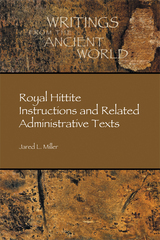 Royal Hittite Instructions and Related Administrative Texts
Jared L. Miller
SBL Press, 2013 Few compositions provide as much insight into the structure of the Hittite state and the nature of Hittite society as the so-called Instructions. While these texts may strike the modern reader as didactic, the Hittites, who categorized them together with state treaties, understood them as “contracts” or “obligations,” consisting of the king’s instructions to officials such as priests and temple personnel, mayors, military officers, border garrison commanders, and palace servants. They detail how and in what spirit the officials are to carry out their duties and what consequences they are to suffer for failure. Also included are several examples of closely related oath impositions and oaths. Collecting for the first time the entire corpus of Hittite Instructions, this accessible volume presents these works in transliteration of the original texts and translation, with clear and readable introductory essays, references to primary and secondary sources, and thorough indices.
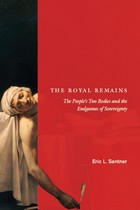 The Royal Remains: The People's Two Bodies and the Endgames of Sovereignty
Eric L. Santner
University of Chicago Press, 2011 "The king is dead. Long live the king!" In early modern Europe, the king's body was literally sovereign—and the right to rule was immediately transferrable to the next monarch in line upon the king's death. In The Royal Remains, Eric L. Santner argues that the "carnal" dimension of the structures and dynamics of sovereignty hasn't disappeared from politics. Instead, it migrated to a new location—the life of the people—where something royal continues to linger in the way we obsessively track and measure the vicissitudes of our flesh.
Santner demonstrates the ways in which democratic societies have continued many of the rituals and practices associated with kingship in displaced, distorted, and usually, unrecognizable forms. He proposes that those strange mental activities Freud first lumped under the category of the unconscious—which often manifest themselves in peculiar physical ways—are really the uncanny second life of these "royal remains," now animated in the body politic of modern neurotic subjects. Pairing Freud with Kafka, Carl Schmitt with Hugo von Hofmannsthal,and Ernst Kantorowicz with Rainer Maria Rilke, Santner generates brilliant readings of multiple texts and traditions of thought en route to reconsidering the sovereign imaginary. Ultimately, The Royal Remains locates much of modernity—from biopolitical controversies to modernist literary experiments—in this transition from subjecthood to secular citizenship.
This major new work will make a bold and original contribution to discussions of politics, psychoanalysis, and modern art and literature.
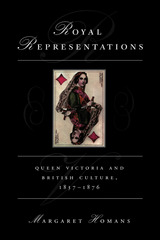 Royal Representations: Queen Victoria and British Culture, 1837-1876
Margaret Homans
University of Chicago Press, 1998 Queen Victoria was one of the most complex cultural productions of her age. In Royal Representations, Margaret Homans investigates the meanings Victoria held for her times, Victoria's own contributions to Victorian writing and art, and the cultural mechanisms through which her influence was felt.
Arguing that being, seeming, and appearing were crucial to Victoria's "rule," Homans explores the variability of Victoria's agency and of its representations using a wide array of literary, historical, and visual sources. Along the way she shows how Victoria provided a deeply equivocal model for women's powers in and out of marriage, how Victoria's dramatic public withdrawal after Albert's death helped to ease the monarchy's transition to an entirely symbolic role, and how Victoria's literary self-representations influenced debates over political self-representation.
Homans considers versions of Victoria in the work of Elizabeth Barrett Browning, George Eliot, John Ruskin, Margaret Oliphant, Lewis Carroll, Alfred Lord Tennyson, and Julia Margaret Cameron.
 Royal Succession in Capetian France: Studies on Familial Order and the State
Andrew W. Lewis
Harvard University Press, 1981 In this new approach to the history of medieval kings, Andrew W. Lewis views French royal succession not within the traditional “constitutional” framework, but in terms of family strategy and the relation of the family to the tenure of office and lands. For the succession involved not only the devolution of the crown to the eldest son, but the fate of the entire family group and its possessions. Thus Lewis takes into account the family's view of itself, the provisions made for cadet sons and for daughters, the nature of their property rights, the bonds and obligations within the family group, and contemporary notions of kingship and kingdom. Within this context, motives and behavior that previously seemed idiosyncratic are now clear. The cumulative effect significantly alters the traditional conception of the Capetian monarchy and thus illuminates a central aspect of medieval French history.
The Royal Treasuries of the Spanish Empire in America: Vol. 1: Peru
John J. Tepaske and Herbert S. Klein, editors
Duke University Press, 1982 The Royal Treasuries of the Spanish Empire in America provides records of Spanish colonial treasuries of various New World administrative centers. In this volume, the fourth in the series, the authors have compiled quantitative date on the fiscal structure of the presidency of Quito that will be an invaluable source for reconstructing the economic, political, and social history of eighteenth-century Ecuador.
The Royal Treasuries of the Spanish Empire in America: Vol. 2: Upper Peru (Bolivia)
John J. Tepaske and Herbert S. Klein, editors
Duke University Press, 1982 The Royal Treasuries of the Spanish Empire in America provides records of Spanish colonial treasuries of various New World administrative centers. In this volume, the fourth in the series, the authors have compiled quantitative date on the fiscal structure of the presidency of Quito that will be an invaluable source for reconstructing the economic, political, and social history of eighteenth-century Ecuador.
The Royal Treasuries of the Spanish Empire in America: Vol. 3: Chile and Rio de la Plata
John J. Tepaske and Herbert S. Klein, editors
Duke University Press, 1982 The Royal Treasuries of the Spanish Empire in America provides records of Spanish colonial treasuries of various New World administrative centers. In this volume, the fourth in the series, the authors have compiled quantitative date on the fiscal structure of the presidency of Quito that will be an invaluable source for reconstructing the economic, political, and social history of eighteenth-century Ecuador.
The Royal Treasuries of the Spanish Empire in America: Vol. 4, Eighteenth-Century Ecuador
Alvaro Jara and John Jay TePaske, eds.
Duke University Press The Royal Treasuries of the Spanish Empire in America provides records of Spanish colonial treasuries of various New World administrative centers. In this volume, the fourth in the series, the authors have compiled quantitative date on the fiscal structure of the presidency of Quito that will be an invaluable source for reconstructing the economic, political, and social history of eighteenth-century Ecuador.
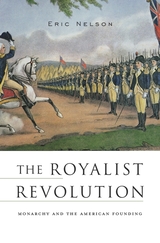 The Royalist Revolution: Monarchy and the American Founding
Eric Nelson
Harvard University Press, 2014 Winner of the Society of the Cincinnati History Prize, Society of the Cincinnati in the State of New Jersey
Finalist, George Washington Prize
A Choice Outstanding Academic Title of 2015
Generations of students have been taught that the American Revolution was a revolt against royal tyranny. In this revisionist account, Eric Nelson argues that a great many of our “founding fathers” saw themselves as rebels against the British Parliament, not the Crown. The Royalist Revolution interprets the patriot campaign of the 1770s as an insurrection in favor of royal power—driven by the conviction that the Lords and Commons had usurped the just prerogatives of the monarch.
“The Royalist Revolution is a thought-provoking book, and Nelson is to be commended for reviving discussion of the complex ideology of the American Revolution. He reminds us that there was a spectrum of opinion even among the most ardent patriots and a deep British influence on the political institutions of the new country.”
—Andrew O’Shaughnessy, Wall Street Journal
“A scrupulous archaeology of American revolutionary thought.”
—Thomas Meaney, The Nation
“A powerful double-barrelled challenge to historiographical orthodoxy.”
—Colin Kidd, London Review of Books
“[A] brilliant and provocative analysis of the American Revolution.”
—John Brewer, New York Review of Books
 Royko in Love: Mike's Letters to Carol
Mike Royko
University of Chicago Press, 2010 Street-smart, wickedly funny, piercingly perceptive, and eloquent enough to win a Pulitzer Prize, Mike Royko continues to have legions of devoted fans who still wonder “what Royko would have said” about some outrageous piece of news. One thing he hardly ever wrote or talked about, though, was his private life, especially the time he shared with his first wife, Carol. She was the love of his life, and her premature death at the age of forty-four shook him to his soul. Mike’s unforgettable public tribute to Carol was a heart-wrenching column written on what would have been her forty-fifth birthday, “November Farewell.” His most famous and requested piece, it was the end of an untold story.
Royko in Love offers that story’s moving and utterly beguiling beginning in letters that “Mick” Royko, then a young airman, wrote to his childhood sweetheart, Carol Duckman. He had been in love with her since they were kids on Chicago’s northwest side, but she was a beauty and he was, well, anything but. Before leaving for Korea, he was crushed to hear she was getting married, but after returning to Blaine Air Force Base in Washington, he learned she was getting a divorce. Mick soon began to woo Carol in a stream of letters that are as fervent as they are funny. Collected here for the first time, Royko’s letters to Carol are a mixture of sweet seduction, sarcastic observations on military life, a Chicago kid’s wry view of rural folk, the pain of self-doubt, and the fear of losing what is finally so close, but literally so far. His only weapons against Carol’s many suitors were his pen, his ardor, and his brilliance. And they won her heart.
Roze & Blud: a poem
Jayson Iwen
University of Arkansas Press, 2020 Winner, 2020 Miller Williams Poetry Prize Winner, 2020-2021 Northeastern Minnesota Book Award In this long poem—almost a novel-in-verse—Jayson Iwen examines the intimate thoughts and feelings of two would-be poets: Roze Mertha, a teenage girl growing up in a trailer park, and William Blud, a veteran navigating age and loneliness in an apartment he shares with an Afghan refugee. Deftly crafting distinct voices for these characters in the upper midwestern terrain they inhabit, Iwen explores the quiet heartbreak and tenderly treasured experiences of two apparently unremarkable people using poetry to understand a world that doesn’t make much space for them.
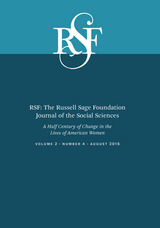 RSF: The Russell Sage Foundation Journal of the Social Sciences: A Half a Century of Change in the Lives of American Women
Martha J. Bailey
Russell Sage Foundation, 2016 Over the last fifty years, American women have made considerable social and economic gains. They now make up half of the workforce, enroll in college at higher rates than men, and hold a larger share of the most prestigious jobs and political offices than in the past. Yet, their collective progress has slowed or stalled in other ways, including an enduring gender wage gap and continued underrepresentation in STEM occupations and other fields. In this special issue of RSF, edited by Martha J. Bailey and Thomas A. DiPrete, a multidisciplinary group of social scientists explores half a century of women’s changing work and family roles and analyzes the implications of these shifts for gender equality.
The contributors examine trends in women’s participation in the labor market, focusing on how working both shapes and is shaped by women’s roles within their families. Tanya Byker investigates the so-called “opt-out revolution” and finds that, surpringly, the rate of “opting out” has been constant for the last twenty years even as women’s labor-force participation and pay has increased. Ipshita Pal and Jane Waldfogel show that the “motherhood penalty” is shrinking and may even reversing for mothers who are married, white, or highly educated. And while marriages in which women out-earned their husbands were once more susceptible to divorce, Christine Schwartz and Pilar Gonalons-Pons show that this relationship has essentially disappeared, suggesting that the growing economic advantage of a high-earning wife has facilitated a revolution in traditional gender roles. Despite these gains, Kim Weeden and co-authors show that the growth of jobs requiring more than 50 hours of work per week, which are disproportionately filled by men, has played an increasing role in perpetuating the gender pay gap. Similarly, Katherine Michelmore and Sharon Sassler find that within STEM fields, a gender pay gap persists partly because women are still more likely to work in lower-paid occupations.
The rapid advancement of women in education and the workforce was a distinguishing feature of the twentieth century, even though barriers to opportunities for women still exist. . Together, the articles in this issue of RSF provide insightful context for these achievements and describe women’s evolving status in society.
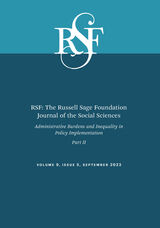 RSF: The Russell Sage Foundation Journal of the Social Sciences: Administrative Burden and Inequality in Policy implementation
Pamela Herd
Russell Sage Foundation, 2023 Copy refers to RSF, Volume 9, issues 4 & 5
Administrative burdens are the learning, compliance, and psychological costs that individuals incur during encounters with public services. While some burdens are created unintentionally, others are deliberately constructed as barriers to limit claims to programs and services. Often, burdens fall most heavily on marginalized groups, preventing them from resources they need. In this double issue of RSF public administration scholar Pamela Herd, economist Hilary Hoynes, political scientists Jamila Michener and Donald Moynihan, and an interdisciplinary group of contributors explore how administrative burdens shape inequality.
Issue 1 examines how administrative burdens impact Medicaid and health inequality, student loan repayment programs, and immigration to the U.S. Emily Rauscher and Ailish Burns find that combinations of reforms to reduce administrative burdens in the late 1980s increased Medicaid enrollment and improved infant health nearly as much as Medicaid expansion. Adam Goldstein and colleagues show that administrative burdens in enrolling in income-driven repayment student loan programs causes borrowers with lower socioeconomic status to be disproportionately excluded from these programs. Lilly Yu finds that dramatic changes to immigration law and policy during the Trump Administration led immigration lawyers to inadvertently exacerbate inequality among undocumented and vulnerable immigrants’ access to legal representation.
Issue 2 looks at the role of administrative burdens in experiences with child and family support programs, the child welfare system, disaster and housing relief programs, and housing support programs. Carolyn Barnes and colleagues find that mothers’ perceptions of the costs and benefits of participation in the Special Supplemental Nutrition Assistance Program for Women, Infants, and Children (WIC) vary over time and influence whether they choose to enroll or continue participating in the program. Ethan J. Raker and Tyler M. Woods find applications from poor communities of color for Federal Emergency Management Agency (FEMA) housing aid after Hurricanes Katrina and Rita were disproportionately denied or delayed due to burdensome program requirements and implementation. Stephanie Casey Pierce and Stephanie Moulton reveal that reforms to reduce administrative burden in foreclosure programs are associated with a significant increase in the rate of benefit receipt and decrease in the foreclosure rate. Frank Edwards and colleagues show child welfare system-involved parents must navigate considerable administrative burdens in order to retain custody of their children.
This volume of RSF sheds light on the origins, experiences, and consequences of administrative burdens.
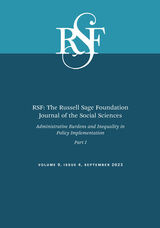 RSF: The Russell Sage Foundation Journal of the Social Sciences: Administrative Burden and Inequality in Policy implementation
Pamela Herd
Russell Sage Foundation, 2023 Copy refers to RSF, Volume 9, issues 4 & 5
Administrative burdens are the learning, compliance, and psychological costs that individuals incur during encounters with public services. While some burdens are created unintentionally, others are deliberately constructed as barriers to limit claims to programs and services. Often, burdens fall most heavily on marginalized groups, preventing them from resources they need. In this double issue of RSF public administration scholar Pamela Herd, economist Hilary Hoynes, political scientists Jamila Michener and Donald Moynihan, and an interdisciplinary group of contributors explore how administrative burdens shape inequality.
Issue 1 examines how administrative burdens impact Medicaid and health inequality, student loan repayment programs, and immigration to the U.S. Emily Rauscher and Ailish Burns find that combinations of reforms to reduce administrative burdens in the late 1980s increased Medicaid enrollment and improved infant health nearly as much as Medicaid expansion. Adam Goldstein and colleagues show that administrative burdens in enrolling in income-driven repayment student loan programs causes borrowers with lower socioeconomic status to be disproportionately excluded from these programs. Lilly Yu finds that dramatic changes to immigration law and policy during the Trump Administration led immigration lawyers to inadvertently exacerbate inequality among undocumented and vulnerable immigrants’ access to legal representation.
Issue 2 looks at the role of administrative burdens in experiences with child and family support programs, the child welfare system, disaster and housing relief programs, and housing support programs. Carolyn Barnes and colleagues find that mothers’ perceptions of the costs and benefits of participation in the Special Supplemental Nutrition Assistance Program for Women, Infants, and Children (WIC) vary over time and influence whether they choose to enroll or continue participating in the program. Ethan J. Raker and Tyler M. Woods find applications from poor communities of color for Federal Emergency Management Agency (FEMA) housing aid after Hurricanes Katrina and Rita were disproportionately denied or delayed due to burdensome program requirements and implementation. Stephanie Casey Pierce and Stephanie Moulton reveal that reforms to reduce administrative burden in foreclosure programs are associated with a significant increase in the rate of benefit receipt and decrease in the foreclosure rate. Frank Edwards and colleagues show child welfare system-involved parents must navigate considerable administrative burdens in order to retain custody of their children.
This volume of RSF sheds light on the origins, experiences, and consequences of administrative burdens.
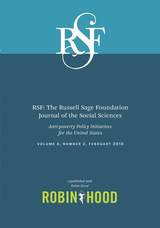 RSF: The Russell Sage Foundation Journal of the Social Sciences: Anti-poverty Policy Initiatives for the United States
Lawrence M. Berger
Russell Sage Foundation, 2018 Note: The catalog copy refers to both issues 2 and 3.
Over 40 million Americans live in poverty with limited opportunities for upward mobility. With an economy characterized by large numbers of unstable and low-wage jobs, a fraying social safety net, and stagnant wages, what public policy reforms might increase the number of low-income families and individuals escaping poverty? This special double issue of RSF, edited by poverty researchers Lawrence M. Berger, Maria Cancian, and Katherine A. Magnuson, includes many innovative, evidence-based anti-poverty policy proposals crafted by leading social science researchers and policy analysts.
The first issue highlights initiatives that restructure tax and transfer programs to extend greater support to low-income families, regardless of work status. H. Luke Shaefer and colleagues would replace the current child tax credit and child tax exemption in the federal income tax with an unconditional universal child allowance. They estimate that this would reduce child poverty by about 40 percent. Maria Cancian and Daniel Meyer propose a new child support initiative that institutes a guaranteed minimum monthly support payment for every child living with a single parent, using public funds to bridge the gap when that amount exceeds what the noncustodial parent can reasonably pay. Sara Kimberlin and colleagues propose a renter’s tax credit in the federal income tax for poor households facing increasing rental costs that would benefit 70 percent of renters struggling with high rents.
The second issue analyzes policies that would reduce the extent of low-wage work by boosting education, training, and access to better jobs. Teresa Eckrich Sommer and colleagues propose expanding the Head Start program to combine parental education, job training, and employment opportunities along with existing early childhood education programs to better serve the needs of both parents and children. Mark Paul and colleagues propose a federal jobs guarantee of full-time employment, at a living wage and with benefits, for all adults seeking work. Diana Strumbos and colleagues propose a national community college program, based on a successful model used by the City University of New York, to provide disadvantaged students who enroll full-time with advising, academic, career, and financial supports.
Together, the policies proposed in this double issue provide an evidence-based blueprint for anti-poverty reforms that would benefit millions of people in need.
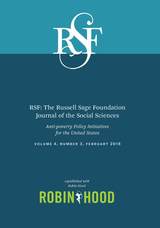 RSF: The Russell Sage Foundation Journal of the Social Sciences: Anti-poverty Policy Initiatives for the United States
Lawrence M. Berger
Russell Sage Foundation, 2018 Note: The catalog copy refers to both issues 2 and 3.
Over 40 million Americans live in poverty with limited opportunities for upward mobility. With an economy characterized by large numbers of unstable and low-wage jobs, a fraying social safety net, and stagnant wages, what public policy reforms might increase the number of low-income families and individuals escaping poverty? This special double issue of RSF, edited by poverty researchers Lawrence M. Berger, Maria Cancian, and Katherine A. Magnuson, includes many innovative, evidence-based anti-poverty policy proposals crafted by leading social science researchers and policy analysts.
The first issue highlights initiatives that restructure tax and transfer programs to extend greater support to low-income families, regardless of work status. H. Luke Shaefer and colleagues would replace the current child tax credit and child tax exemption in the federal income tax with an unconditional universal child allowance. They estimate that this would reduce child poverty by about 40 percent. Maria Cancian and Daniel Meyer propose a new child support initiative that institutes a guaranteed minimum monthly support payment for every child living with a single parent, using public funds to bridge the gap when that amount exceeds what the noncustodial parent can reasonably pay. Sara Kimberlin and colleagues propose a renter’s tax credit in the federal income tax for poor households facing increasing rental costs that would benefit 70 percent of renters struggling with high rents.
The second issue analyzes policies that would reduce the extent of low-wage work by boosting education, training, and access to better jobs. Teresa Eckrich Sommer and colleagues propose expanding the Head Start program to combine parental education, job training, and employment opportunities along with existing early childhood education programs to better serve the needs of both parents and children. Mark Paul and colleagues propose a federal jobs guarantee of full-time employment, at a living wage and with benefits, for all adults seeking work. Diana Strumbos and colleagues propose a national community college program, based on a successful model used by the City University of New York, to provide disadvantaged students who enroll full-time with advising, academic, career, and financial supports.
Together, the policies proposed in this double issue provide an evidence-based blueprint for anti-poverty reforms that would benefit millions of people in need.
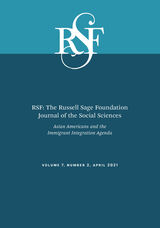 RSF: The Russell Sage Foundation Journal of the Social Sciences: Asian Americans and the Immigrant Integration Agenda
Jennifer Lee
Russell Sage Foundation, 2021 Asian Americans are the fastest growing racial group in the U.S. and the only majority foreign-born group in the country. With immigration fueling most of the growth, Asians are projected to surpass Hispanics as the largest immigrant group by 2055. Yet, “Asian” is a catch-all category that masks tremendous diversity. In this issue of RSF, sociologist Jennifer Lee and political scientist Karthick Ramakrishnan and an interdisciplinary roster of experts present nuanced narratives of Asian American integration that correct biased assumptions and dispel dated stereotypes. The result is an issue that makes an original and vital contribution to social science research on this understudied population.
Rather than treating Asian Americans as a monolithic group, the contributors use the 2016 National Asian American Survey to pinpoint areas of convergence and divergence within the U.S. Asian population. Despite their diversity, Asian Americans share many attitudes, behavior, and experiences in ways that exceed expectations based on socioeconomic status alone— what Lee and Ramakrishnan refer to as the “diversity-convergence paradox.” This paradox — of convergence despite divergence in national origins and socioeconomic status — is the animating question of this issue of RSF.
Contributors Janelle Wong and Sono Shah find strong political consensus within the Asian American population, particularly with regard to a robust government role in setting public policies ranging from environmental protection to gun control to higher taxation and social service provision, and even affirmative action. Wong and Shah posit that political differences within the Asian American community are between progressives and those who are even more progressive. Analyzing where policy opinions converge and diverge, Sunmin Kim finds that while many Asian Americans support government interventions in health care, education, and racial justice, some diverge sharply with regard to Muslim immigration. Lucas G. Drouhot and Filiz Garip construct a novel typology of five subgroups of Asian immigrants spanning class, gender, region, and immigrant generation to examine varied experiences of immigrant inclusion. They show how different subgroups contend with the effects of racialized othering and inclusion simultaneously at play. Van C. Tran and Natasha Warikoo analyze both interracial and intra-Asian attitudes toward immigration and find diversity among Asians’ views by national origin: As labor migrants, Filipinos support Congress increasing the number of annual work visas; as economic migrants, Chinese and Indians support an increase in annual family visas; and as refugees, Vietnamese are least supportive of pro-immigration policies.
Placing Asian Americans at the center of their analyses, the contributors illuminate how such a broadly diverse population shares similar attitudes and experiences in often surprising ways. By turning a lens on the richly diverse U.S. Asian population, this issue of RSF unveils comprehensive, compelling narratives about Asian Americans and advances our understanding of race and immigrant integration in the 21st century.
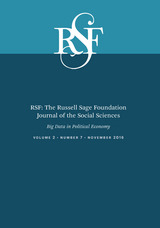 RSF: The Russell Sage Foundation Journal of the Social Sciences: Big Data in Political Economy
Howard Rosenthal
Russell Sage Foundation, 2016 Rapid technological advances since the 1980s have revolutionized data gathering and changed the nature of many day-to-day transactions. Today, nearly every economic and financial transaction is recorded and can be linked to the individuals involved. This proliferation of “big data” makes it possible for economists and political scientists to empirically analyze the spending behavior of far greater numbers of individuals and firms, over much longer periods of time, than ever before. In “Big Data in Political Economy,” edited by Atif Mian and Howard Rosenthal, a group of quantitative researchers explore the possibilities and challenges of this data boom for the social sciences, focusing on how big data can help us gain new insights into such issues as social inequality, political polarization, and the influence of money in politics.
Among other topics, the articles in this issue demonstrate how large-scale data sources can be used to analyze campaign contributions and political participation. Adam Bonica outlines the development of a comprehensive “map” of the American political system that collects, processes, and organizes data on politicians’ campaign finances, policy positions, and voting records, and makes such information available to voters. Drew Dimmery and Andrew Peterson show how web-based data-gathering techniques can augment such a map to include political contributions made by nonprofits, which are often overlooked or not fully transparent. Deniz Igan links campaign contribution data to both policymakers’ voting records and financial institutions’ lending behavior and shows that legislators who were heavily lobbied by institutions engaging in risky lending, such as subprime lenders, were more likely to vote for deregulation. Chris Tausanovitch connects big data on voters’ income and policy preferences to the voting records of their congressional representatives in order to study how effectively the political system represents voters of different income levels. And Sharyn O’Halloran and coauthors discuss how big data can augment traditional observational research by replacing tedious hand coding of volumes of text with automated procedures.
As research in political economy increasingly focuses on the role of money in shaping the outcomes of elections and policymaking, new methods of aggregating and examining financial data have become central. Together, the papers in this volume show how big data provides unprecedented opportunities for social scientists to better understand the links between politics and markets.
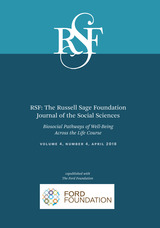 RSF: The Russell Sage Foundation Journal of the Social Sciences: Biosocial Pathways of Well-Being Accross the Life Course
Thomas W. McDade
Russell Sage Foundation, 2018 Poverty, discrimination, and other social and economic inequalities have serious consequences for individuals’ physical and mental well-being. Recently, social scientists have collaborated with biological scientists to better understand the mechanisms that reproduce social stratification within and across generations. In this issue of RSF, edited by anthropologist Thomas McDade and sociologist Kathleen Mullan Harris, and a multi-disciplinary group of scholars integrate theory, data, and methods from the social and biological sciences to advance our understanding of how social and biological processes interact to shape individuals’ health outcomes and life chances.
Several articles explore the effects of disadvantage and discrimination on individuals’ health. Douglas Massey and colleagues find that residential segregation and concentrated poverty—which disproportionately affects African Americans—contribute to more rapid cellular aging, a condition associated with a higher risk of disorders such as diabetes and heart disease. Bridget Goosby and colleagues track the sleep patterns of adolescents and find that compared to their white peers, African American and biracial youth who report experiencing frequent discrimination have worse sleep, which is associated with longer-term negative physical and mental health outcomes.
Other contributors explore the extent to which social and family environments influence biological processes. Yang Qu and colleagues study the cognitive development of Mexican American youth, focusing on the hippocampus, a region of the brain that produces improved memory and learning. They find that teens who were able to navigate between the cultural values of their parents and fitting in with their peers had different hippocampus volume and higher academic achievement. Other researchers explore the relationship between individuals’ genes and their environments. Melinda Mills and colleagues examine the role of genes in reproductive behavior. They find that while social and behavioral factors are strongly associated with when mothers first give birth and how many children they have, genetic factors are related to other fertility traits, such as childlessness and menopause.
The findings in this issue demonstrate the value of integrating the social and biological sciences for understanding how biological mechanisms influence, and are influenced by, socioeconomic conditions and lay the foundation for further advances in biosocial scholarship.
 RSF: The Russell Sage Foundation Journal of the Social Sciences: Black Reparations: Insights from the Social Sciences
William Darity, Jr.
Russell Sage Foundation, 2024 Note the catalog copy pertains to both parts of this double issue:
Slavery in the United States was a brutal, racialized system of forced labor which helped provide the startup capital for the U.S. economy’s meteoric rise. Post-slavery legal race discrimination produced segregation not only the Jim Crow South but also in northern states, where Blacks were denied many benefits of the New Deal that helped lift whites into the middle class. The 60 years since the passage of the Civil Rights Act of 1964 have witnessed mass incarceration, ongoing police killings of unarmed Blacks, continued discrimination in housing, employment, and credit markers, and a persistent devaluation of Black lives. This history of enslavement and discrimination has yielded disastrous intergenerational consequences for Black wealth and socioeconomic well-being, and calls for reparations have gained currency as a way to redress these historical wrongs. This special double issue of RSF brings together the most current social science research and policy options with regard to reparations for Black Americans.
While reparations have been issued to many peoples around the world, including in the U.S., reparations to Black Americans remain highly contested. Contributor Kathryn Anne Edwards and co-authors use case studies of previous reparations policies to offer important insights into the features that might shape reparations policy for Black Americans. Trina Shanks and colleagues argue that the structure of existing child development accounts provides a practical framework for delivering reparations payments to recipients of all ages through structured savings plans that promote asset growth and fiscal autonomy.
The political feasibility of reparations programs will largely depend on public opinion. Jesse Rhodes and colleagues draw on surveys administered between 2021 and 2023 to show that up to 28 percent of White Americans support cash reparations, up from a tiny 4 percent in 2000. Kamri Hudgins and co-authors suggest that public education on racial disparities may increase the feasibility of a reparations program. Thus, education on real-existing racial disparities in intergenerational wealth, income, health, homeownership, and education may prove to be crucial to affect a federal Black reparations program.
This important double issue of RSF employs rigorous social science research to shed new light on one of the most pressing and contentious policy proposals of our times. Engaging the debate over reparations from the past to the present and from the global to the local, this double issue of RSF provides a valuable roadmap to the issues at stake in the Black American reparations movement.
 RSF: The Russell Sage Foundation Journal of the Social Sciences: Black Reparations: Insights from the Social Sciences
William Darity, Jr.
Russell Sage Foundation, 2024 Note the catalog copy pertains to both parts of this double issue:
Slavery in the United States was a brutal, racialized system of forced labor which helped provide the startup capital for the U.S. economy’s meteoric rise. Post-slavery legal race discrimination produced segregation not only the Jim Crow South but also in northern states, where Blacks were denied many benefits of the New Deal that helped lift whites into the middle class. The 60 years since the passage of the Civil Rights Act of 1964 have witnessed mass incarceration, ongoing police killings of unarmed Blacks, continued discrimination in housing, employment, and credit markers, and a persistent devaluation of Black lives. This history of enslavement and discrimination has yielded disastrous intergenerational consequences for Black wealth and socioeconomic well-being, and calls for reparations have gained currency as a way to redress these historical wrongs. This special double issue of RSF brings together the most current social science research and policy options with regard to reparations for Black Americans.
While reparations have been issued to many peoples around the world, including in the U.S., reparations to Black Americans remain highly contested. Contributor Kathryn Anne Edwards and co-authors use case studies of previous reparations policies to offer important insights into the features that might shape reparations policy for Black Americans. Trina Shanks and colleagues argue that the structure of existing child development accounts provides a practical framework for delivering reparations payments to recipients of all ages through structured savings plans that promote asset growth and fiscal autonomy.
The political feasibility of reparations programs will largely depend on public opinion. Jesse Rhodes and colleagues draw on surveys administered between 2021 and 2023 to show that up to 28 percent of White Americans support cash reparations, up from a tiny 4 percent in 2000. Kamri Hudgins and co-authors suggest that public education on racial disparities may increase the feasibility of a reparations program. Thus, education on real-existing racial disparities in intergenerational wealth, income, health, homeownership, and education may prove to be crucial to affect a federal Black reparations program.
This important double issue of RSF employs rigorous social science research to shed new light on one of the most pressing and contentious policy proposals of our times. Engaging the debate over reparations from the past to the present and from the global to the local, this double issue of RSF provides a valuable roadmap to the issues at stake in the Black American reparations movement.
 RSF: The Russell Sage Foundation Journal of the Social Sciences: Building an Open Qualitative Social Science
Kathryn Edin
Russell Sage Foundation, 2024 Note the catalog copy refers to both issues of this double issue of the journal.
In recent decades, the social sciences have struggled to predict, monitor, and understand ongoing social crises. This is due in part to a lack of infrastructure to adequately do so. The American Voices Project (AVP), an experimental public-use platform for collecting qualitative data, was designed to expand the capacity of social science research by complementing existing research methods examining the everyday lives of Americans. The AVP was fielded in 2019-2022 as the country’s first nationally-representative, large-scale, multiple-domain qualitative data collection effort. In this double issue of RSF, sociologists Kathryn J. Edin, Corey D. Fields, David B. Grusky, Marybeth J. Mattingly, Kristen Olson, and Charles Varner, computer scientist Jure Leskovec, and an interdisciplinary group of contributors utilize data from the AVP to determine whether the platform can provide insight into the lives of Americans and address social science’s current shortcomings.
Issue 1 examines Americans’ experiences during the COVID-19 pandemic, identifies and explores emerging crises in the U.S., and includes the first set of classical interpretive studies based on a public-use dataset. Kyle Fee and colleagues find that job loss during the pandemic was associated with declines in financial and mental wellbeing, that expanded safety net programs did not disincentivize work, and that existing survey-based monitoring is missing important pockets of deprivation. Katherine Cramer and colleagues discover a more thoroughgoing “disaffection crisis” than has been appreciated to date, a crisis in which low- and middle-income earners often feel profoundly disconnected from politics and have little confidence in their ability to meaningfully effect change. Josephina Flores Morales shows that healthcare costs – even after recent and ongoing reforms in healthcare – remain insurmountable for many Latinx Americans, who must then rely on family for unexpected medical costs. Brandon A. Jackson finds that higher income gig workers hold surprisingly positive views of platform work as a way to explore their community, while lower income gig workers are less keen and focus on the financial benefits of gig work.
Issue 2 illustrates how the AVP can be used to uncover hidden populations and to explore how some types of crises, mindsets, or sensibilities can have cascading effects that impact multiple areas of people’s lives. Corey M. Abramson and colleagues use the AVP to uncover the population of Americans experiencing physical pain, showing that while pain is very prevalent, it has larger negative effects on the life trajectories of women and those without a college degree than on other groups. James Hiebert and colleagues uncover the large population of individuals who left the labor market due to a health condition and describe their strategies for reducing stigma when explaining why they are no longer working. Shira Zilberstein and colleagues discover that when individuals discuss their lives they feature “agentic moments” in which they can claim agency despite facing constraints that could be seen as limiting choice and agency.
This volume of RSF provides compelling insights into the lives of Americans and convincingly makes the case for building a permanent public-use platform for qualitative research.
 RSF: The Russell Sage Foundation Journal of the Social Sciences: Building an Open Qualitative Social Science
Kathryn Edin
Russell Sage Foundation, 2024 Note catalog copy relates to both issues of this double issue of the journal.
In recent decades, the social sciences have struggled to predict, monitor, and understand ongoing social crises. This is due in part to a lack of infrastructure to adequately do so. The American Voices Project (AVP), an experimental public-use platform for collecting qualitative data, was designed to expand the capacity of social science research by complementing existing research methods examining the everyday lives of Americans. The AVP was fielded in 2019-2022 as the country’s first nationally-representative, large-scale, multiple-domain qualitative data collection effort. In this double issue of RSF, sociologists Kathryn J. Edin, Corey D. Fields, David B. Grusky, Marybeth J. Mattingly, Kristen Olson, and Charles Varner, computer scientist Jure Leskovec, and an interdisciplinary group of contributors utilize data from the AVP to determine whether the platform can provide insight into the lives of Americans and address social science’s current shortcomings.
Issue 1 examines Americans’ experiences during the COVID-19 pandemic, identifies and explores emerging crises in the U.S., and includes the first set of classical interpretive studies based on a public-use dataset. Kyle Fee and colleagues find that job loss during the pandemic was associated with declines in financial and mental wellbeing, that expanded safety net programs did not disincentivize work, and that existing survey-based monitoring is missing important pockets of deprivation. Katherine Cramer and colleagues discover a more thoroughgoing “disaffection crisis” than has been appreciated to date, a crisis in which low- and middle-income earners often feel profoundly disconnected from politics and have little confidence in their ability to meaningfully effect change. Josephina Flores Morales shows that healthcare costs – even after recent and ongoing reforms in healthcare – remain insurmountable for many Latinx Americans, who must then rely on family for unexpected medical costs. Brandon A. Jackson finds that higher income gig workers hold surprisingly positive views of platform work as a way to explore their community, while lower income gig workers are less keen and focus on the financial benefits of gig work.
Issue 2 illustrates how the AVP can be used to uncover hidden populations and to explore how some types of crises, mindsets, or sensibilities can have cascading effects that impact multiple areas of people’s lives. Corey M. Abramson and colleagues use the AVP to uncover the population of Americans experiencing physical pain, showing that while pain is very prevalent, it has larger negative effects on the life trajectories of women and those without a college degree than on other groups. James Hiebert and colleagues uncover the large population of individuals who left the labor market due to a health condition and describe their strategies for reducing stigma when explaining why they are no longer working. Shira Zilberstein and colleagues discover that when individuals discuss their lives they feature “agentic moments” in which they can claim agency despite facing constraints that could be seen as limiting choice and agency.
This volume of RSF provides compelling insights into the lives of Americans and convincingly makes the case for building a permanent public-use platform for qualitative research.
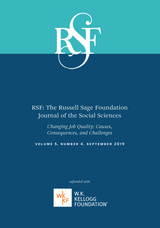 RSF: The Russell Sage Foundation Journal of the Social Sciences: Changing Job Quality: Causes, Consequences, and Challenges
David R. Howell
Russell Sage Foundation, 2019 Over the last forty years, U.S. workers have faced stagnant or falling wages, growing wage inequality, and an increasing incidence of low and poverty-wage jobs. Young workers who lack advanced degrees and workers of color have been the hardest hit. In this issue of RSF, edited by economist David R. Howell and sociologist Arne L. Kalleberg, an interdisciplinary group of contributors analyze the state of job quality, especially for low-wage workers and those in nonstandard work arrangements. Howell and Kalleberg’s introductory article suggests that leading explanations for worsening job quality can be organized into three broad views of the labor market: a competitive market model; a contested markets model, where wage-setting takes place in firms that operate in imperfect markets and where employers have substantial bargaining power; and social-institutional approaches that underscore the importance of social, political, and structural forces.
As a result of technological changes and outsourcing, unpredictable and uncertain work schedules are now widespread. Contributors Cathy Yang Liu and Luísa Nazareno demonstrate that workers in nonstandard employment arrangements earn less and work fewer hours than full-time workers. Susan Lambert, Julia Henly, and Jaesung Kim demonstrate that in addition to the financial insecurity caused by precarious work schedules, those who experience shortfalls in hours are increasingly distrustful of societal institutions. Other contributors examine job quality for women and people of color. David S. Pedulla and Katariina Mueller-Gastell study the rates at which various groups of workers apply for nonstandard jobs, and find that black and Hispanic workers are overrepresented in such positions. Michael Schultz examines mobility out of low-wage work and finds that women and nonwhites are the most entrenched in such jobs. He shows that there is greater mobility out of low-wage work where unions foster the use of job ladders and pay scales.
The issue recommends a slate of policies for creating better jobs, including increasing the federal minimum wage; strengthening collective and individual bargaining, especially through unions; and widening access to health insurance, paid sick and family leave, and childcare. In the absence of family-friendly policies at the federal level, sociologists Rachel Dwyer and Erik Olin Wright propose investments in the “social and solidarity” economy, including NGOs, nonprofit organizations, social enterprises, and worker cooperatives.
Given the centrality of work to human welfare, enhancing the quality of jobs is of urgent concern to workers, employers, and society at large. This issue of RSF helps us better understand the reasons for and consequences of declining job quality and suggests policies that would protect the most vulnerable workers.
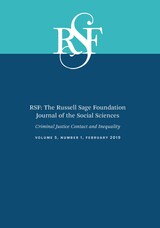 RSF: The Russell Sage Foundation Journal of the Social Sciences: Criminal Justice Contact and Inequality
Kristin Turney
Russell Sage Foundation, 2019 Policymakers and the public are increasingly aware of the dire consequences of mass incarceration for millions of individuals and families. However, incarceration is only one component of the larger criminal justice system. Many more individuals have contact with the criminal justice system through arrests, misdemeanor convictions, and the accumulation of fines and fees, without spending time behind bars. In this issue of RSF, editors sociologist Kristin Turney and criminologist Sara Wakefield and a multi-disciplinary group of authors analyze how the range of criminal justice contact create, maintain, and exacerbate inequalities. Contributors show that the vast scope of the criminal justice system disproportionately targets low-income and minority populations, with serious consequences across the life course.
Several articles explore the ramifications of ongoing surveillance. Amanda Geller and Jeffrey Fagan survey adolescents who come into contact with law enforcement and find that intrusive police stops contribute to heightened cynicism toward the legal system, suggesting that aggressive policing weakens youths’ deference to law and legal authorities. Robert Vargas and coauthors study police-dispatcher radio communications and show that data breaches where the dispatcher reveals confidential identifying information about individuals reporting criminal activity are more common in predominantly black and Latino neighborhoods. Because police scanners are accessible by the public, these breaches make residents more vulnerable to criminals, gangs, or predatory businesses. Other contributors explore the effects of criminal justice contact on family life. Frank Edwards examines how families’ interactions with the child welfare system differ by race and shows that black and Native American families living in counties with high arrest rates are more likely to be investigated for child abuse and neglect than similar families in counties with low arrest rates. For whites, by contrast, poverty—rather than arrests—is the strongest predictor for contact with the child welfare system. In an ethnographic study of bail bond agents, Joshua Page and coauthors find that this industry uses predatory methods to extract bail from the female relatives and partners of incarcerated individuals, increasing financial hardship particularly among low-income women of color.
The criminal justice system is an institution of social stratification in the United States. By documenting how regimes of punishment and surveillance extend far beyond prison, this issue advances our understanding of how social inequalities are perpetuated by a supposedly impartial system.
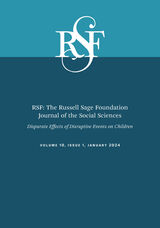 RSF: The Russell Sage Foundation Journal of the Social Sciences: Disparate Effects of Disruptive Events on Children
Jennie E. Brand
Russell Sage Foundation, 2023 Disruptive events such as economic recessions, natural disasters, job loss, and divorce can have a long-lasting impact when experienced during childhood, potentially altering children’s academic achievement, health and development, and later socioeconomic attainment. While much research has considered the overall impact of disruptive events on children’s lives, the consequences of disruption vary across groups. The same disruptive event may have profound negative consequences for some groups, minor or no impact for others, and even present a positive turning point for other groups. In this special issue of RSF, an interdisciplinary group of experts examine the disparate consequences of disruptive events on children.
Drawing on accumulated insights of empirical work from several social science disciplines, including sociology, psychology, and economics, the editors provide a nuanced consideration of theoretical approaches and methodological challenges in identifying unequal impacts. They argue that variation in the effects of disruptive events depends on different, and sometimes offsetting, mechanisms. For example, Martha Bailey and colleagues find that more disadvantaged male youth were less negatively impacted by the macroeconomic shock of the Great Depression than more advantaged youth. Black youth, however, were more negatively impacted. Anna Baranowska-Rataj and colleagues find little evidence that parental job loss leads to worse birth outcomes or that effects vary across regions with different unemployment levels in Sweden, a nation with a relatively generous safety net and universal health care. Regarding the household disruption of parental incarceration, Kristin Turney and colleagues find that some children seamlessly step into new responsibilities, while others, especially older children who had witnessed their fathers’ frequent entanglements with the criminal legal system, consciously step away from these responsibilities. Stefanie DeLuca and colleagues argue that as youth grow accustomed to disruptive events, these exposures become less remarkable and impactful on their life outcomes. Looking at the disruption to education caused by the COVID-19 pandemic, Douglas Harris and colleagues find that \high school graduation has remained remarkably steady since the onset of the pandemic, but entry into two-year colleges was hard hit, especially for colleges serving more people of color and those from low-income families. Finally, considering environmental disruptions, Nazar Khalid and colleagues show that severe floods in India have a stronger impact on the educational outcomes of children from marginalized communities.
Through its systematic examination of the variation in the consequences of disruption, especially in early life, this volume of RSF provides an insightful and practical resource for both researchers and policymakers.
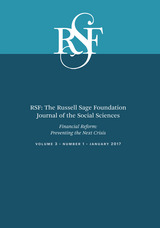 RSF: The Russell Sage Foundation Journal of the Social Sciences: Financial Reform: Preventing the Next Crisis
Michael S. Barr
Russell Sage Foundation, 2017 The 2008 financial crash and the ensuing Great Recession resulted from decades of unconstrained excess and failures of risk management on Wall Street and complacency in Washington. While the 2010 Dodd-Frank Act sought to curtail these abuses, more work remains to be done. This issue of RSF, edited by Michael S. Barr, sets out proposals for comprehensive financial reform. Contributors suggest how to improve financial regulation, make markets more resilient, and increase protections for consumers and investors in order to lower the likelihood of a future crisis.
Several contributors evaluate the Dodd-Frank bill which mandated greater federal oversight of banks, increased regulation of credit rating agencies, and established the Consumer Financial Protection Bureau (CFPB), among other measures. Martin Baily and coauthors conclude that measures that require greater transparency and oversight in derivatives transactions have made financial institutions more resilient. Yet, the bill’s attempts to consolidate the fragmented financial regulatory system have not gone far enough.
Lauren Willis argues that instead of simply issuing disclosures, financial service providers should be required to meet more rigorous performance standards, such as proving through third-party testing that customers understand their fees and surcharges. John Macey advocates reforms that would afford home mortgage borrowers the same protections as investors in the securities market, including regulations that prevent brokers from encouraging borrowers to refinance their mortgages to collect fees.
The issue also addresses global financial regulation. Viral Achara examines the financial sectors in the U.S., Europe, and Asia, and assesses their vulnerability to capital shortfalls in the event of a future crisis. Niamh Moloney finds that institutions established in the wake of the crash, such as the European Supervisory Authorities, have improved European-level prudential and consumer financial regulations and have the potential to increase the EU’s influence in international financial governance.
The effects of the financial crisis continue to reverberate around the world today. Together, the articles in this issue document the steps necessary for creating a more robust financial system that works better for all consumers, investors and the financial system itself.
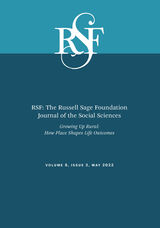 RSF: The Russell Sage Foundation Journal of the Social Sciences: Growing Up Rural: Education, Health, Family, and Economic Outcomes
Shelley Clark
Russell Sage Foundation, 2022 Note copy pertains to both volumes of this double issue:
Nearly 46 million Americans live in rural counties – areas with small populations that are often located far from large cities. Yet we know relatively little about how living in a rural area influences child and adolescent life trajectories and adult outcomes when compared to their urban counterparts. In this special double issue of RSF, sociologist Shelley Clark, epidemiologist Sam Harper, and agricultural economist Bruce Weber, and an interdisciplinary group of contributors provide a comprehensive look at the impact that growing up rural has across the lifespan, examining both the challenges and advantages of growing up in rural America.
The 15 articles in this double issue explore the effects of rural life on family, educational attainment, economic security, and health. Issue 1 looks at the impact of rural families and schools on children’s and adolescents’ educational aspirations and wellbeing. Contributors Jennifer Sherman and Kai A. Schafft find that while rural gentrification brings needed resources to struggling communities, it can also exacerbate educational inequality. Jessica C. Drescher and colleagues reveal that only modest differences in educational outcomes exist between rural and non-rural students overall and that socioeconomic status is less predictive of academic achievement in rural areas compared to non-rural areas. Ryan Parsons shows that rural students with college aspirations, particularly students of color, incur social and emotional costs in pursuing upward mobility not experienced by their urban counterparts, such as having to permanently relocate to more advantaged areas.
Issue 2 examines transitions to adulthood in rural areas and the longer-term influences of growing up in rural areas on adults’ health and economic attainment. Emily Miller and Kathryn Edin find that low-income rural young adults have children and marry earlier than their peers, but achieve other markers of adulthood, such as leaving the parental home, more slowly and often only tentatively. Robert D. Francis shows that rural, working-class men will employ various strategies to improve their employment opportunities in ways that support their identities as rural, working-class men. For example, they pursue additional education and training in fields that will allow them to continue to hold traditionally masculine, working-class jobs, such as obtaining credentials to be truck drivers or mechanics. Evan Roberts and colleagues find that growing up on or moving to a farm were associated with better health outcomes. Emily Parker and colleagues find that rural residents who live in counties that receive a higher amount of federal funding and moved from their home county in adulthood were more likely to achieve higher educational attainment and earnings than those in counties that received less funding.
This volume of RSF provides a more nuanced understanding of the advantages and disadvantage of growing up in rural areas and how it shapes the life trajectories of rural Americans.
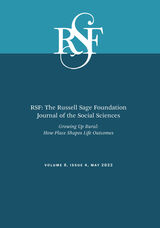 RSF: The Russell Sage Foundation Journal of the Social Sciences: Growing Up Rural: Education, Health, Family, and Economic Outcomes
Shelley Clark
Russell Sage Foundation, 2022 Note copy refers to both issues. This is a double issue.
Nearly 46 million Americans live in rural counties – areas with small populations that are often located far from large cities. Yet we know relatively little about how living in a rural area influences child and adolescent life trajectories and adult outcomes when compared to their urban counterparts. In this special double issue of RSF, sociologist Shelley Clark, epidemiologist Sam Harper, and agricultural economist Bruce Weber, and an interdisciplinary group of contributors provide a comprehensive look at the impact that growing up rural has across the lifespan, examining both the challenges and advantages of growing up in rural America.
The 15 articles in this double issue explore the effects of rural life on family, educational attainment, economic security, and health. Issue 1 looks at the impact of rural families and schools on children’s and adolescents’ educational aspirations and wellbeing. Contributors Jennifer Sherman and Kai A. Schafft find that while rural gentrification brings needed resources to struggling communities, it can also exacerbate educational inequality. Jessica C. Drescher and colleagues reveal that only modest differences in educational outcomes exist between rural and non-rural students overall and that socioeconomic status is less predictive of academic achievement in rural areas compared to non-rural areas. Ryan Parsons shows that rural students with college aspirations, particularly students of color, incur social and emotional costs in pursuing upward mobility not experienced by their urban counterparts, such as having to permanently relocate to more advantaged areas.
Issue 2 examines transitions to adulthood in rural areas and the longer-term influences of growing up in rural areas on adults’ health and economic attainment. Emily Miller and Kathryn Edin find that low-income rural young adults have children and marry earlier than their peers, but achieve other markers of adulthood, such as leaving the parental home, more slowly and often only tentatively. Robert D. Francis shows that rural, working-class men will employ various strategies to improve their employment opportunities in ways that support their identities as rural, working-class men. For example, they pursue additional education and training in fields that will allow them to continue to hold traditionally masculine, working-class jobs, such as obtaining credentials to be truck drivers or mechanics. Evan Roberts and colleagues find that growing up on or moving to a farm were associated with better health outcomes. Emily Parker and colleagues find that rural residents who live in counties that receive a higher amount of federal funding and moved from their home county in adulthood were more likely to achieve higher educational attainment and earnings than those in counties that received less funding.
This volume of RSF provides a more nuanced understanding of the advantages and disadvantage of growing up in rural areas and how it shapes the life trajectories of rural Americans.
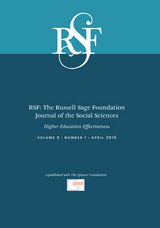 RSF: The Russell Sage Foundation Journal of the Social Sciences: Higher Education Effectiveness
Steven G. Brint
Russell Sage Foundation, 2016 The American system of higher education includes over 5,000 degree granting institutions, ranging from small for-profit technical training schools up to the nation’s elite liberal arts colleges and research universities. Over 20 million students are enrolled, with federal, state, and local governments spending almost 3 percent of GDP on higher education. Yet how can we evaluate the effectiveness of such a large, fragmented system? Are students being adequately prepared for today’s labor market? Is the system accessible to all? Are new business methods contributing to greater efficiency and better student outcomes? In Higher Education Effectiveness, editors Steven Brint and Charles Clotfelter and a group of higher education experts address these questions with new evidence and insights regarding the effectiveness of U.S. higher education.
Beginning with the editors’ authoritative introduction, the contributors assess the effectiveness of U.S. higher education at the national, state, campus, and classroom levels. Several focus on the effects of the steep decline in state funding in recent years, which has contributed to rising tuition at most state universities. Steven Hemelt and David Marcotte find that the financial burdens of attendance, even at public institutions, is a significant and growing impediment for students from low-income families. John Witte, Barbara Wolfe, and Sara Dahill-Brown analyze 36 years of enrollment trends at the University of Wisconsin, Madison, and find increased enrollment of upper-income students, suggesting widening inequality of access.
James Rosenbaum and his coauthors examine the effectiveness of “college for all” policies and find that on a wide range of economic and job satisfaction measures, holders of sub-baccalaureate credentials outperform those who start but do not complete four-year colleges. Two papers – by Kevin Dougherty and coauthors and Michael Kurlaender and coauthors – find that the use of new regulatory mechanisms such as performance funding and rating systems are plagued by unintended consequences that can provide misleading measures of institutional effectiveness. Lynn Reimer and co-authors examine the effectiveness of the “promising practices” in STEM education (science, technology, engineering, and mathematics) promoted by the National Academy of Sciences, and find that they can increase completion rates among low-income, first-generation, and under-represented students.
Expanding college access and effectiveness is a key way to promote economic mobility. The important findings in this issue illuminate the strengths and weaknesses of the U.S. system of higher education and suggest new avenues for improving student outcomes.
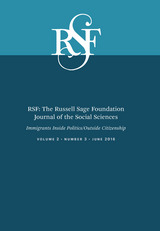 RSF: The Russell Sage Foundation Journal of the Social Sciences: Immigrants Inside Politics/Outside Citizenship
James A. McCann
Russell Sage Foundation, 2016 In recent years, immigration has been an issue in most U.S. national elections, sparking heated debate across the political spectrum. But how do immigrants themselves make sense of and participate in U.S. politics? In this issue of RSF, editors James McCann and Michael Jones-Correa and an interdisciplinary team of leading immigration scholars examine political engagement among Latinos. The eleven articles in this issue analyze data from a survey of the Latino population during the 2012 presidential campaign and focus on the political activity of both native-born and immigrant Latinos—including the undocumented.
Several articles examine the incorporation of the foreign-born into American politics. Katharine Donato and Samantha Perez track differences in Latinos’ political ideologies by gender and find that among new immigrants, women tend to hold more conservative political views than men. However, after living in the U.S. for five years, Latinas report themselves as more liberal; after fifteen years of U.S. residence, Latino men view themselves as more conservative. Frank D. Bean and Susan K. Brown show that due to “membership exclusion”—or significant relegation to the margins of society—undocumented immigrants have less political knowledge than those with green cards or driver’s licenses, regardless of how long they have resided here. Melissa Michelson explores how politicians’ expanded outreach to Latino communities during the 2012 election season helped reverse a decades-long trend of declining trust in the government among Latinos.
Other articles compare the political behavior of Latinos to that of other ethnic groups. Jan Leighley and Jonathan Nagler find that while the demographic patterns central to predicting whites’ political engagement—such as income and education levels—do not predict Latinos’ voting turnout, increased political outreach to Latinos has led to greater turnout. Leonie Huddy, Lily Mason, and Nechama Horwitz find that, similar to African Americans, Latino immigrants who both strongly identify with a minority group (in this case, Hispanic) and perceive discrimination against that group are more likely to align themselves with the Democratic Party.
With Latinos constituting an increasing percentage of the population, understanding how and when they participate in our political system is vital for policymakers, scholars, and advocates. The analyses in this issue of RSF provide contribute to our understanding of how immigrants and their descendants navigate American democracy.
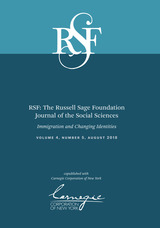 RSF: The Russell Sage Foundation Journal of the Social Sciences: Immigration and Changing Identities
Kay Deaux
Russell Sage Foundation, 2018 Since the 1960s, the United States has undergone a profound demographic transformation due to increased immigration from Asia, Latin America, the Caribbean, and elsewhere. Today immigrants and their U.S.-born children represent approximately 25 percent of the population, or more than 85 million people. How has immigration changed the way that both newcomers and the native-born understand what it means to be American? This issue of RSF, edited by immigration scholars Kay Deaux, Katharine Donato, and Nancy Foner investigates how immigration has shaped the way longer-established Americans, as well as immigrants and their children, see themelves and others in terms of race, ethnicity, and national identity --- and also considers the implications for intergroup relations.
Several articles explore how immigrants negotiate their positions in the racial hierarchy and how they perceive themselves in relation to native-born groups. Michael Jones-Correa and coauthors find that while Mexican immigrants are more likely to identify as Americans the more they report positive interactions with both native-born whites and blacks, Indian immigrants’ identification with being American is largely shaped by positive interactions just with whites. Prema Kurien shows that in response to the wave of hate crimes after 9/11, Sikh Americans sought to be recognized as an American religious minority, as well as an ethnic group distinct from Indian Americans. In their study of the children of immigrants in middle adulthood, Cynthia Feliciano and Rubén G. Rumbaut find that some second-generation immigrants retain a strong attachment to an ethnic identity into their late thirties, but that ethnic identification for others wanes as their social identities as parents, workers, or spouses become more important.
Other contributors investigate the extent to which longer-established Americans respond to increased immigration. Maureen Craig and Jennifer Richeson show that whites living in areas with large or increasing racial minority populations are more likely to believe that anti-white discrimination is on the rise. Deborah Schildkraut and Satia Morotta similarly find that when millennials—particularly those who identify as white and Republican—are exposed to information on the changing racial makeup of the U.S., they express more conservative political views.
At a time when questions of immigration and national identity are at the forefront of our political and public discourse, understanding how immigrants and their offspring influence—and are influenced by—conceptions of race and identity is critical for social scientists. This issue provides key insights into the challenges of a rapidly changing population.
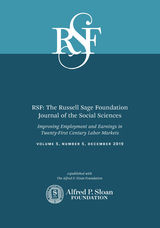 RSF: The Russell Sage Foundation Journal of the Social Sciences: Improving Employment and Earnings in Twenty-First Century Labor Markets
Erica L. Groshen
Russell Sage Foundation, 2019 Modest real wage growth, rising wage inequality, and decreasing labor force participation among less-educated workers have been important labor market trends for several decades. Economists Erica Groshen and Harry Holzer, and a roster of labor market experts present new evidence on the prevalence, causes, and future of these challenges.
Contributors George Borjas and Richard Freeman analyze how the introduction of industrial robots and the influx of immigrants have affected jobs and earnings in the manufacturing industry. They find that the effects of robots are greater than those of immigrants in terms of depressing earnings and reducing employment, suggesting the need for policies that can help workers adjust to automation. Thomas Kochan and William Kimball note the lower density of unions and their declining impact on wages, even as surveys show strong worker preference for union representation and other forms of “voice” regarding wages, compensation, training, and other working conditions.
Informal work, which includes traditional activities like babysitting as well as newer ones like driving for an online platform, is an important means of helping families make ends meet. Katharine Abraham and Susan Houseman show that over a quarter of the workforce hold jobs aside from their main employment, and a higher share of less-educated, minority, low-income, and unemployed workers rely on informal work. Lawrence Katz and Alan Krueger show a modest upward trend in the share of the U.S. workforce in alternative work arrangements over the last twenty years; they also demonstrate that current survey tools miss many instances of multiple job holding.
David Weil demonstrates how the rise of “the fissured workplace”--where businesses outsource key facets of their operations to staffing agencies and other third-party entities--contributes to wage inequality. Contracted workers have lower earnings and fewer opportunities for upward mobility. The U.S. is the only industrialized country that does not provide paid leave for new parents, and low-income families with children spend 30 percent or more of their incomes on childcare expenses. Elizabeth Doran, Ann Bartel, and Jane Waldfogel propose a payroll tax to support family-friendly policies, such as paid leave and child care, as well as modest employer mandates for scheduling control and flexibility.
Editors Groshen and Holzer provide evidence-based policy recommendations that include greater support for public higher education; adjusting federal wage and hour laws as well as those governing labor relations; limiting the effects of past incarceration on workers; and stronger youth employment programs and policies. American workers face many challenges, but there are many policies analyzed in this issue of RSF that hold promise for improving employment and earnings for American workers.
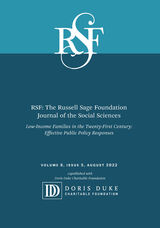 RSF: The Russell Sage Foundation Journal of the Social Sciences: Low-Income Families in the Twenty-first Century: Effective Public Policy Responses
Marcy Carlson
Russell Sage Foundation, 2021 The twenty-first century has seen dramatic shifts in the nature of work, including a decrease in economic security and job opportunities for low-skilled workers. At the same time, the nature of families has also changed significantly, including a delay and decrease in marriage and the development of new types of complex family structures. These changes in work and family have contributed to a rise in inequality, with many lower-income families experiencing poverty and economic hardship as a result. Yet, public policy has not adapted to address these issues. In this issue of RSF, sociologists Marcia J. Carlson, and Christopher Wimer, developmental psychologist Ron Haskins, and an interdisciplinary group of contributors examine the growing needs of low-income families and explore both the extent to which public policy effectively serves them and how it can be improved.
The nine articles in this issue examine various aspects of contemporary work and family life for low-income families, the challenges they face, and whether current policies help to mitigate these challenges. Sigird Luhr and colleagues find that unpredictable work schedules were associated with increased difficulty arranging childcare, work-life conflict, and missed work for working mothers. Elizabeth O. Ananat and colleagues show that Emeryville, California's Fair Workweek Ordinance decreased working parents' schedule unpredictability, and improved their well-being without reducing worker hours. Pamela Joshi and colleagues find that less than a quarter of low-income, full-time working families earn enough to cover a basic family budget, compared to two-thirds of all full-time working families. Katherine M. Michelmore and Natasha V. Pilkauskas reveal that nearly 60% of children in lower-income families reside in households with a complex family structure that may result in difficulty filing for important tax credits like the Earned Income Tax Credit (EITC) that can help increase their incomes. Jennifer Randles shows that income and public aid are insufficient for many mothers to cover the cost of one of children’s basic needs - diapers - and suggests policies to help bridge this gap in the face of widespread economic insecurity.
This volume of RSF illuminates the many obstacles faced by lower-income families due to changes in the labor market and family patterns as well as the ways in which public policy can better respond to alleviate these obstacles.
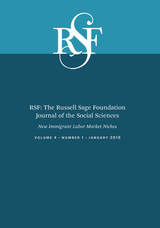 RSF: The Russell Sage Foundation Journal of the Social Sciences: New Immigrant Labor Market Niches
Susan Eckstein
Russell Sage Foundation, 2018 Today there are over 40 million immigrants living in the United States, most of whom come seeking work to improve their earnings and living conditions. Depending on their education and skills, their social networks, government regulations, and other factors, immigrant groups tend to concentrate in specific sectors of the labor market. The articles in this issue of RSF, edited by sociologist Susan Eckstein and economist Giovanni Peri, explore how new immigrant groups navigate the opportunities and constraints presented by various niches in the labor market and how they influence the economic and social fabric of American society.
Several articles survey the history of immigrant labor market niches and how they have affected local economies. Siobhan O’Keefe and Sarah Quincy investigate a labor niche—farming—created by Russian Jews in rural New Jersey in the nineteenth century that revitalized local markets and reduced the outmigration of natives from the area. Zai Liang and Bo Zhou study the occupational niches held by Chinese immigrants from the turn of the century to present day. They show that restaurants have historically provided, and continue to provide, a major source of employment for low-skilled Chinese immigrants and that these immigrants tend to use new job-finding services such as employment agencies and internet advertising. These services have also allowed Chinese-owned restaurants to expand into new geographical locations.
Other contributors analyze the divisions between high and low-skill labor market niches. In his ethnographic study of restaurants in Los Angeles, Eli Wilson finds that Mexican immigrants primarily work “back of the house” jobs performing low-wage manual labor with few opportunities for advancement, while English-speaking whites hold higher-paid “front of the house” jobs interacting with customers. However, bilingual second-generation Latinos are often able to bridge these two roles, increasing their chances for promotions and greater job responsibilities. Yasmin Ortiga explores the effects of programs designed to recruit middle-skill nurses from the Philippines. She finds that because the United States only accepts a certain number of nurses, these programs have contributed to an oversupply of trained nurses in the Philippines and increased joblessness and underemployment there.
Together, the studies in this issue contribute to a deeper understanding of how and why new immigrants gravitate to specific lines of work. They also reveal how these labor niches influence markets both within the United States and abroad.
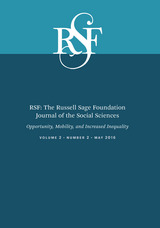 RSF: The Russell Sage Foundation Journal of the Social Sciences: Opportunity, Mobility, and Increased Inequality
Katharine Bradbury
Russell Sage Foundation, 2016 Equality of opportunity—the idea that everyone should have the same chance at success, regardless of family background—has long been a bedrock American belief. Yet, as economic inequality has increased over the last several decades, it has become harder for many to climb the economic ladder. This issue of RSF, edited by Katharine Bradbury and Robert K. Triest of the Federal Reserve Bank of Boston, brings together a distinguished group of the nation’s leading social scientists to examine the extent of and the barriers to opportunity that exist today.
Several contributors investigate how rising inequality in parental investments in children, lack of public resources for low-income families, and the high cost of postsecondary education limit the futures of many. Janet L. Yellen, Chair of the Federal Reserve Board, reviews trends in income and wealth inequality since the 1980s and shows how lack of access to key resources such as high-quality childhood education, affordable college, private business ownership, and inheritances for those in the lower half of the wealth distribution has significantly restricted economic opportunity in the U.S. Isabel Sawhill and Richard Reeves find that the socioeconomic status of one’s parents strongly predicts where one will end up on the income ladder as an adult, particularly for those at the very bottom and top of the income distribution. Timothy Smeeding shows that black men, children of never-married mothers, and children of parents lacking high school diplomas are likely to both begin life in the bottom quartile of the income distribution and remain there as adults.
Other contributors explore how inequality of opportunity begins in childhood, where family conditions and neighborhood quality influence children’s life outcomes. Katherine Magnuson and Greg Duncan show that even prior to kindergarten, low-income children lag behind their affluent peers in math and reading skills, in part because they lack access to high-quality preschool education. Greg Duncan and Richard Murnane find that affluent children’s advantages are further amplified during their school years, in part because their parents invest more time and resources in their educational and extra-curricular activities. They also show that increased residential segregation has led to higher concentrations of children with behavioral problems in low-income areas, which negatively affects their classmates’ ability to learn. Patrick Sharkey reviews research on the correlation between child neighborhood conditions and adult economic outcomes and confirms that the longer low-income children reside in bad neighborhoods, the more their disadvantages are compounded.
This issue of RSF offers new insights into how, despite our persistent belief in the American Dream, economic opportunity and mobility have stagnated for a growing number of citizens.
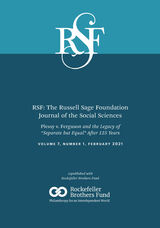 RSF: The Russell Sage Foundation Journal of the Social Sciences: Plessy v. Ferguson and the Legacy of "Separate but Equal" After 125 years
john a. powell
Russell Sage Foundation, 2021 The notorious Supreme Court decision Plessy v. Ferguson made state-sanctioned racial segregation the law of the land in the United States in 1896. While the Civil Rights movement and subsequent Supreme Court decisions in the twentieth century did much to mitigate its effects, its consequences reverberate in ways large and small today. This special volume of RSF revisits the legacy of the decision on its 125th anniversary to consider the connection between constitutionally imposed segregation, institutionalized white supremacy, and enduring racial inequality. Edited by john a. powell, Samuel L. Myers, and Susan T. Gooden – eminent scholars in constitutional law, economics, and public administration respectively – the volume includes contributions from an interdisciplinary roster of experts, each offering fresh insights on the doctrine of “Separate but Equal” as it relates to citizenship, colorism, and civil rights in the United States.
The contributors grapple with a central overarching question: How is it that a court decision from 125 years ago still has such an enduring impact on racial disparities? john a. powell provides a nuanced overview of the legal context of the case to show that segregation was not only about separating people by race but was primarily about preserving White supremacy. The wide latitude for judicial interpretation granted to judges means that who decides matters, and today, just as much as in 1896, the justices sitting on the Supreme Court matter. If the views of Justice Harlan – the lone dissenter in Plessy – had prevailed, U.S. jurisprudence would look very different today.
Thomas J. Davis discusses how control over personal identity lay at the heart of Plessy, and how its denial of basic human rights and fundamental freedoms reverberates today. From sex and marriage to adoption, gender recognition, employment, and voting, persistent discrimination turns in various degrees on state authority to define, categorize, and deny freedom of personal identity. To ensure personal autonomy in such domains requires the continual reevaluation of U.S. law to recognize the freedom of individuals to define and express their own identities.
Looking at enduring educational impact of “Separate but Equal,” which was not entirely rectified by the 1954 decision outlawing school segregation in Brown v. Board of Education, Dania V. Francis and William A. Darity, Jr., link today’s ongoing within-school segregation to the legacy of racialized tracking born from White resistance to desegregation. They demonstrate how a short-term, concerted effort to increase the number of Black high school students taking advanced courses could lead to long-term benefits in closing the educational achievement gap and eliminating institutionalized segregation within our schools.
Plessy rightfully stands as one of the continuing stains on the history of our country in its ambivalence and unwillingness to address White dominance. This issue of RSF both corrects and expands the narrative around the Plessy decision, and provides important lessons for addressing the nation’s continuing racial travails. It is ideal for use by scholars, community leaders, and policy makers alike.
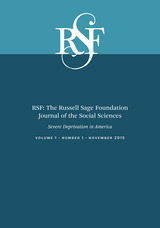 RSF: The Russell Sage Foundation Journal of the Social Sciences: Severe Deprivation in America
Matthew Desmond is associate professor of sociology and social sciences at Harvard University and codirector of the Justice and Poverty Project.
Russell Sage Foundation, 2015 Copy refers to RSF, Volume 1, issues 1 & 2
Widening inequality has received much attention recently, but most of the focus has been on the top one percent or the middle class. The problems of those at the very bottom of society remain largely invisible. Along with the Great Recession, factors such as rising housing costs, welfare reform, mass incarceration, suppressed wages, and pervasive joblessness have contributed to deepening poverty in America. In this inaugural double issue of RSF: The Russell Sage Foundation Journal of the Social Sciences, a distinguished roster of poverty scholars from multiple disciplines focuses on families experiencing “severe deprivation”: acute, compounded, and persistent economic hardship.
Over twenty million families in America live in deep poverty, on incomes below half the federal poverty threshold, yet Liana Fox and colleagues find that government taxes and transfers lift millions of families out of deep poverty each year. Searching even further below the poverty line, Luke Shaefer, Kathryn Edin, and Elizabeth Talbert find that the number of children in households experiencing chronic extreme poverty—living on $2 or less per day—increased by over 240 percent between 1996 and 2012. Focusing on the elderly, Helen Levy shows that failing health exacerbates low-income seniors’ hardship by driving up their out-of-pocket medical spending. Other contributors examine the relationship between violence and severe deprivation.
Through longitudinal interviews with former prisoners in Boston, Bruce Western reveals the ubiquity of violence in the life course of disadvantaged young men. And Laurence Ralph draws on years of ethnography in Chicago to document how families and communities cope with the trauma of gun violence. Other studies in this
issue show that mass incarceration has changed the nature of poverty in recent decades, with consequences ranging from increased levels of deprivation among children of incarcerated parents to housing insecurity among parolees, which increases their risk for recidivism. Finally, several papers devise novel methods and concepts relevant to the study of severe deprivation. Kristin Perkin and Robert Sampson develop an innovative measure of “compounded disadvantage” that groups individual and ecological hardship, while Megan Comfort and colleagues pioneer a new approach to ethnographic fieldwork that combines embedded social work with participant observation.
This issue provides in-depth analyses of the causes and human costs of extreme disadvantage in one of the richest countries in the world and offers a new paradigm for understanding the changing face of poverty in America. In an age of economic extremes, understanding how and why severe deprivation persists will be vital for policymakers and practitioners attempting to deliver relief to the nation’s most marginalized families.
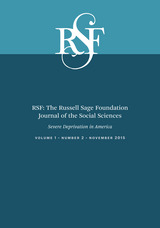 RSF: The Russell Sage Foundation Journal of the Social Sciences: Severe Deprivation in America
Matthew Desmond is associate professor of sociology and social sciences at Harvard University and codirector of the Justice and Poverty Project.
Russell Sage Foundation, 2015 Copy refers to RSF, Volume 1, issues 1 & 2
Widening inequality has received much attention recently, but most of the focus has been on the top one percent or the middle class. The problems of those at the very bottom of society remain largely invisible. Along with the Great Recession, factors such as rising housing costs, welfare reform, mass incarceration, suppressed wages, and pervasive joblessness have contributed to deepening poverty in America. In this inaugural double issue of RSF: The Russell Sage Foundation Journal of the Social Sciences, a distinguished roster of poverty scholars from multiple disciplines focuses on families experiencing “severe deprivation”: acute, compounded, and persistent economic hardship.
Over twenty million families in America live in deep poverty, on incomes below half the federal poverty threshold, yet Liana Fox and colleagues find that government taxes and transfers lift millions of families out of deep poverty each year. Searching even further below the poverty line, Luke Shaefer, Kathryn Edin, and Elizabeth Talbert find that the number of children in households experiencing chronic extreme poverty—living on $2 or less per day—increased by over 240 percent between 1996 and 2012. Focusing on the elderly, Helen Levy shows that failing health exacerbates low-income seniors’ hardship by driving up their out-of-pocket medical spending. Other contributors examine the relationship between violence and severe deprivation.
Through longitudinal interviews with former prisoners in Boston, Bruce Western reveals the ubiquity of violence in the life course of disadvantaged young men. And Laurence Ralph draws on years of ethnography in Chicago to document how families and communities cope with the trauma of gun violence. Other studies in this
issue show that mass incarceration has changed the nature of poverty in recent decades, with consequences ranging from increased levels of deprivation among children of incarcerated parents to housing insecurity among parolees, which increases their risk for recidivism. Finally, several papers devise novel methods and concepts relevant to the study of severe deprivation. Kristin Perkin and Robert Sampson develop an innovative measure of “compounded disadvantage” that groups individual and ecological hardship, while Megan Comfort and colleagues pioneer a new approach to ethnographic fieldwork that combines embedded social work with participant observation.
This issue provides in-depth analyses of the causes and human costs of extreme disadvantage in one of the richest countries in the world and offers a new paradigm for understanding the changing face of poverty in America. In an age of economic extremes, understanding how and why severe deprivation persists will be vital for policymakers and practitioners attempting to deliver relief to the nation’s most marginalized families.
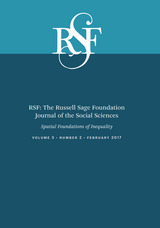 RSF: The Russell Sage Foundation Journal of the Social Sciences: Spatial Foundations of Inequality
George Galster
Russell Sage Foundation, 2017 From school and residential segregation to increased pollution and aggressive policing in low-income neighborhoods, socioeconomic inequality is organized and reinforced through space and place. In this issue of RSF, editors George Galster and Patrick Sharkey and contributors present a new conceptual model for understanding space as one of the foundations of inequality. They bring together empirical research on neighborhoods, schools, and communities to demonstrate the extent to which people’s environments influence their life chances.
Articles in this issue explore the scale and dimensions of spatial inequality. Sean Reardon and coauthors develop a novel method of describing the joint distribution of race and income among neighborhoods. They demonstrate how blacks and Hispanics at all income levels typically live in substantially poorer neighborhoods than whites and Asians of the same income. Ann Owens investigates the relationship between residential segregation and school boundaries and finds that because parents often decide where to live based on school districts, school-age children live in more segregated neighborhoods than adults on the whole. John Hipp and Charis Kubrin examine how changes in the racial, ethnic, and economic composition of the areas that surround a given neighborhood affect it, and find that when inequality rises in a neighborhood’s surrounding areas, crime tends to increase in that neighborhood.
Other contributors study how space serves to maintain or reproduce inequalities. Anna Maria Santiago and coauthors find that neighborhood conditions—including racial and socioeconomic makeup and levels of violent crime—affect the chances that black and Latino youths will engage in risky behaviors, such as running away and using marijuana. For instance, low-income African American youths who live in neighborhoods inhabited by higher status residents are less likely to run away from home. Christopher Browning and coauthors examine the extent to which people of different socioeconomic status share space in their day-to-day lives, including working, shopping, and spending leisure time. They find that families of higher socioeconomic status are less likely to share common spaces with neighbors of any class, in part because they have more choice and control over where they go.
As the articles in this issue show, space is a core dimension of social stratification and is fundamental to understanding social and economic inequality.
|
|
